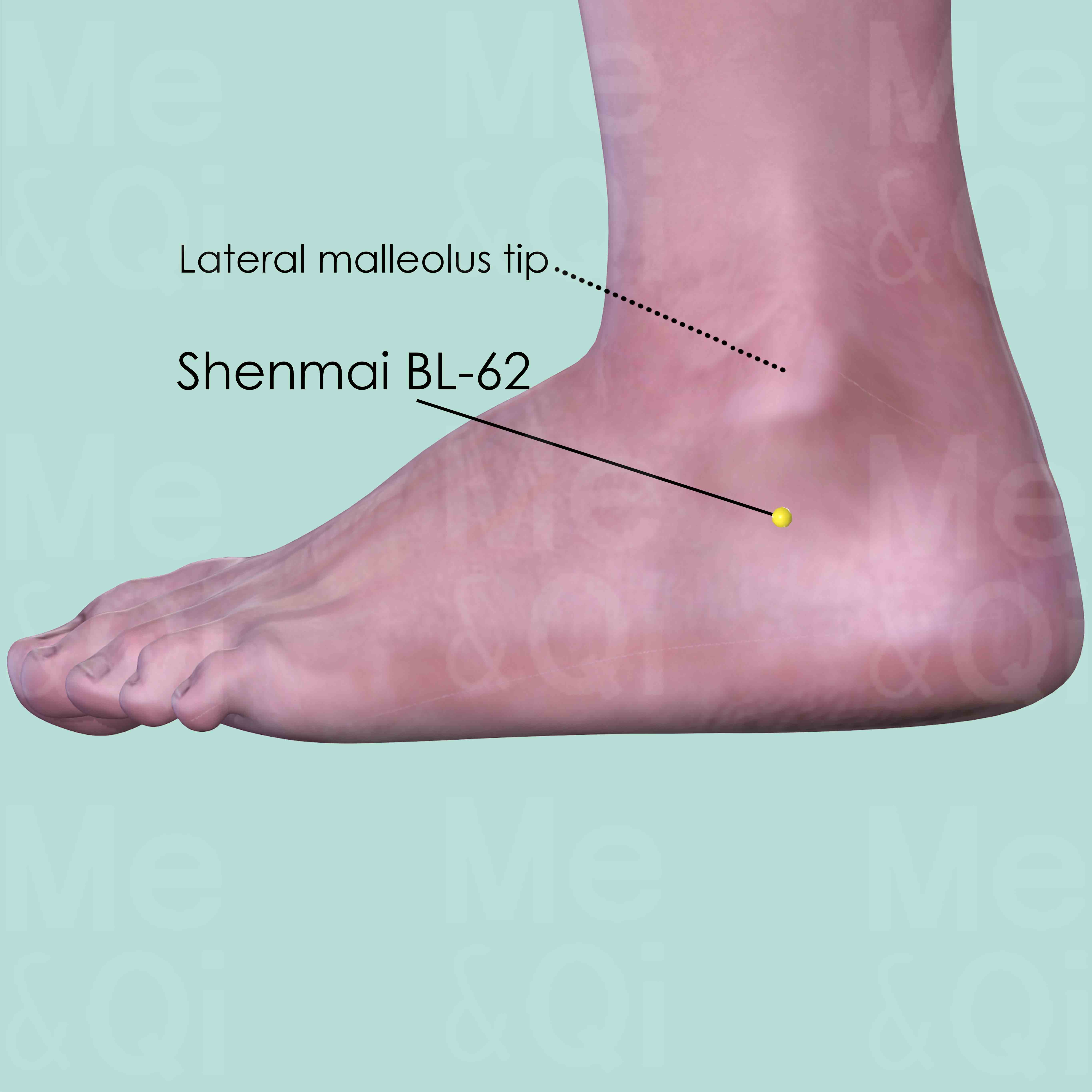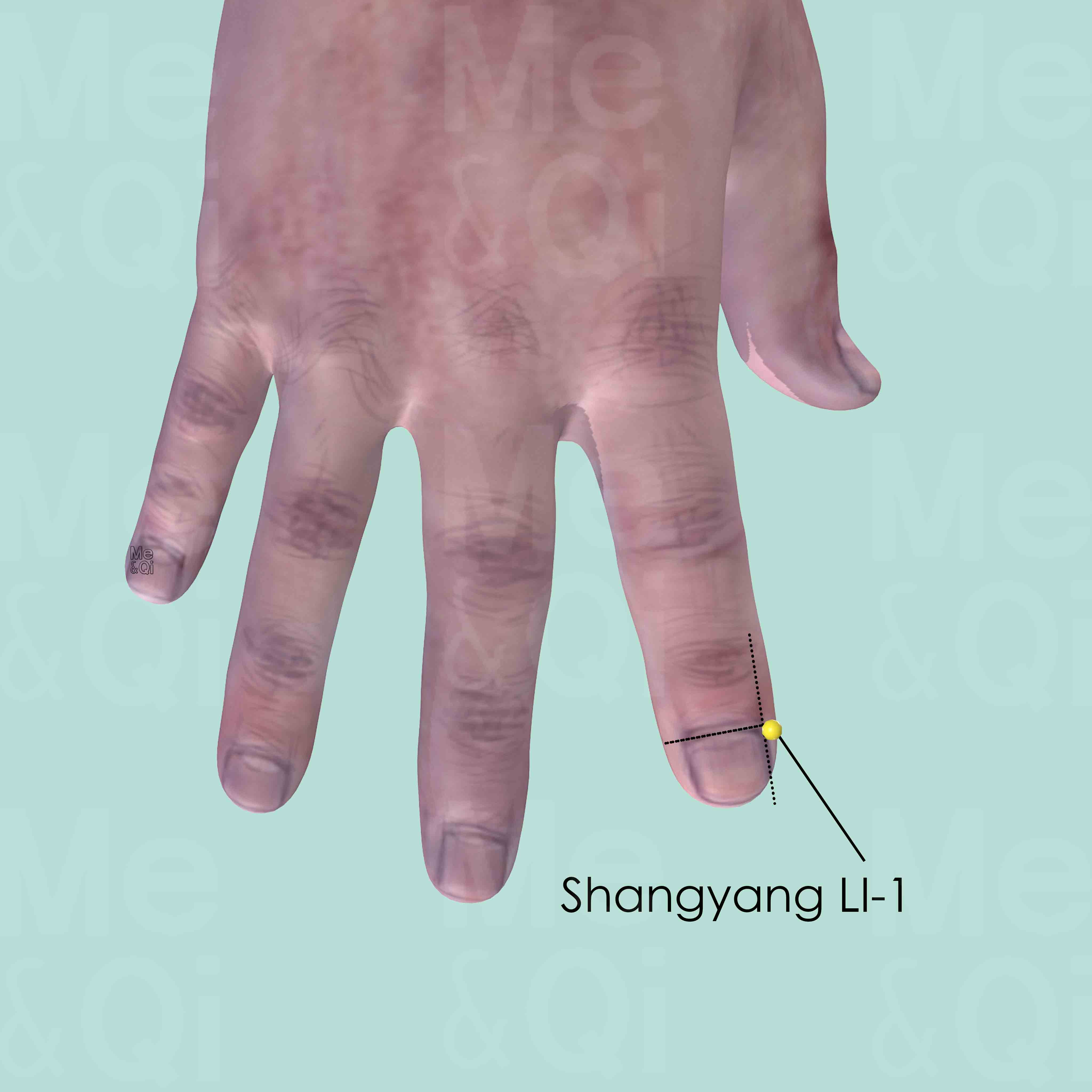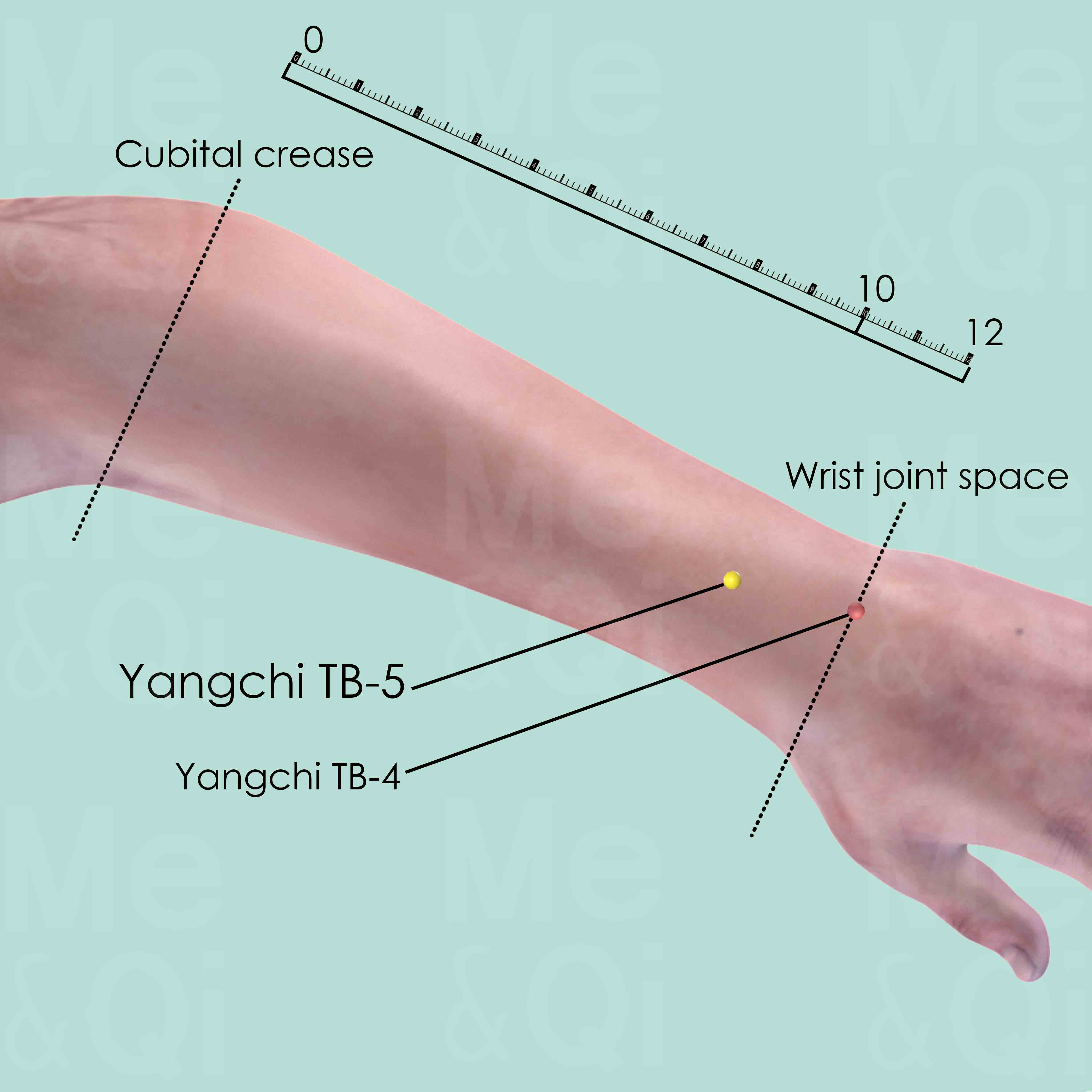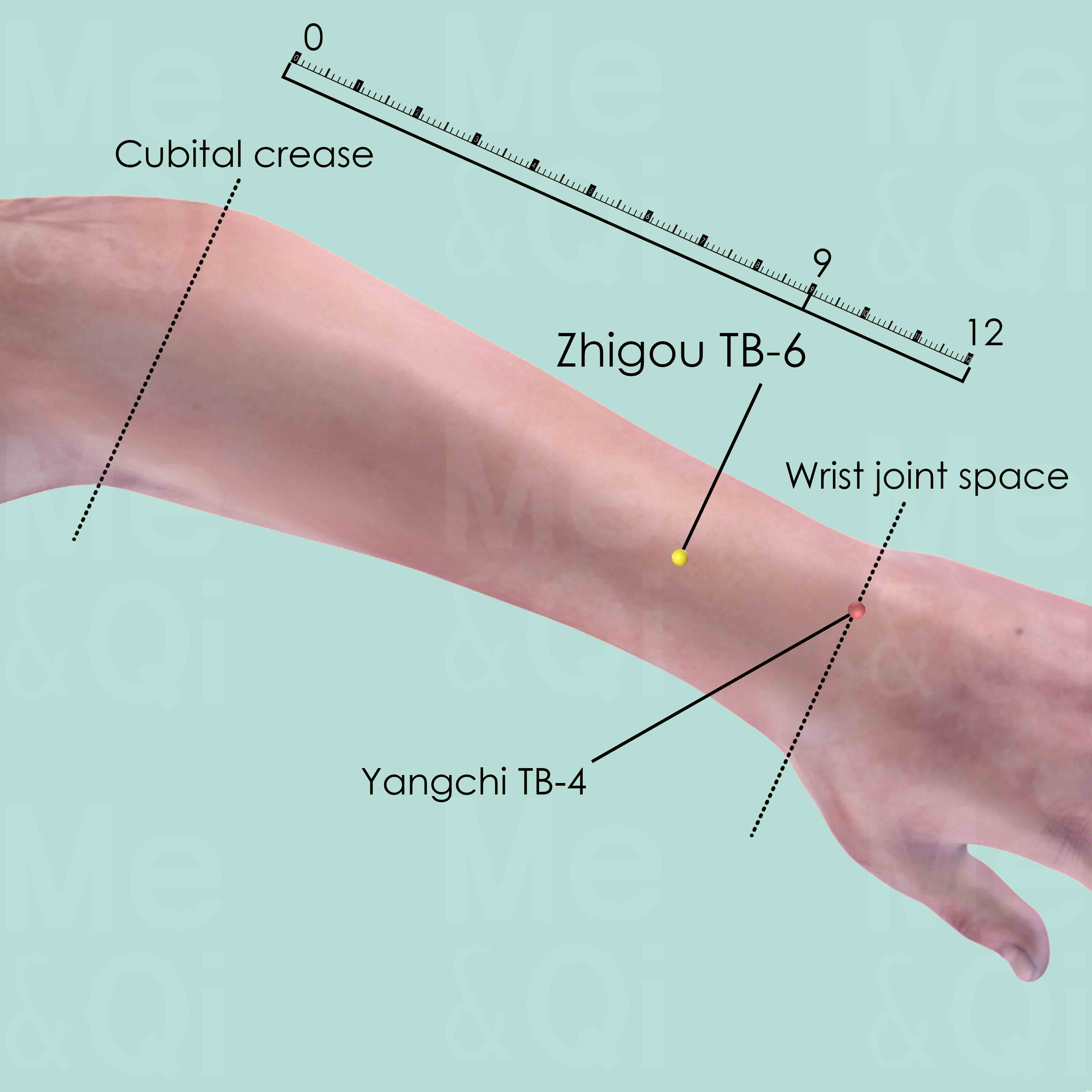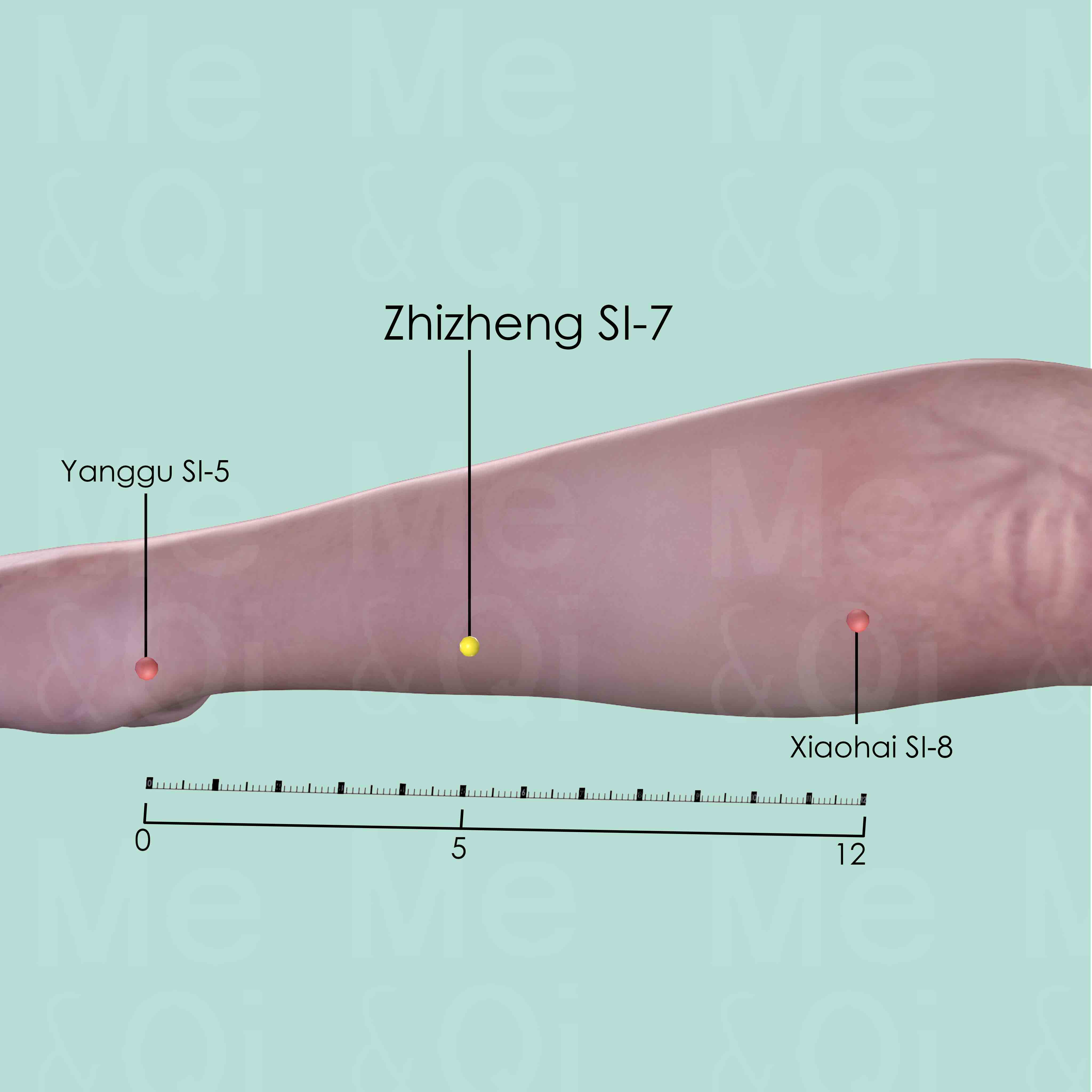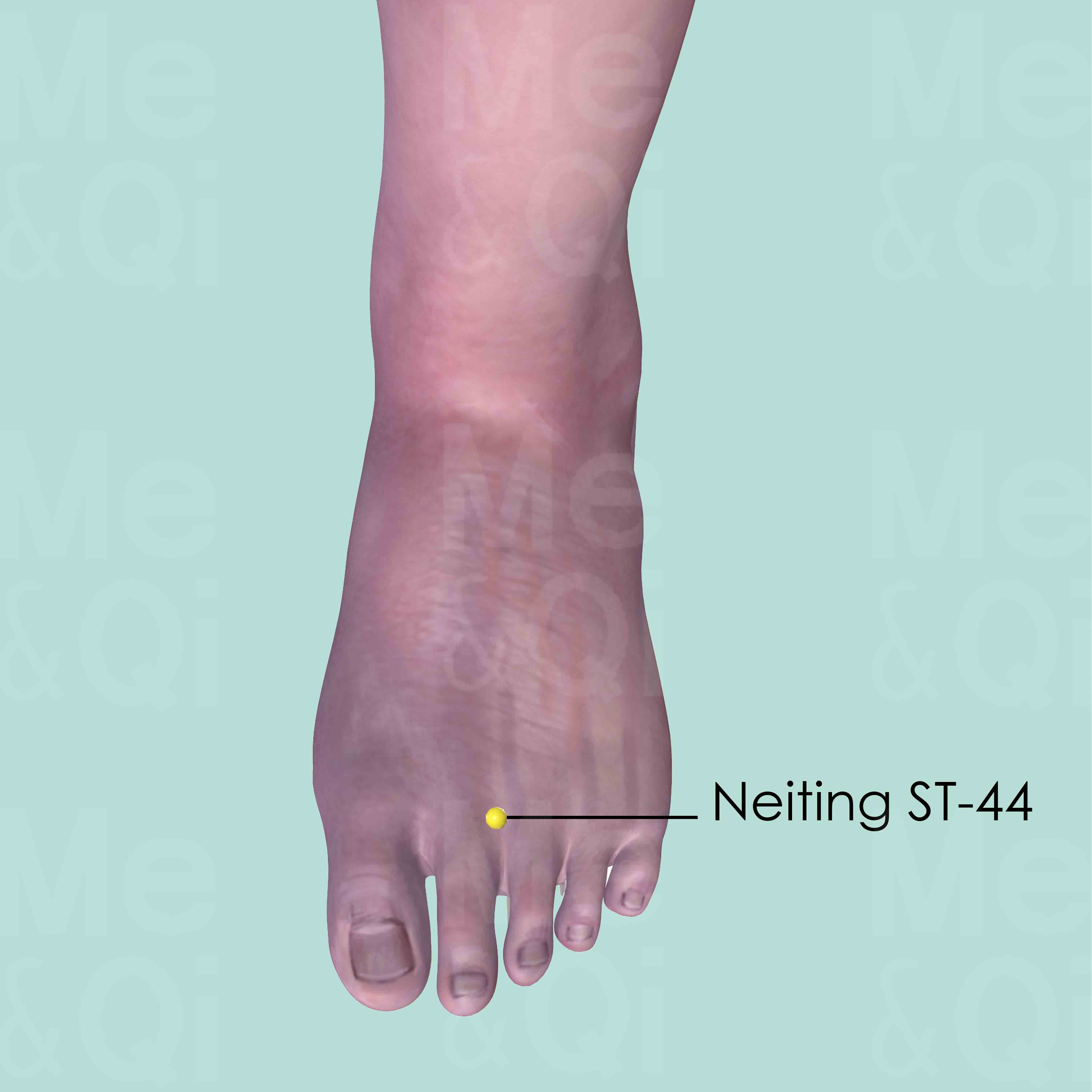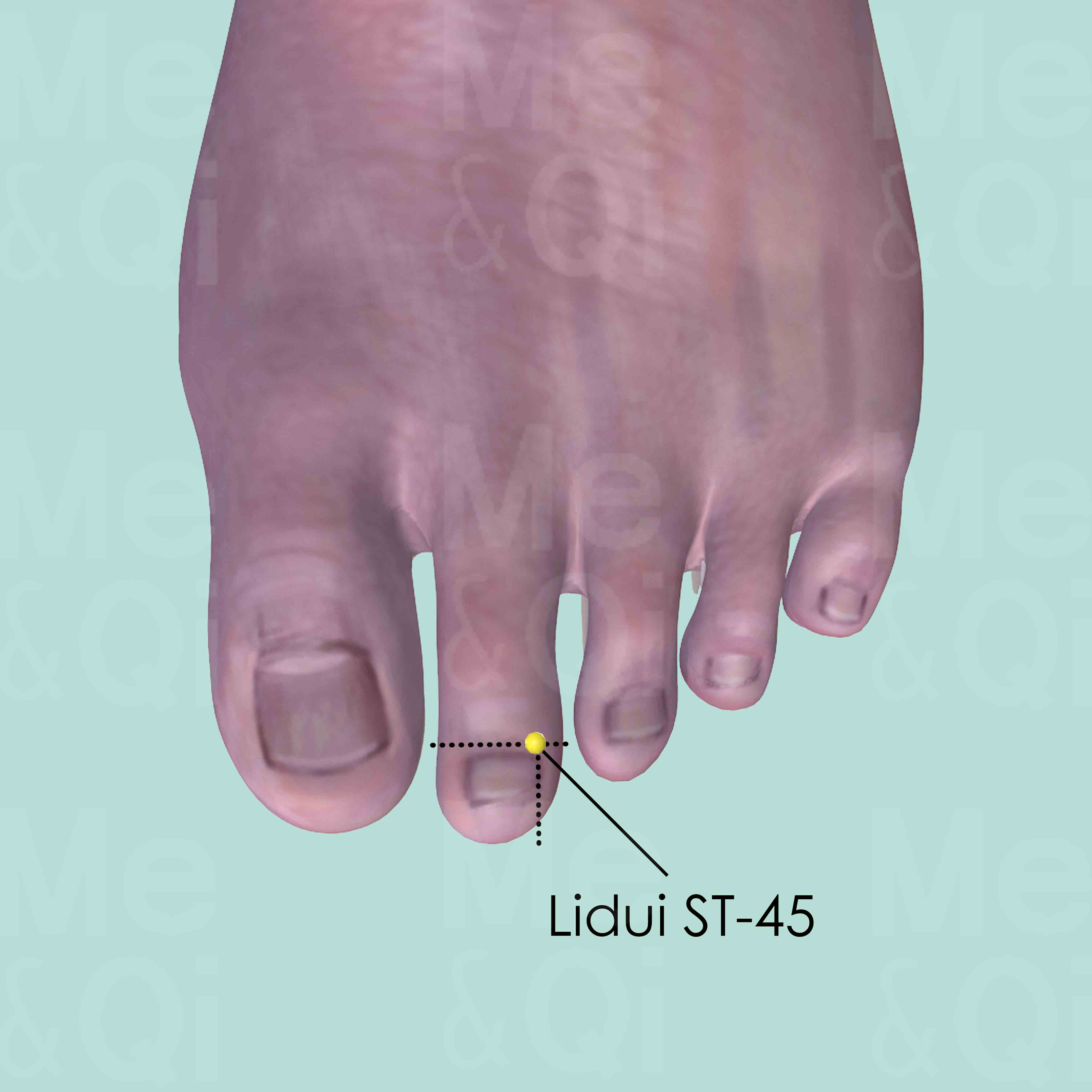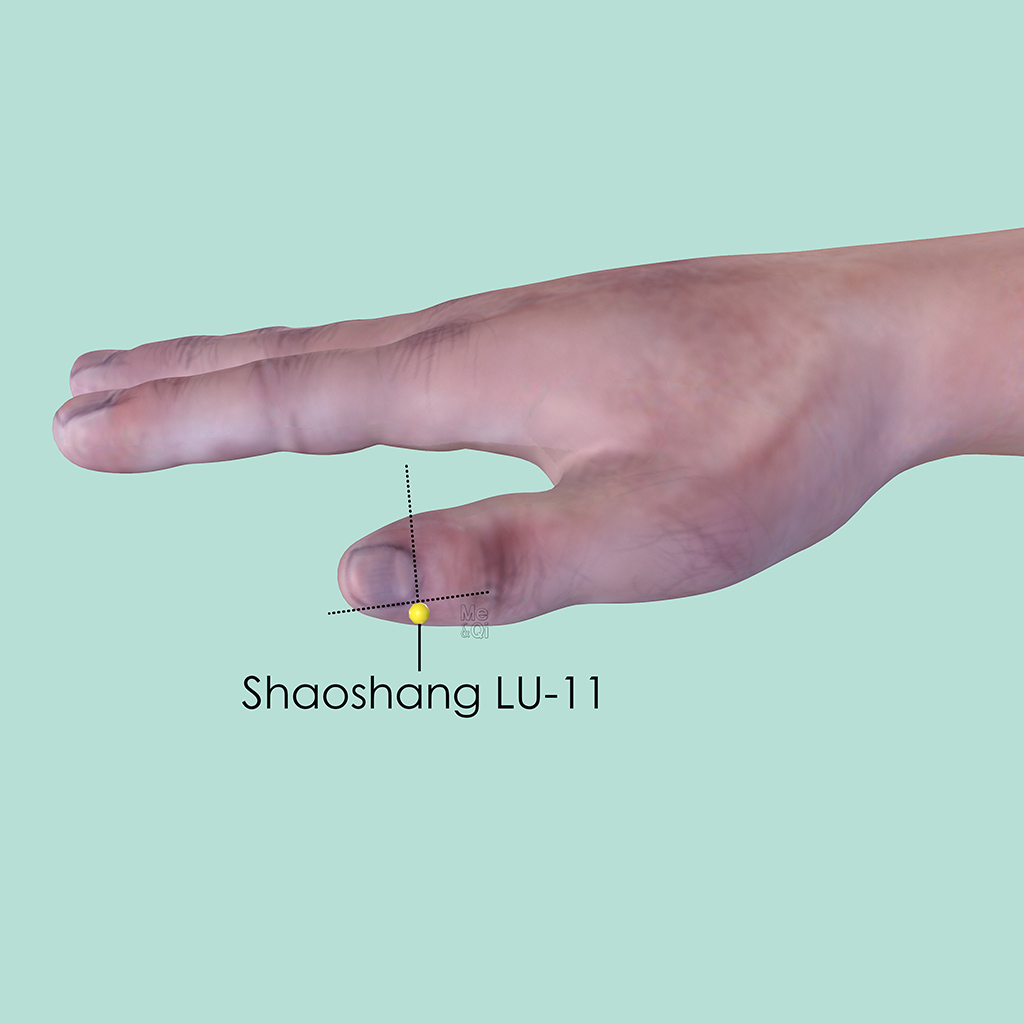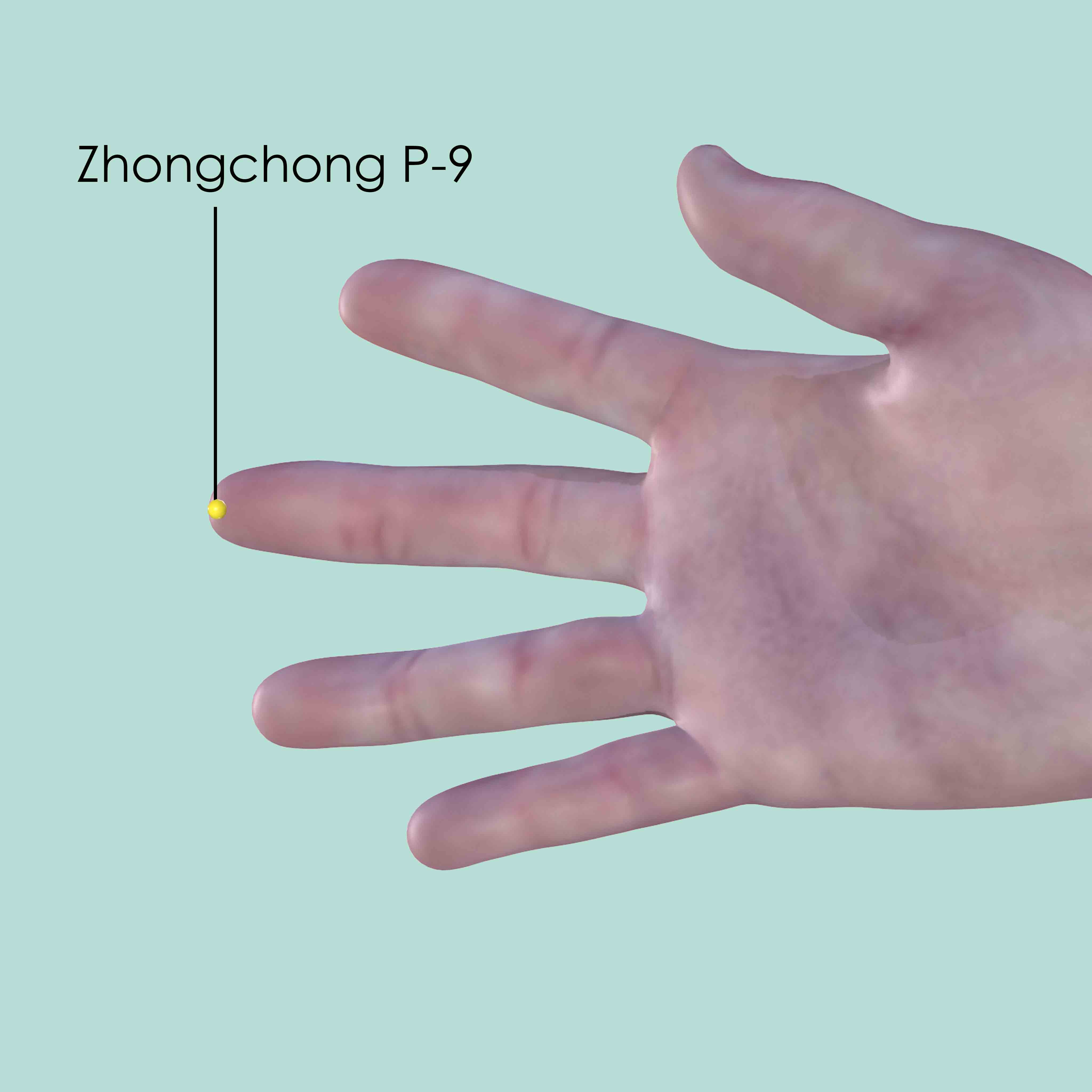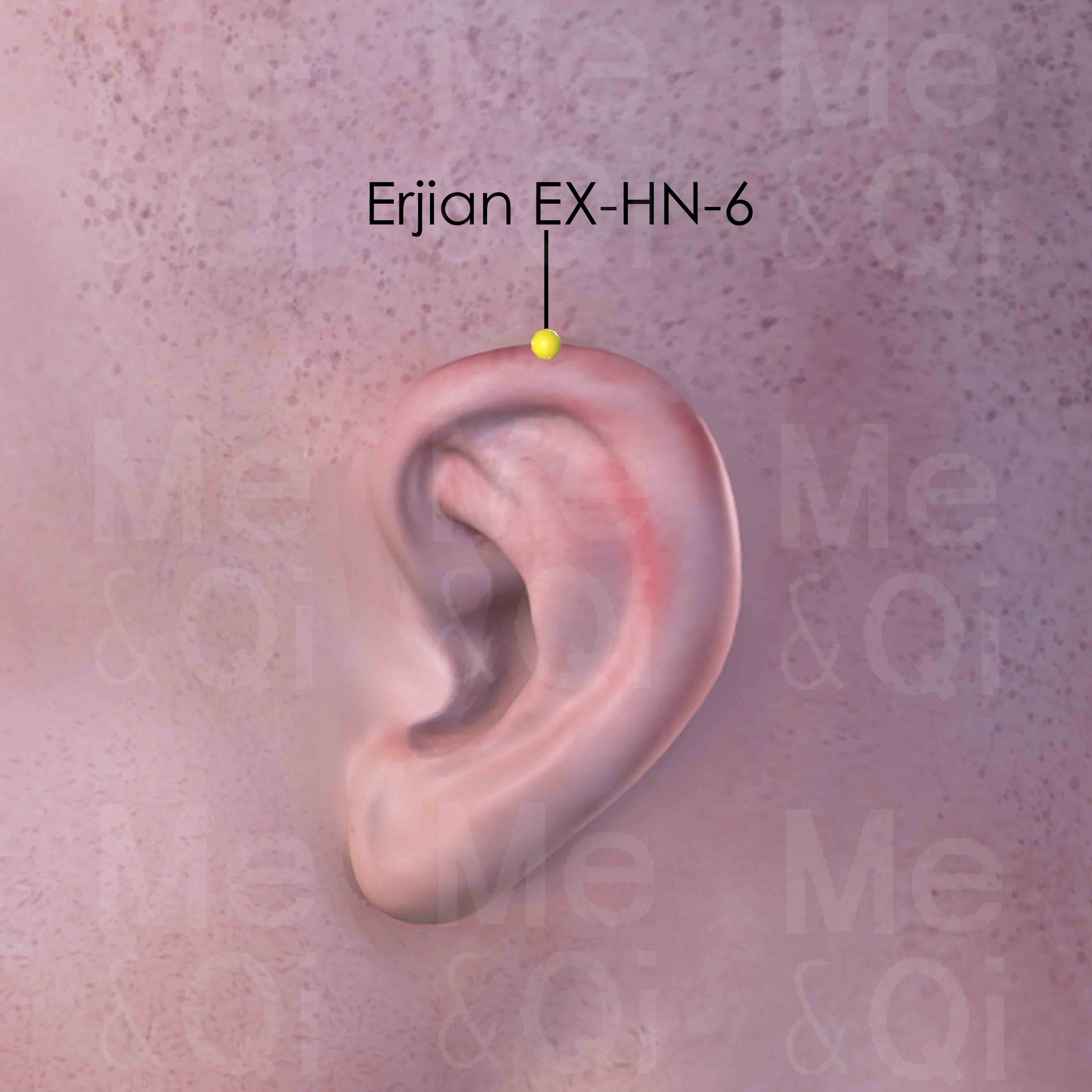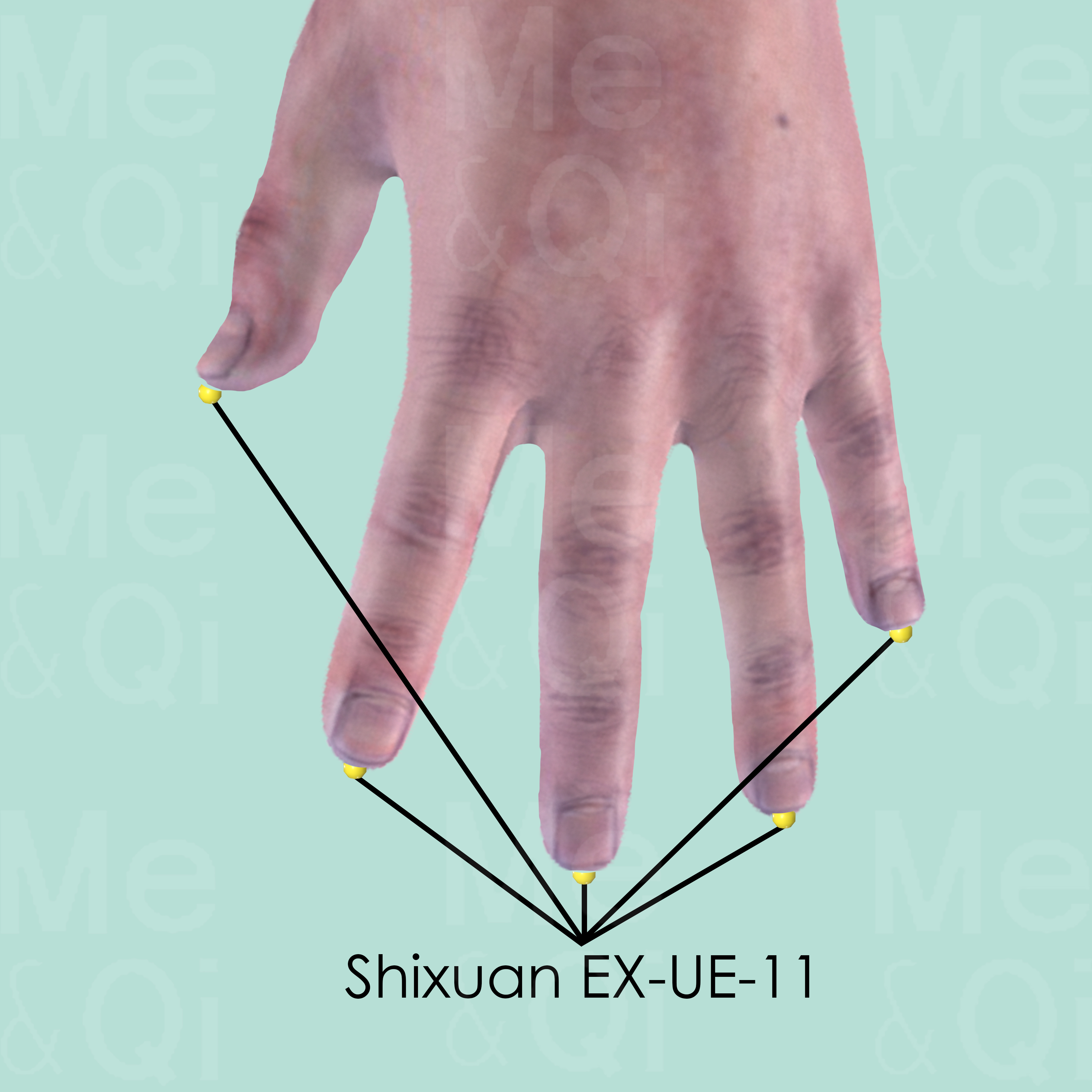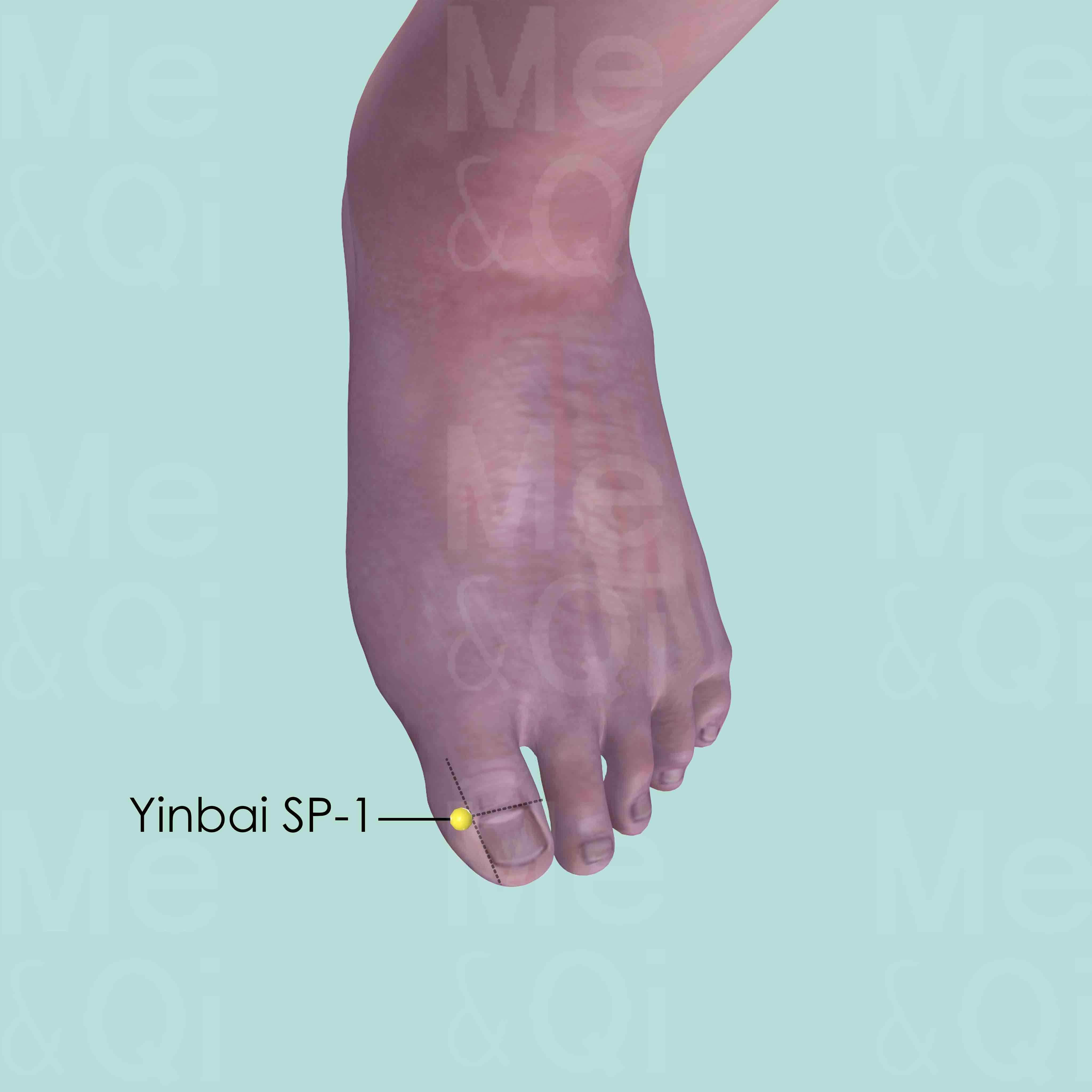Feveraccording to TCM
Symptom family: Fever and Temperature-Related Conditions
Sub-symptom(s): Fever Without Perspiration Low Grade Fever High Fever Typhoid And Paratyphoid Fever Post-injury Fever Puerperal Fever Perimenstrual Fevers Nighttime Fever Common Cold Fever Fever Of Unknown Origin Hemorrhagic Fevers Tidal Fever Fever Not Reduced By Sweating Postpartum Fever Epidemic Hermorrhagic Fever Strong Fever Low Grade Fever In The Afternoon
Root Causes of Fever in TCM
Explore below more details about what might cause Fever according to TCM.
- By Syndrome
- By Organ
- Heat
- Wind
- Cold
- Dampness
- Yin Deficiency
- Qi Deficiency
- Dryness
- Summer Heat
- Qi Stagnation
- Mind Disturbance
- Phlegm
- Yang Excess
- Blood Deficiency
- Yang Deficiency
- Yin Collapse
- Blood Stasis
- View More Causes
- Lung
- Liver
- Stomach
- Spleen
- Kidney
- Pericardium
- Bladder
- Gallbladder
- Large Intestine
- Heart
- Triple Burner
- View More Organs
Heat
In TCM "Heat" signifies an excess of Yang energy, leading to an imbalance where heat predominates over the body's cool Yin aspects. This condition is metaphorically akin to an internal over-heating. Symptoms indicative of Heat can include feelings of warmth, fever, sweating, irritability, red face, thirst with a preference for cold drinks, and a rapid pulse. The tongue may appear red with a yellow coating. Unlike the common interpretation of heat in terms of temperature, in TCM, it represents a state of hyperactivity or inflammation in the body.... see more
Heat Patterns That Can Lead to Fever
Common Symptoms: Thirst Feeling Hot Irritability Restlessness Headaches Feeling Of Heaviness Bitter Taste In The Mouth Scanty And Dark Urine
| Pattern Name | Relevant Symptoms | Relevant Formulas |
|---|---|---|
| Damp-Heat | Fever, Hot body, Neck gland swelling, Headaches, Tight feeling in chest and stomach, Sticky taste in the mouth, Absence of thirst, Feeling hot, Feeling of heaviness, Bitter taste in the mouth, Acne... see more | Huo Xiang Zheng Qi San | Lian Po Yin | Yin Chen Hao Tang | Gan Lu Xiao Du Dan | Er Miao San | Xiao Yao San | Qing Re Tiao Xue Tang |
| Heat in Pericardium | Hot body, Fever at night, Nighttime fever, Delirium, Confusion, Incoherent or confused speech, Cold extremities... see more | Qing Ying Tang | Zhi Bao Dan |
| Damp-Heat in the Bladder | Fever, Frequent and urgent urination, Urinary burning, Urination stopping in the middle of flow, Dark urine, Cloudy urine, Hematuria, Dry mouth without desire to drink, Lower abdominal fullness and pain, Feeling hot... see more | Ba Zheng San |
| Damp-Heat in the Gallbladder | Fever, Hypochondriac pain, Hypochondriac distention, Nausea or vomiting, Fat malabsorption, Dull yellow complexion, Scanty and dark urine, Dry mouth without desire to drink, Bitter taste in the mouth, Dizziness, Tinnitus, Irritability, Feeling of heaviness, Limb numbness, Foot edema, Alternating diarrhea and constipation, Alternating sensation of hot and cold, Yellow sclera... see more | Yin Chen Hao Tang |
| Damp-Heat in the Large Intestine | Fever, Abdominal pain, Abdominal fullness, Diarrhea, Hematochezia, Mucous in feces, Smelly stools, Anal burning, Scanty and dark urine, Perspiration, Feeling hot, Thirst, Feeling of heaviness... see more | Ge Geng Huang Qin Huang Lian Tang | Shao Yao Tang |
| Damp-Heat in the Liver | Fever, Hypochondrial fullness with warmth relief, Abdominal fullness, Lower abdominal fullness, Bitter taste in the mouth, Sticky taste in the mouth, Lack of appetite, Nausea, Feeling of heaviness, Yellow vaginal discharge, Vaginal itching, Vulvar eczema, Vulvar sores, Bleeding between periods, Midcycle bleeding pain, Red and swollen scrotum, Red and swelling genital, Papules, Itchy vesicular rashes, Urinary dysfunction, Urinary burning, Dark urine... see more | Yin Chen Hao Tang | Long Dan Xie Gan Tang |
| Dry-Heat or Dry-Fire | Fever, Thirst, Perspiration, Sore throat, Skin dryness, Dry nose, Dry throat, Dry cough, Aversion to cold, Dry mouth... see more | Xing Su San | Qing Zao Jiu Fei Tang | Sang Xing Tang |
| Early Stage Summerheat with Exterior Wind-Cold | Fever, Chills, Lack of sweating, Headaches, Thirst, Flushed face, Stifling sensation in the chest, Feeling of heaviness, Body pain, Dark urine, Urinary dysfunction... see more | Xin Jia Xiang Ru Yin |
| Exterior-Heat | Fever, Aversion to cold, Perspiration, Thirst, Body pain, Stiff neck | Yin Qiao San | Shi Gao Tang |
| Heat in Lessor Yang | Fever, Bitter taste in the mouth, Abdominal pain, Diarrhea, Sticky taste in the mouth, Malodorous diarrhea, Anal irritation, Upper abdominal burning pain, Tenesmus... see more | Huang Qin Tang |
| Heat in the Blood | Fever, Feeling hot, Red skin eruptions, Thirst, Frequent bleeding, Bloody sputum, Hematochezia, Hematuria, Vomiting blood, Hemoptysis, Nosebleeds, Excessive menstruation... see more | Qing Ying Tang | Xi Jiao Di Huang Tang | Gu Jing Wan | Shi Hui San | Bai He Di Huang Tang | Hua Ban Tang | Qing Re Gu Jing Tang |
| Heat invading the Channels joints and muscles | Fever, Arthralgia, Joints red and hot, Thirst, Anxiety, Anemophobia, Swollen joints, Joint stiffness... see more | Xuan Bi Tang |
| Phlegm-Heat in the Lungs | Fever, Coughing, Shortness of breath, Wheezing, Stifling sensation in the chest, Sputum, Feeling hot, Thirst, Head and body heaviness, Dizziness, Copious thick yellow sputum... see more | Wen Dan Tang | Qing Qi Hua Tan Wan | Ma Xing Shi Gan Tang | Er Chen Tang | Qing Xin Li Ge Tang | Ren Shen Ge Jie San | Pi Pa Qing Fei Yin |
| Toxic-Heat | Fever, Edema, Pus and discharge, Boils, Carbuncles, Pustule, Red skin eruptions, Sore throat, Eczema, Perineum swollen, Prostate swollen, Testicular swelling, Mouth ulcers, Tonsil swelling... see more | Gan Lu Xiao Du Dan | Qing Ying Tang | Bai Hu Tang | Long Dan Xie Gan Tang | Yin Qiao San | Xi Jiao Di Huang Tang | Sang Ju Yin | Huang Lian Jie Du Tang | Xin Yi Qing Fei Yin | Shi Wei Bai Du San | San Zhong Kui Jian Tang | Zi Dang Gao | Er Qing Gao | Bing Peng San | Pu Ji Xiao Du Yin |
| Toxic-Heat Stagnation | Fever, Pustule, Carbuncles, Red skin eruptions, Sore throat, Throat pain, Eczema, Perineum swollen, Prostate swollen, Testicular swelling, Mouth ulcers, Tonsil swelling... see more | Huang Lian Jie Du Tang | Xin Yi Qing Fei Yin |
| Wind-Heat | Fever, Aversion to cold, Sneezing, Coughing, Nasal discharge, Occipital stiffness, Occipital headache, Perspiration, Sore throat, Yellowish phlegm... see more | Xiao Feng San | Yin Qiao San | Sang Ju Yin | Bing Peng San | Pu Ji Xiao Du Yin | Cong Chi Tang | Huo Ren Cong Shi Tang | Jing Jie Lian Qiao Tang | Zhu Ye Cheng Liu Tang | Fang Feng Tong Sheng San |
| Wind-Heat invading the Lungs | Fever, Aversion to cold, Coughing, Sore throat, Congested nose, Nasal discharge, Copious thick yellow sputum, Sneezing, Headaches, Body pain, Thirst, Tonsil swelling... see more | Yin Qiao San |
| Damp-Heat invading the Spleen | Low-grade fever, Lack of appetite, Feeling of heaviness, Dry mouth without desire to drink, Nausea or vomiting, Malodorous diarrhea, Anal burning, Feeling hot, Scanty and dark urine, Dull headache, Dull yellow complexion, Yellow sclera, Oily sweat, Itchy rashes, Bitter taste in the mouth, Upper abdominal fullness, Upper abdominal pain... see more | Lian Po Yin |
| Bright Yang Stomach Heat | High fever, Perspiration, Excessive thirst, Flushed face, Feeling hot, Irritability, Delirium... see more | Bai Hu Tang |
| Heat victorious agitating Blood | High fever, Restlessness, Mania, Macules, Vomiting blood, Nosebleeds, Hematochezia, Hematuria... see more | Xi Jiao Di Huang Tang |
| Heat victorious stirring Wind | High fever, Loss of consciousness, Limb twitching, Convulsions, Stiff neck, Opisthotonos, Eyeballs turning up, Clenching of teeth... see more | Ling Jiao Gou Teng Tang |
| Lung Heat | High fever, Feeling hot, Thirst, Cough with thin yellow sputum, Shortness of breath, Perspiration, Acne... see more | Qing Qi Hua Tan Wan | Ma Xing Shi Gan Tang | Pi Pa Qing Fei Yin | Xie Bai San |
| Liver Wind agitating Internally due to extreme Heat | High temperature, High fever, Convulsions, Stiff neck, Hand tremor, Opisthotonos | Tian Ma Gou Teng Yin | Ling Jiao Gou Teng Tang | Feng Yin Tang |
| Full Heat Yin Deficiency | Fever at night, Nighttime fever, Lack of sweating, Emaciation with no loss of appetite | Qin Jiao Bie Jia San |
| Heat in Nutritive Qi level | Fever at night, Nighttime fever, Dry mouth without desire to drink, Restlessness, Insomnia, Delirium, Incoherent or confused speech, Aphasia, Macules... see more | Qing Ying Tang | Bai He Di Huang Tang |
| Damp-Heat in Stomach and Spleen | Continuous fever which does not reduce with sweating, Head and body heaviness, Upper abdominal oppression, Nausea, Diarrhea, Fever not reduced by sweating... see more | Lian Po Yin | Sheng Yang Yi Wei Tang | Ge Hua Jie Cheng San |
| Wind Cold with Internal Heat | Strong fever, Severe chills, Lack of sweating, Headaches, Feeling of heaviness, General sensation of tightness, Flushed face, Eye hyperemia, Dry nose, Thirst, Irritability, Insomnia, Hemoptysis, Mottled skin... see more | Shi Gao Tang |
| Kidney Yin Deficiency With Empty-Heat Blazing | Low-grade fever in the afternoon, Flushed cheekbones, Restlessness, Insomnia, Night sweats, Heat sensation in palms, Afternoon heat sensation, Evening heat sensation, Scanty and dark urine, Hematuria, Dry throat, Preference for sipping, Dizziness, Tinnitus, Hearing loss, Lower back pain, Nocturnal emission, Hypersexuality, Dry stools... see more | Liu Wei Di Huang Wan | Zhi Bo Di Huang Wan |
| Excess-Heat | Fever, Flushed face, Red skin eruptions, Mottled skin, Irritability, Thirst, Arthritis, Constipation, Scanty and dark urine, Lupus... see more | Xi Jiao Di Huang Tang |
| Stomach Fire or Stomach Heat | Fever, Toothache, Headaches, Stomatitis, Periodontitis, Glossitis, Trigeminal neuralgia, Diabetes, Viral myocarditis, Breast engorgement, Breast lumps... see more | Gua Lou San |
| Heat invading the Pericardium | Fever, Irritability, Restlessness, Feeling of uneasiness, Incoherent or confused speech, Loss of consciousness, Viral encephalitis, Meningitis, Pertussis, Measles induced pneumonia, Aphthous stomatitis... see more | Niu Huang Qing Xin Wan |
| Painful Obstruction due to Damp Heat in Channels | Fever, Heat and pain in the joints, Difficulty in moving, Chills, Scanty and dark urine, Dull yellow complexion, Rheumatic fever, Rheumatoid arthritis, Gouty inflammation, Connective tissue disorders... see more | Xuan Bi Tang |
| Exterior Cold invading with Interior Heat from Stagnation | Severe fever and chills without sweating, Fever without perspiration, Body pain, Thirst, Irritability, Upper respiratory tract infections, Influenza, Purulent keratitis, Viral conjunctivitis, Sinusitis, Bronchial asthma... see more | Da Qing Long Tang |
| Wind-Heat entering the Lungs | Slight fever, Cough with foul smelling sputum, Low grade fever, Mild chest pain, Dry and scaly skin, Bronchitis, Bronchiectasis, Pneumonia, Pertussis, Bronchial asthma... see more | Wei Jing Tang |
| Empty-Heat caused by Yin Deficiency | Night fever, Tidal fever, Nighttime fever, Emaciation, Chronic pyelonephritis, Pulmonary tuberculosis, Renal tuberculosis, Hot palms and soles, Red skin eruptions, Night sweats, Generalized fatigue, Irritability... see more | Qing Hao Bie Jia Tang |
| Heat and Blood Stagnation in the Lower Burner | Night fever, Lower abdominal pain, Nighttime fever, Incoherent or confused speech, Irritability, Restlessness, Thirst, Amenorrhea, Menstrual cramps, Uterine fibroids, Retained placenta... see more | Tao He Cheng Qi Tang |
| Liver Qi Stagnation with Spleen Qi Deficiency that transforms into Heat | Tidal fever, Irritability, Spontaneous sweat, Eye hyperemia, Dry mouth, Palpitations, Lower abdominal oppression, Painful urination, Excessive menstruation, Abnormal uterine bleeding, Infertility... see more | Jia Wei Xiao Yao San |
Wind
In TCM "Wind" is a concept that represents a pattern of disharmony, often characterized by its sudden and unpredictable nature, much like a gusty wind changing direction without warning. This pattern is associated with symptoms that come and go quickly or move around the body, such as itching, tremors, or even certain types of pain. Wind is considered to be a primary cause of illnesses that have these rapidly changing characteristics. In TCM, external Wind often refers to illnesses that start suddenly, like the common cold, believed to be caused by external pathogenic factors like climatic changes. On the other hand, internal Wind can be linked to internal imbalances and can manifest in conditions like dizziness or spasms. ... see more
Wind Patterns That Can Lead to Fever
Common Symptoms: Headaches Aversion To Cold Sneezing Coughing Body Pain Lack Of Sweating Nasal Discharge Stiff Neck
| Pattern Name | Relevant Symptoms | Relevant Formulas |
|---|---|---|
| Damp-Wind | Fever, Aversion to cold, Neck gland swelling, Nausea, Perspiration, Occipital stiffness, Body pain, Muscle pain, Feeling of heaviness, Swollen joints... see more | Qiang Huo Sheng Shi Tang | Jiu Wei Qiang Huo Tang | Cang Er Zi San | Xiao Feng San | Ku Shen Tang | Hai Tong Pi Tang |
| Early Stage Summerheat with Exterior Wind-Cold | Fever, Chills, Lack of sweating, Headaches, Thirst, Flushed face, Stifling sensation in the chest, Feeling of heaviness, Body pain, Dark urine, Urinary dysfunction... see more | Xin Jia Xiang Ru Yin |
| Exterior Wind | Fever, Aversion to cold, Headaches, Anemophobia, Nasal discharge, Clear sputum, Itchy throat, Sneezing, Coughing, Muscle pain, Itchy skin... see more | Chuan Xiong Cha Tiao San |
| Greater Yang Accumulation of Water | Fever, Aversion to cold, Urinary retention, Slight thirst, Vomiting after eating | Wu Ling San |
| Interior Wind | Fever, Convulsions, Hand tremor, Dizziness, Paralysis, Coma, Tic disorder, Mouth deviation, Eye deviation, Tremors, Headaches, Limb numbness... see more | Tian Ma Gou Teng Yin | Ling Jiao Gou Teng Tang | Liu Wei Di Huang Wan | Qi Ju Di Huang Wan | E Jiao Ji Zi Huang Tang | Zhen Gan Xi Feng Tang | Bu Gan Tang | Si Wu Tang |
| Wind-Cold | Fever, Aversion to cold, Sneezing, Coughing, Nasal discharge, Occipital headache, Occipital stiffness, Congested nose, White and watery sputum... see more | Jiu Wei Qiang Huo Tang | Ma Huang Tang | Jing Fang Bai Du San | Cong Chi Tang | Huo Ren Cong Shi Tang | Jia Wei Xiang Su San | Shi Shen Tang | Jin Fei Cao San | Wu Ji San |
| Wind-Cold invading the Lungs | Fever, Aversion to cold, Itchy throat, Shortness of breath, Congested nose, Nasal discharge, Sneezing, Headaches, Body pain, White and watery sputum, Coughing and wheezing with copious sputum... see more | Ma Huang Tang | Ge Gen Tang | Xin Yi San | Zhi Sou San |
| Wind-Cold-Water invading the Lungs | Fever, Ocular swelling, Shiny complexion, Scanty clear urination, Coughing, Shortness of breath, Aversion to cold, Facial edema... see more | Xiao Qing Long Tang |
| Wind-Heat | Fever, Aversion to cold, Sneezing, Coughing, Nasal discharge, Occipital stiffness, Occipital headache, Perspiration, Sore throat, Yellowish phlegm... see more | Xiao Feng San | Yin Qiao San | Sang Ju Yin | Bing Peng San | Pu Ji Xiao Du Yin | Cong Chi Tang | Huo Ren Cong Shi Tang | Jing Jie Lian Qiao Tang | Zhu Ye Cheng Liu Tang | Fang Feng Tong Sheng San |
| Wind-Heat invading the Lungs | Fever, Aversion to cold, Coughing, Sore throat, Congested nose, Nasal discharge, Copious thick yellow sputum, Sneezing, Headaches, Body pain, Thirst, Tonsil swelling... see more | Yin Qiao San |
| Wind-Cold-Damp invading with Qi Deficiency | Severe fever and chills without sweating, High fever, Fever without perspiration, Headaches, Neck pain, Stiff neck, Painful extremities, Focal distention, Chest distension, Congested nose, Noisy breathing, Coughing... see more | Ren Shen Bai Du San |
| Greater Yang Attack of Wind | Slight fever, Slight aversion to cold, Anemophobia, Low grade fever, Mild sweating, Stiff neck, Sneezing, Occipital headache... see more | Gui Zhi Tang |
| Wind-Cold invading with Yang Deficiency | Slight fever, Low grade fever, Severe chills, Exhaustion, Hypersomnia, Cold extremities, Lumbar pain, Lower back pain, Lower back coldness, General cold feeling, Lack of sweating, Headaches, Weak voice... see more | Ma Huang Xi Xin Fu Zi Tang | Zai Zao San |
| Empty-Wind agitating in the Interior | Low-grade fever, Hand tremor, Weight loss, Flushed cheekbones, Low energy, Limb twitching | Zhen Gan Xi Feng Tang |
| Bright Yang Stomach Heat | High fever, Perspiration, Excessive thirst, Flushed face, Feeling hot, Irritability, Delirium... see more | Bai Hu Tang |
| Heat victorious stirring Wind | High fever, Loss of consciousness, Limb twitching, Convulsions, Stiff neck, Opisthotonos, Eyeballs turning up, Clenching of teeth... see more | Ling Jiao Gou Teng Tang |
| Liver Wind agitating Internally due to extreme Heat | High temperature, High fever, Convulsions, Stiff neck, Hand tremor, Opisthotonos | Tian Ma Gou Teng Yin | Ling Jiao Gou Teng Tang | Feng Yin Tang |
| Wind Cold with Internal Heat | Strong fever, Severe chills, Lack of sweating, Headaches, Feeling of heaviness, General sensation of tightness, Flushed face, Eye hyperemia, Dry nose, Thirst, Irritability, Insomnia, Hemoptysis, Mottled skin... see more | Shi Gao Tang |
| Wind-Heat entering the Lungs | Slight fever, Cough with foul smelling sputum, Low grade fever, Mild chest pain, Dry and scaly skin, Bronchitis, Bronchiectasis, Pneumonia, Pertussis, Bronchial asthma... see more | Wei Jing Tang |
Cold
In TCM "Cold" as a pattern of disharmony refers to a specific type of imbalance within the body's systems, often linked to a deficiency or weakness. It's not about feeling physically cold or having a common cold, but rather a metaphorical description of certain symptoms and underlying conditions. When a TCM practitioner says someone suffers from "Cold," it usually implies that the body's Yang energy, which is warm and active, is insufficient or overpowered by Yin energy, which is cool and passive. Symptoms of Cold in TCM can include a general feeling of coldness, cold limbs, pale complexion, low energy, slow metabolism, and a preference for warmth. ... see more
Cold Patterns That Can Lead to Fever
Common Symptoms: Lack Of Sweating Headaches Chills Aversion To Cold Body Pain Nasal Discharge Sneezing Coughing
| Pattern Name | Relevant Symptoms | Relevant Formulas |
|---|---|---|
| Damp-Cold | Fever, Mouth ulcers, White and watery sputum, Nasal discharge, Sneezing, Chills, Abdominal pain, Cold extremities, Arthralgia, Diarrhea, Feeling of heaviness... see more | Wei Ling Tang |
| Dry-Cold | Fever, Headaches, Aversion to cold, Skin dryness, Lack of sweating, Dry mouth, Dry throat, Coughing, Scanty sputum... see more | Xing Su San |
| Early Stage Summerheat with Exterior Wind-Cold | Fever, Chills, Lack of sweating, Headaches, Thirst, Flushed face, Stifling sensation in the chest, Feeling of heaviness, Body pain, Dark urine, Urinary dysfunction... see more | Xin Jia Xiang Ru Yin |
| Exterior-Cold | Fever, Aversion to cold, Body pain, Stiff neck, Lack of sweating, Absence of thirst, Feeling hot, Chills... see more | Ma Huang Tang | Gui Zhi Tang |
| Wind invading the Channels joints and muscles | Fever, Arthralgia, Anemophobia | Da Fang Feng Tang | Xiao Huo Luo Dan |
| Wind-Cold | Fever, Aversion to cold, Sneezing, Coughing, Nasal discharge, Occipital headache, Occipital stiffness, Congested nose, White and watery sputum... see more | Jiu Wei Qiang Huo Tang | Ma Huang Tang | Jing Fang Bai Du San | Cong Chi Tang | Huo Ren Cong Shi Tang | Jia Wei Xiang Su San | Shi Shen Tang | Jin Fei Cao San | Wu Ji San |
| Wind-Cold invading the Lungs | Fever, Aversion to cold, Itchy throat, Shortness of breath, Congested nose, Nasal discharge, Sneezing, Headaches, Body pain, White and watery sputum, Coughing and wheezing with copious sputum... see more | Ma Huang Tang | Ge Gen Tang | Xin Yi San | Zhi Sou San |
| Wind-Cold-Water invading the Lungs | Fever, Ocular swelling, Shiny complexion, Scanty clear urination, Coughing, Shortness of breath, Aversion to cold, Facial edema... see more | Xiao Qing Long Tang |
| Wind-Cold-Damp invading with Qi Deficiency | Severe fever and chills without sweating, High fever, Fever without perspiration, Headaches, Neck pain, Stiff neck, Painful extremities, Focal distention, Chest distension, Congested nose, Noisy breathing, Coughing... see more | Ren Shen Bai Du San |
| Greater Yang Attack of Cold | Slight fever, Occipital headache, Aversion to cold, Low grade fever, Lack of sweating, Stiff neck, Sneezing, Nasal discharge, Shortness of breath... see more | Ma Huang Tang |
| Wind-Cold invading with Yang Deficiency | Slight fever, Low grade fever, Severe chills, Exhaustion, Hypersomnia, Cold extremities, Lumbar pain, Lower back pain, Lower back coldness, General cold feeling, Lack of sweating, Headaches, Weak voice... see more | Ma Huang Xi Xin Fu Zi Tang | Zai Zao San |
| Bright Yang Stomach Heat | High fever, Perspiration, Excessive thirst, Flushed face, Feeling hot, Irritability, Delirium... see more | Bai Hu Tang |
| Wind Cold with Internal Heat | Strong fever, Severe chills, Lack of sweating, Headaches, Feeling of heaviness, General sensation of tightness, Flushed face, Eye hyperemia, Dry nose, Thirst, Irritability, Insomnia, Hemoptysis, Mottled skin... see more | Shi Gao Tang |
| Exterior Cold invading with Interior Heat from Stagnation | Severe fever and chills without sweating, Fever without perspiration, Body pain, Thirst, Irritability, Upper respiratory tract infections, Influenza, Purulent keratitis, Viral conjunctivitis, Sinusitis, Bronchial asthma... see more | Da Qing Long Tang |
| Exterior Cold invading the Interior | Low-grade fever, Abdominal pain, Constipation, Hypochondriac pain, Chills, Cold extremities, Sweating that doesn't reduce fever, Epigastric palpitations, Dizziness, Twitching, Unsteadiness... see more | Da Huang Fu Zi Tang |
Dampness
"Dampness" in TCM is a concept that describes a pattern of disharmony where the body accumulates excess moisture. Imagine the heavy, sticky feeling you get on a very humid day; that's similar to what dampness feels like internally. It can manifest as a sense of heaviness, bloating, sluggishness, or even a foggy mind. This condition is often thought to arise from environmental factors like living in a damp place, dietary habits that promote moisture in the body, or internal imbalances that hinder the body's ability to process fluids properly. In TCM, dampness can obstruct the normal flow of energy and fluids in the body, leading to various symptoms.... see more
Dampness Patterns That Can Lead to Fever
Common Symptoms: Feeling Of Heaviness Scanty And Dark Urine Diarrhea Headaches Feeling Hot Bitter Taste In The Mouth Aversion To Cold Thirst
| Pattern Name | Relevant Symptoms | Relevant Formulas |
|---|---|---|
| Damp-Heat | Fever, Hot body, Neck gland swelling, Headaches, Tight feeling in chest and stomach, Sticky taste in the mouth, Absence of thirst, Feeling hot, Feeling of heaviness, Bitter taste in the mouth, Acne... see more | Huo Xiang Zheng Qi San | Lian Po Yin | Yin Chen Hao Tang | Gan Lu Xiao Du Dan | Er Miao San | Xiao Yao San | Qing Re Tiao Xue Tang |
| Damp-Cold | Fever, Mouth ulcers, White and watery sputum, Nasal discharge, Sneezing, Chills, Abdominal pain, Cold extremities, Arthralgia, Diarrhea, Feeling of heaviness... see more | Wei Ling Tang |
| Damp-Heat in the Bladder | Fever, Frequent and urgent urination, Urinary burning, Urination stopping in the middle of flow, Dark urine, Cloudy urine, Hematuria, Dry mouth without desire to drink, Lower abdominal fullness and pain, Feeling hot... see more | Ba Zheng San |
| Damp-Heat in the Gallbladder | Fever, Hypochondriac pain, Hypochondriac distention, Nausea or vomiting, Fat malabsorption, Dull yellow complexion, Scanty and dark urine, Dry mouth without desire to drink, Bitter taste in the mouth, Dizziness, Tinnitus, Irritability, Feeling of heaviness, Limb numbness, Foot edema, Alternating diarrhea and constipation, Alternating sensation of hot and cold, Yellow sclera... see more | Yin Chen Hao Tang |
| Damp-Heat in the Large Intestine | Fever, Abdominal pain, Abdominal fullness, Diarrhea, Hematochezia, Mucous in feces, Smelly stools, Anal burning, Scanty and dark urine, Perspiration, Feeling hot, Thirst, Feeling of heaviness... see more | Ge Geng Huang Qin Huang Lian Tang | Shao Yao Tang |
| Damp-Heat in the Liver | Fever, Hypochondrial fullness with warmth relief, Abdominal fullness, Lower abdominal fullness, Bitter taste in the mouth, Sticky taste in the mouth, Lack of appetite, Nausea, Feeling of heaviness, Yellow vaginal discharge, Vaginal itching, Vulvar eczema, Vulvar sores, Bleeding between periods, Midcycle bleeding pain, Red and swollen scrotum, Red and swelling genital, Papules, Itchy vesicular rashes, Urinary dysfunction, Urinary burning, Dark urine... see more | Yin Chen Hao Tang | Long Dan Xie Gan Tang |
| Damp-Wind | Fever, Aversion to cold, Neck gland swelling, Nausea, Perspiration, Occipital stiffness, Body pain, Muscle pain, Feeling of heaviness, Swollen joints... see more | Qiang Huo Sheng Shi Tang | Jiu Wei Qiang Huo Tang | Cang Er Zi San | Xiao Feng San | Ku Shen Tang | Hai Tong Pi Tang |
| Early Stage Summerheat with Exterior Wind-Cold | Fever, Chills, Lack of sweating, Headaches, Thirst, Flushed face, Stifling sensation in the chest, Feeling of heaviness, Body pain, Dark urine, Urinary dysfunction... see more | Xin Jia Xiang Ru Yin |
| Summer Heat with Dampness | Fever, Aversion to cold, Perspiration, Headaches, Feeling of heaviness, Tight feeling in chest and stomach, Anxiety, Thirst, Chest distension, Lack of appetite... see more | Huo Xiang Zheng Qi San | Xiang Ru San | Gui Ling Gan Lu Yin |
| Wind-Cold-Water invading the Lungs | Fever, Ocular swelling, Shiny complexion, Scanty clear urination, Coughing, Shortness of breath, Aversion to cold, Facial edema... see more | Xiao Qing Long Tang |
| Wind-Cold-Damp invading with Qi Deficiency | Severe fever and chills without sweating, High fever, Fever without perspiration, Headaches, Neck pain, Stiff neck, Painful extremities, Focal distention, Chest distension, Congested nose, Noisy breathing, Coughing... see more | Ren Shen Bai Du San |
| Damp-Heat invading the Spleen | Low-grade fever, Lack of appetite, Feeling of heaviness, Dry mouth without desire to drink, Nausea or vomiting, Malodorous diarrhea, Anal burning, Feeling hot, Scanty and dark urine, Dull headache, Dull yellow complexion, Yellow sclera, Oily sweat, Itchy rashes, Bitter taste in the mouth, Upper abdominal fullness, Upper abdominal pain... see more | Lian Po Yin |
| Damp-Heat in Stomach and Spleen | Continuous fever which does not reduce with sweating, Head and body heaviness, Upper abdominal oppression, Nausea, Diarrhea, Fever not reduced by sweating... see more | Lian Po Yin | Sheng Yang Yi Wei Tang | Ge Hua Jie Cheng San |
| Painful Obstruction due to Damp Heat in Channels | Fever, Heat and pain in the joints, Difficulty in moving, Chills, Scanty and dark urine, Dull yellow complexion, Rheumatic fever, Rheumatoid arthritis, Gouty inflammation, Connective tissue disorders... see more | Xuan Bi Tang |
Yin Deficiency
Yin deficiency in TCM is a pattern of disharmony characterized by a depletion of the body's Yin energy, which represents the cooling, moistening, and nurturing aspects of our physiology. This condition often arises from factors like chronic stress, overwork, insufficient rest, or prolonged illness. Symptoms of Yin deficiency can include a sensation of heat, especially in the afternoon or evening, night sweats, insomnia, a dry mouth or throat, and a red tongue with little coating. There might also be a general feeling of restlessness or irritability. Since Yin is essential for balancing the body's active and warm Yang energy, its deficiency leads to a relative excess of Yang, manifesting as heat or dryness symptoms.... see more
Yin Deficiency Patterns That Can Lead to Fever
Common Symptoms: Flushed Cheekbones Night Sweats Insomnia Dry Throat Low Grade Fever In The Afternoon Dry Cough Hot Palms And Soles Generalized Fatigue
| Pattern Name | Relevant Symptoms | Relevant Formulas |
|---|---|---|
| Stomach and Lung Yin Deficiency | Fever, Dry throat, Thirst, Scanty sputum, Dry cough, Red tongue | Sha Shen Mai Men Dong Tang |
| Empty-Wind agitating in the Interior | Low-grade fever, Hand tremor, Weight loss, Flushed cheekbones, Low energy, Limb twitching | Zhen Gan Xi Feng Tang |
| Full Heat Yin Deficiency | Fever at night, Nighttime fever, Lack of sweating, Emaciation with no loss of appetite | Qin Jiao Bie Jia San |
| Kidney Yin Deficiency | Low-grade fever in the afternoon, Perspiration, Back pain, Hearing loss, Dry mouth and throat at night, Lower back pain, Constipation, Scanty and dark urine, Infertility, Premature ejaculation, Generalized fatigue, General weakness, Depression, Anxiety, Heat sensation in palms, Evening heat sensation, Flushed cheekbones, Menopausal hot flashes, Preference for sipping, Evening anxiety... see more | Liu Wei Di Huang Wan | Zuo Gui Wan | Zhi Bo Di Huang Wan | Bai Zi Yang Xin Tang 2 | Qi Bao Mei Ran Dan |
| Kidney Yin Deficiency With Empty-Heat Blazing | Low-grade fever in the afternoon, Flushed cheekbones, Restlessness, Insomnia, Night sweats, Heat sensation in palms, Afternoon heat sensation, Evening heat sensation, Scanty and dark urine, Hematuria, Dry throat, Preference for sipping, Dizziness, Tinnitus, Hearing loss, Lower back pain, Nocturnal emission, Hypersexuality, Dry stools... see more | Liu Wei Di Huang Wan | Zhi Bo Di Huang Wan |
| Lung Yin Deficiency | Low-grade fever in the afternoon, Hoarse voice, Itchy throat, Reluctance to speak, Thin chest | Qing Zao Jiu Fei Tang | Yang Yin Qing Fei Tang | Bu Fei E Jiao Tang | Jiu Xian San |
| Yin Deficiency | Low-grade fever in the afternoon, Heat sensation in palms, Emaciation, Sore throat at night, Thirst, Anxiety, Jumpy, Scanty and dark urine, Dry stools, Dry mouth and throat at night, Nocturnal emission, Pain relieved by pressure and cold, Preference for sipping... see more | Liu Wei Di Huang Wan | Zuo Gui Wan | Mu Li San |
| Empty-Heat caused by Yin Deficiency | Night fever, Tidal fever, Nighttime fever, Emaciation, Chronic pyelonephritis, Pulmonary tuberculosis, Renal tuberculosis, Hot palms and soles, Red skin eruptions, Night sweats, Generalized fatigue, Irritability... see more | Qing Hao Bie Jia Tang |
Qi Deficiency
Qi Deficiency in TCM is like running low on battery power. Qi is the vital energy that powers every function in your body. When there's a Qi Deficiency, it means your body doesn't have enough of this essential energy. This can make you feel tired all the time, weak, or even cause shortness of breath. It's similar to how you feel when you haven't had enough sleep or nutritious food. Your body just doesn't have the energy it needs to perform at its best. Unlike modern medicine, which often focuses on specific physical causes for fatigue and weakness, TCM views Qi Deficiency as an overall energy depletion that affects your entire well-being, and it seeks to replenish and balance this vital energy.... see more
Qi Deficiency Patterns That Can Lead to Fever
Common Symptoms: Palpitations Coughing Dry Mouth Poor Memory Restless Sleeplessness Lack Of Appetite Generalized Fatigue Shortness Of Breath
| Pattern Name | Relevant Symptoms | Relevant Formulas |
|---|---|---|
| Wind-Cold-Damp invading with Qi Deficiency | Severe fever and chills without sweating, High fever, Fever without perspiration, Headaches, Neck pain, Stiff neck, Painful extremities, Focal distention, Chest distension, Congested nose, Noisy breathing, Coughing... see more | Ren Shen Bai Du San |
| Heart and Spleen Qi and Blood Deficiency | Feverishness, Palpitations, Poor memory, Restless sleeplessness, Fever, Lack of appetite, Generalized fatigue, Coughing, Shortness of breath, Exertional dyspnea, Weight loss... see more | Ren Shen Yang Rong Tang |
| Liver Qi Stagnation with Spleen Qi Deficiency that transforms into Heat | Tidal fever, Irritability, Spontaneous sweat, Eye hyperemia, Dry mouth, Palpitations, Lower abdominal oppression, Painful urination, Excessive menstruation, Abnormal uterine bleeding, Infertility... see more | Jia Wei Xiao Yao San |
Dryness
"Dryness" in TCM refers to a state where there is a lack of moisture in the body, much like how the land feels during a drought. It's a pattern of disharmony that can arise from external factors like dry weather or internal issues, such as insufficient fluid intake or certain lifestyle habits. When your body experiences this dryness, you might notice symptoms like dry skin, a scratchy throat, dry eyes, or even constipation. It's similar to the feeling of being parched or having dry, chapped lips in a very dry climate. TCM views this as an imbalance where the body's yin - often associated with moisture and cooling - is depleted.... see more
Dryness Patterns That Can Lead to Fever
Common Symptoms: Dry Throat Aversion To Cold Skin Dryness Dry Mouth Scanty Sputum Dry Nose Thirst Dry Cough
| Pattern Name | Relevant Symptoms | Relevant Formulas |
|---|---|---|
| Dry-Cold | Fever, Headaches, Aversion to cold, Skin dryness, Lack of sweating, Dry mouth, Dry throat, Coughing, Scanty sputum... see more | Xing Su San |
| Dry-Heat or Dry-Fire | Fever, Thirst, Perspiration, Sore throat, Skin dryness, Dry nose, Dry throat, Dry cough, Aversion to cold, Dry mouth... see more | Xing Su San | Qing Zao Jiu Fei Tang | Sang Xing Tang |
| Stomach and Lung Yin Deficiency | Fever, Dry throat, Thirst, Scanty sputum, Dry cough, Red tongue | Sha Shen Mai Men Dong Tang |
Summer Heat
"Summer-Heat" in TCM is a unique concept that refers to a pattern of disharmony often associated with the hot summer months. Imagine the intense heat of summer stressing your body, like being in a sweltering, humid environment for too long. This can lead to symptoms like feeling overheated, excessive sweating, a feeling of irritation, and sometimes even nausea or dizziness. In TCM, this condition is thought to arise from the external environment's heat affecting the body's internal balance. It's similar to how we might feel uncomfortable and out of sorts on a very hot day. ... see more
Summer Heat Patterns That Can Lead to Fever
Common Symptoms: Headaches Thirst Feeling Of Heaviness Urinary Dysfunction Aversion To Cold Perspiration Diarrhea Chills
| Pattern Name | Relevant Symptoms | Relevant Formulas |
|---|---|---|
| Early Stage Summerheat with Exterior Wind-Cold | Fever, Chills, Lack of sweating, Headaches, Thirst, Flushed face, Stifling sensation in the chest, Feeling of heaviness, Body pain, Dark urine, Urinary dysfunction... see more | Xin Jia Xiang Ru Yin |
| Summer-Heat | Fever, Aversion to cold, Perspiration, Headaches, Feeling of heaviness, Upper abdominal discomfort, Irritability, Thirst... see more | Liu Yi San | Qing Luo Yin | Qing Shu Yi Qi Tang |
| Summer Heat with Dampness | Fever, Aversion to cold, Perspiration, Headaches, Feeling of heaviness, Tight feeling in chest and stomach, Anxiety, Thirst, Chest distension, Lack of appetite... see more | Huo Xiang Zheng Qi San | Xiang Ru San | Gui Ling Gan Lu Yin |
Qi Stagnation
Qi Stagnation in TCM is like having a traffic jam in your body's energy system. Qi, the vital life force that flows through your body, is supposed to move smoothly to maintain health and balance. But with Qi Stagnation, this flow gets blocked or slowed down, like cars stuck on a highway. This can lead to symptoms like feeling stressed, emotional mood swings, and physical discomfort, often described as a feeling of fullness or tightness, especially in the chest or abdomen. It's as though the body's internal energy circulation is disrupted, causing various issues. TCM sees this as an energy flow problem, different from modern medicine's focus on specific physiological processes.... see more
Qi Stagnation Patterns That Can Lead to Fever
Common Symptoms: Menstrual Cramps Irritability Hypochondriac Distention Chest Distension Upper Abdominal Distension Abdominal Distention Sighing Melancholia
| Pattern Name | Relevant Symptoms | Relevant Formulas |
|---|---|---|
| Liver Qi Stagnation | Fever, Hypochondriac distention, Chest distension, Upper abdominal distension, Abdominal distention, Sighing, Melancholia, Depression, Mood swings, Irregular periods, Globus sensation, Pre menstrual breast distension, Pre menstrual tension, Anxiety, Anger... see more | Gua Lou San |
| Liver Qi Stagnation with Spleen Qi Deficiency that transforms into Heat | Tidal fever, Irritability, Spontaneous sweat, Eye hyperemia, Dry mouth, Palpitations, Lower abdominal oppression, Painful urination, Excessive menstruation, Abnormal uterine bleeding, Infertility... see more | Jia Wei Xiao Yao San |
Mind Disturbance
In TCM "Shen" refers to the mind or spirit, and a Shen disturbance is a pattern of disharmony that affects the mental and emotional state. This concept reflects the TCM belief in the deep interconnectedness of mind and body. Symptoms of Shen disturbance can vary widely but often include anxiety, insomnia, restlessness, confusion, or in severe cases, hallucinations or delirium. These symptoms indicate an imbalance in the body's energies affecting the heart, which in TCM is not only the center of blood circulation but also the seat of the mind and consciousness. The root of Shen disturbance can be traced to various factors, including emotional stress, physical illness, or an imbalance in fundamental substances like Qi, Yin, or Yang.... see more
Mind Disturbance Patterns That Can Lead to Fever
Common Symptoms: Restlessness Irritability Feeling Of Uneasiness Incoherent Or Confused Speech Loss Of Consciousness Viral Encephalitis Meningitis Pertussis
| Pattern Name | Relevant Symptoms | Relevant Formulas |
|---|---|---|
| Heat victorious agitating Blood | High fever, Restlessness, Mania, Macules, Vomiting blood, Nosebleeds, Hematochezia, Hematuria... see more | Xi Jiao Di Huang Tang |
| Heat invading the Pericardium | Fever, Irritability, Restlessness, Feeling of uneasiness, Incoherent or confused speech, Loss of consciousness, Viral encephalitis, Meningitis, Pertussis, Measles induced pneumonia, Aphthous stomatitis... see more | Niu Huang Qing Xin Wan |
Phlegm
In TCM "Phlegm" as a pattern of disharmony is a complex concept that extends beyond the physical manifestation of mucus. It represents a pathological factor that can disrupt the flow of Qi (vital energy) and blood, leading to various health issues. Phlegm in TCM is seen as a sticky, turbid substance arising from the body's inability to metabolize fluids properly, often due to a dysfunction of the spleen. It's not only associated with respiratory problems like cough and congestion but also with systemic issues. Symptoms can include a feeling of heaviness, mental cloudiness, dizziness, and in some cases, the formation of lumps or masses. Phlegm can even be "invisible," contributing to emotional disturbances like depression or stress. ... see more
Phlegm Patterns That Can Lead to Fever
| Pattern Name | Relevant Symptoms | Relevant Formulas |
|---|---|---|
| Phlegm-Heat in the Lungs | Fever, Coughing, Shortness of breath, Wheezing, Stifling sensation in the chest, Sputum, Feeling hot, Thirst, Head and body heaviness, Dizziness, Copious thick yellow sputum... see more | Wen Dan Tang | Qing Qi Hua Tan Wan | Ma Xing Shi Gan Tang | Er Chen Tang | Qing Xin Li Ge Tang | Ren Shen Ge Jie San | Pi Pa Qing Fei Yin |
Yang Excess
Yang Excess in TCM refers to a state where there is an overabundance of Yang energy, leading to symptoms of heat and hyperactivity in the body. This pattern of disharmony often arises from factors like stress, excessive physical activity, overconsumption of spicy or heating foods, or an internal imbalance that causes Yang to flare up. Symptoms of Yang Excess include a feeling of heat, red face, irritability, restlessness, thirst, constipation, and a rapid, forceful pulse. Treatment in TCM for Yang Excess aims to cool down and subdue the excessive Yang while nurturing Yin energy to restore balance.... see more
Yang Excess Patterns That Can Lead to Fever
| Pattern Name | Relevant Symptoms | Relevant Formulas |
|---|---|---|
| Yang Excess or Full Yang | Fever, Feeling hot, Hyperactivity, Lack of sweating, Heat intolerance, Constipation | Da Cheng Qi Tang |
Blood Deficiency
Blood Deficiency in TCM is like when your body's tank runs low on the vital energy that blood provides. It's not exactly the same as anemia in modern medicine, which is about having too few red blood cells. Instead, Blood Deficiency in TCM is about your body not having enough of the life-giving qualities that blood brings, like nourishment and moisture. This can make you feel tired, look pale, and even feel dizzy or have blurry vision. It's like a garden not getting enough water to stay lush and vibrant. TCM sees this as an imbalance where the body isn't being nourished as it should be, impacting overall health and well-being.... see more
Blood Deficiency Patterns That Can Lead to Fever
| Pattern Name | Relevant Symptoms | Relevant Formulas |
|---|---|---|
| Heart and Spleen Qi and Blood Deficiency | Feverishness, Palpitations, Poor memory, Restless sleeplessness, Fever, Lack of appetite, Generalized fatigue, Coughing, Shortness of breath, Exertional dyspnea, Weight loss... see more | Ren Shen Yang Rong Tang |
Yang Deficiency
Yang deficiency in TCM refers to a state where the body's Yang energy, which is responsible for warmth, activity, and function, is weakened or diminished. This pattern of disharmony often arises from chronic illness, aging, or inherent constitutional weakness. Symptoms of Yang deficiency are typically associated with cold and sluggishness, such as a feeling of coldness, cold extremities, pale complexion, low energy or fatigue, and a desire for warmth. Digestive issues like poor appetite, loose stools, and water retention can also be indicative of Yang deficiency.... see more
Yang Deficiency Patterns That Can Lead to Fever
| Pattern Name | Relevant Symptoms | Relevant Formulas |
|---|---|---|
| Wind-Cold invading with Yang Deficiency | Slight fever, Low grade fever, Severe chills, Exhaustion, Hypersomnia, Cold extremities, Lumbar pain, Lower back pain, Lower back coldness, General cold feeling, Lack of sweating, Headaches, Weak voice... see more | Ma Huang Xi Xin Fu Zi Tang | Zai Zao San |
Yin Collapse
Yin Collapse in TCM represents an extreme form of Yin deficiency and is considered a serious and critical state of imbalance. It occurs when the body's nourishing and cooling Yin energy is so depleted that it can no longer counterbalance the active and warm Yang energy. This leads to a surge of uncontrolled Yang, manifesting as severe heat signs. The symptoms of Yin Collapse are more intense than those of a simple Yin deficiency. They include profuse sweating (especially at night), a severe sensation of heat and burning, often in the palms, soles, and chest, a very red tongue with little or no coating, a rapid and thin pulse, and potentially severe restlessness or agitation. There might also be symptoms of severe dryness, like dry throat, thirst, and dry skin. Yin Collapse is considered an emergency in TCM and requires immediate intervention. Treatment aims to rapidly nourish and replenish Yin while simultaneously subduing the excessive Yang.... see more
Yin Collapse Patterns That Can Lead to Fever
| Pattern Name | Relevant Symptoms | Relevant Formulas |
|---|---|---|
| Collapse of Yin | Low-grade fever, Night sweats, Restlessness, Dry mouth with desire to sip liquids, Heat sensation in palms, Flushed cheekbones, Emaciation, Urinary retention, Constipation... see more | Da Bu Yin Wan |
Blood Stasis
Blood Stasis in TCM is a concept where the blood flow in the body is not as smooth or efficient as it should be. Imagine a river that's supposed to flow freely, but instead, it's getting blocked or moving too slowly in some parts. This can lead to various health issues, like pain that feels sharp or stabbing, dark bruises, and a complexion that looks purplish. TCM believes that good health relies on the smooth and vibrant flow of Qi and blood throughout the body, so when blood gets stuck, it's like a traffic jam in your body, leading to discomfort or health problems.... see more
Blood Stasis Patterns That Can Lead to Fever
| Pattern Name | Relevant Symptoms | Relevant Formulas |
|---|---|---|
| Heat and Blood Stagnation in the Lower Burner | Night fever, Lower abdominal pain, Nighttime fever, Incoherent or confused speech, Irritability, Restlessness, Thirst, Amenorrhea, Menstrual cramps, Uterine fibroids, Retained placenta... see more | Tao He Cheng Qi Tang |
Lung
In TCM the Lungs are seen as the organ responsible for controlling Qi and respiration, as well as being a key part of the body's defensive system. They are thought to maintain the balance and flow of air and moisture, and are closely linked to the skin and hair. When the Lungs are imbalanced or malfunctioning in TCM, it can lead to respiratory issues like coughing or asthma, a weakened immune system, dry skin, and emotional disturbances such as sadness or grief. These symptoms are believed to arise from disruptions in the Lungs' ability to regulate Qi and protect the body, highlighting their central role in maintaining overall health and well-being.... see more
Lung Patterns That Can Lead to Fever
Common Symptoms: Shortness Of Breath Thirst Coughing Pneumonia Aversion To Cold Feeling Hot Copious Thick Yellow Sputum Asthma
| Pattern Name | Relevant Symptoms | Relevant Formulas |
|---|---|---|
| Phlegm-Heat in the Lungs | Fever, Coughing, Shortness of breath, Wheezing, Stifling sensation in the chest, Sputum, Feeling hot, Thirst, Head and body heaviness, Dizziness, Copious thick yellow sputum... see more | Wen Dan Tang | Qing Qi Hua Tan Wan | Ma Xing Shi Gan Tang | Er Chen Tang | Qing Xin Li Ge Tang | Ren Shen Ge Jie San | Pi Pa Qing Fei Yin |
| Stomach and Lung Yin Deficiency | Fever, Dry throat, Thirst, Scanty sputum, Dry cough, Red tongue | Sha Shen Mai Men Dong Tang |
| Wind-Cold invading the Lungs | Fever, Aversion to cold, Itchy throat, Shortness of breath, Congested nose, Nasal discharge, Sneezing, Headaches, Body pain, White and watery sputum, Coughing and wheezing with copious sputum... see more | Ma Huang Tang | Ge Gen Tang | Xin Yi San | Zhi Sou San |
| Wind-Cold-Water invading the Lungs | Fever, Ocular swelling, Shiny complexion, Scanty clear urination, Coughing, Shortness of breath, Aversion to cold, Facial edema... see more | Xiao Qing Long Tang |
| Wind-Heat invading the Lungs | Fever, Aversion to cold, Coughing, Sore throat, Congested nose, Nasal discharge, Copious thick yellow sputum, Sneezing, Headaches, Body pain, Thirst, Tonsil swelling... see more | Yin Qiao San |
| Lung Heat | High fever, Feeling hot, Thirst, Cough with thin yellow sputum, Shortness of breath, Perspiration, Acne... see more | Qing Qi Hua Tan Wan | Ma Xing Shi Gan Tang | Pi Pa Qing Fei Yin | Xie Bai San |
| Lung Yin Deficiency | Low-grade fever in the afternoon, Hoarse voice, Itchy throat, Reluctance to speak, Thin chest | Qing Zao Jiu Fei Tang | Yang Yin Qing Fei Tang | Bu Fei E Jiao Tang | Jiu Xian San |
| Wind-Heat entering the Lungs | Slight fever, Cough with foul smelling sputum, Low grade fever, Mild chest pain, Dry and scaly skin, Bronchitis, Bronchiectasis, Pneumonia, Pertussis, Bronchial asthma... see more | Wei Jing Tang |
Liver
In TCM the Liver is viewed as the organ responsible for the smooth flow of Qi, Blood, and emotions throughout the body. It plays a key role in regulating mood, storing blood, supporting digestion, and ensuring the health of tendons and eyes. When the Liver malfunctions or is imbalanced in TCM, it can lead to a range of issues such as irritability, mood swings, menstrual irregularities, eye problems, and muscular stiffness or pain. A malfunctioning Liver in TCM reflects not only physical disturbances but also emotional and mental disharmony, emphasizing the holistic approach of TCM in addressing health and wellness.... see more
Liver Patterns That Can Lead to Fever
Common Symptoms: Menstrual Cramps Lack Of Appetite Nausea Yellow Vaginal Discharge Irregular Periods Vomit Irritability Hand Tremor
| Pattern Name | Relevant Symptoms | Relevant Formulas |
|---|---|---|
| Damp-Heat in the Liver | Fever, Hypochondrial fullness with warmth relief, Abdominal fullness, Lower abdominal fullness, Bitter taste in the mouth, Sticky taste in the mouth, Lack of appetite, Nausea, Feeling of heaviness, Yellow vaginal discharge, Vaginal itching, Vulvar eczema, Vulvar sores, Bleeding between periods, Midcycle bleeding pain, Red and swollen scrotum, Red and swelling genital, Papules, Itchy vesicular rashes, Urinary dysfunction, Urinary burning, Dark urine... see more | Yin Chen Hao Tang | Long Dan Xie Gan Tang |
| Liver Qi Stagnation | Fever, Hypochondriac distention, Chest distension, Upper abdominal distension, Abdominal distention, Sighing, Melancholia, Depression, Mood swings, Irregular periods, Globus sensation, Pre menstrual breast distension, Pre menstrual tension, Anxiety, Anger... see more | Gua Lou San |
| Empty-Wind agitating in the Interior | Low-grade fever, Hand tremor, Weight loss, Flushed cheekbones, Low energy, Limb twitching | Zhen Gan Xi Feng Tang |
| Heat victorious stirring Wind | High fever, Loss of consciousness, Limb twitching, Convulsions, Stiff neck, Opisthotonos, Eyeballs turning up, Clenching of teeth... see more | Ling Jiao Gou Teng Tang |
| Liver Wind agitating Internally due to extreme Heat | High temperature, High fever, Convulsions, Stiff neck, Hand tremor, Opisthotonos | Tian Ma Gou Teng Yin | Ling Jiao Gou Teng Tang | Feng Yin Tang |
| Liver Qi Stagnation with Spleen Qi Deficiency that transforms into Heat | Tidal fever, Irritability, Spontaneous sweat, Eye hyperemia, Dry mouth, Palpitations, Lower abdominal oppression, Painful urination, Excessive menstruation, Abnormal uterine bleeding, Infertility... see more | Jia Wei Xiao Yao San |
Stomach
In TCM the Stomach is regarded as the "sea of nourishment," pivotal for digesting food and transforming it into Qi and blood. It works closely with the Spleen to distribute these essential nutrients throughout the body. When the Stomach is out of balance or malfunctions in TCM, it often leads to digestive problems such as bloating, nausea, vomiting, poor appetite, or a feeling of fullness. There may also be issues like acid reflux or a sour taste in the mouth. Emotionally, an imbalanced Stomach can contribute to excessive worry and overthinking, reflecting the TCM belief that physical and emotional well-being are deeply interconnected.... see more
Stomach Patterns That Can Lead to Fever
Common Symptoms: Thirst Flushed Face Dry Throat Toothache Headaches Stomatitis Periodontitis Glossitis
| Pattern Name | Relevant Symptoms | Relevant Formulas |
|---|---|---|
| Stomach and Lung Yin Deficiency | Fever, Dry throat, Thirst, Scanty sputum, Dry cough, Red tongue | Sha Shen Mai Men Dong Tang |
| Bright Yang Stomach Heat | High fever, Perspiration, Excessive thirst, Flushed face, Feeling hot, Irritability, Delirium... see more | Bai Hu Tang |
| Damp-Heat in Stomach and Spleen | Continuous fever which does not reduce with sweating, Head and body heaviness, Upper abdominal oppression, Nausea, Diarrhea, Fever not reduced by sweating... see more | Lian Po Yin | Sheng Yang Yi Wei Tang | Ge Hua Jie Cheng San |
| Stomach Fire or Stomach Heat | Fever, Toothache, Headaches, Stomatitis, Periodontitis, Glossitis, Trigeminal neuralgia, Diabetes, Viral myocarditis, Breast engorgement, Breast lumps... see more | Gua Lou San |
Spleen
In TCM the Spleen plays a vital role in digestion and transformation, converting food into energy and nutrients, and overseeing the distribution of Qi and Blood. It's also crucial in maintaining the health of muscles and limbs and ensuring the blood remains within the vessels. When the Spleen malfunctions in TCM, it can lead to a variety of issues such as digestive disorders, fatigue, weak muscles, bloating, and a feeling of heaviness. It can also cause a pale complexion, poor appetite, and a tendency to bruise easily. Emotionally, a Spleen imbalance is often associated with excessive worry or overthinking, reflecting its role in the interplay between physical and mental health.... see more
Spleen Patterns That Can Lead to Fever
Common Symptoms: Palpitations Lack Of Appetite Dry Mouth Poor Memory Restless Sleeplessness Generalized Fatigue Coughing Shortness Of Breath
| Pattern Name | Relevant Symptoms | Relevant Formulas |
|---|---|---|
| Damp-Heat invading the Spleen | Low-grade fever, Lack of appetite, Feeling of heaviness, Dry mouth without desire to drink, Nausea or vomiting, Malodorous diarrhea, Anal burning, Feeling hot, Scanty and dark urine, Dull headache, Dull yellow complexion, Yellow sclera, Oily sweat, Itchy rashes, Bitter taste in the mouth, Upper abdominal fullness, Upper abdominal pain... see more | Lian Po Yin |
| Damp-Heat in Stomach and Spleen | Continuous fever which does not reduce with sweating, Head and body heaviness, Upper abdominal oppression, Nausea, Diarrhea, Fever not reduced by sweating... see more | Lian Po Yin | Sheng Yang Yi Wei Tang | Ge Hua Jie Cheng San |
| Heart and Spleen Qi and Blood Deficiency | Feverishness, Palpitations, Poor memory, Restless sleeplessness, Fever, Lack of appetite, Generalized fatigue, Coughing, Shortness of breath, Exertional dyspnea, Weight loss... see more | Ren Shen Yang Rong Tang |
| Liver Qi Stagnation with Spleen Qi Deficiency that transforms into Heat | Tidal fever, Irritability, Spontaneous sweat, Eye hyperemia, Dry mouth, Palpitations, Lower abdominal oppression, Painful urination, Excessive menstruation, Abnormal uterine bleeding, Infertility... see more | Jia Wei Xiao Yao San |
Kidney
In TCM the Kidneys are regarded as the body's most fundamental reservoir of Essence, known as Jing, which influences growth, reproduction, and aging. They are not just organs for filtering blood, but a holistic system governing vital life forces. When the Kidneys malfunction in TCM, it can manifest as a variety of health issues, such as chronic fatigue, reproductive problems, imbalances in fluid metabolism leading to edema or dryness, lower back pain, and a sense of fear or insecurity.... see more
Kidney Patterns That Can Lead to Fever
Common Symptoms: Flushed Cheekbones Hearing Loss Lower Back Pain Scanty And Dark Urine Heat Sensation In Palms Evening Heat Sensation Preference For Sipping Tinnitus
| Pattern Name | Relevant Symptoms | Relevant Formulas |
|---|---|---|
| Empty-Wind agitating in the Interior | Low-grade fever, Hand tremor, Weight loss, Flushed cheekbones, Low energy, Limb twitching | Zhen Gan Xi Feng Tang |
| Kidney Yin Deficiency | Low-grade fever in the afternoon, Perspiration, Back pain, Hearing loss, Dry mouth and throat at night, Lower back pain, Constipation, Scanty and dark urine, Infertility, Premature ejaculation, Generalized fatigue, General weakness, Depression, Anxiety, Heat sensation in palms, Evening heat sensation, Flushed cheekbones, Menopausal hot flashes, Preference for sipping, Evening anxiety... see more | Liu Wei Di Huang Wan | Zuo Gui Wan | Zhi Bo Di Huang Wan | Bai Zi Yang Xin Tang 2 | Qi Bao Mei Ran Dan |
| Kidney Yin Deficiency With Empty-Heat Blazing | Low-grade fever in the afternoon, Flushed cheekbones, Restlessness, Insomnia, Night sweats, Heat sensation in palms, Afternoon heat sensation, Evening heat sensation, Scanty and dark urine, Hematuria, Dry throat, Preference for sipping, Dizziness, Tinnitus, Hearing loss, Lower back pain, Nocturnal emission, Hypersexuality, Dry stools... see more | Liu Wei Di Huang Wan | Zhi Bo Di Huang Wan |
Pericardium
In TCM the Pericardium is more than a physical membrane protecting the heart; it's considered an organ system that acts as the "Heart's protector." It plays a crucial role in safeguarding the heart from external pathogenic factors and emotional disturbances. The Pericardium is also involved in regulating blood circulation and influencing emotional well-being, especially in terms of relationships and intimacy. When the Pericardium malfunctions or is imbalanced in TCM, it can lead to symptoms that mirror heart issues, such as chest pain or palpitations, but often with an emotional component like difficulty in forming emotional connections or excessive vulnerability to external stressors. Additionally, a disturbed Pericardium can result in sleep disturbances, anxiety, and in severe cases, mental confusion, reflecting its integral role in both physical heart protection and emotional balance.... see more
Pericardium Patterns That Can Lead to Fever
Common Symptoms: Incoherent Or Confused Speech Nighttime Fever Delirium Confusion Cold Extremities Aphasia Feeling Hot Macules
| Pattern Name | Relevant Symptoms | Relevant Formulas |
|---|---|---|
| Heat in Pericardium | Hot body, Fever at night, Nighttime fever, Delirium, Confusion, Incoherent or confused speech, Cold extremities... see more | Qing Ying Tang | Zhi Bao Dan |
| Heat invading the Pericardium | Fever, Irritability, Restlessness, Feeling of uneasiness, Incoherent or confused speech, Loss of consciousness, Viral encephalitis, Meningitis, Pertussis, Measles induced pneumonia, Aphthous stomatitis... see more | Niu Huang Qing Xin Wan |
Bladder
In TCM the Bladder plays a crucial role beyond its basic function of storing and excreting urine. It is intimately connected with the Kidney system, helping to regulate the body's water balance and being a key component in the processing and elimination of fluids. The Bladder also influences the lower part of the body and the back. When it malfunctions or is imbalanced in TCM, it can lead to urinary issues like frequent urination, incontinence, or painful urination. Additionally, there may be problems related to its meridian pathway, such as lower back pain, stiffness, or weakness in the legs. The Bladder’s condition in TCM can also reflect emotional states, with imbalances potentially leading to feelings of fear or anxiety.... see more
Bladder Patterns That Can Lead to Fever
Common Symptoms: Frequent And Urgent Urination Urinary Burning Urination Stopping In The Middle Of Flow Dark Urine Cloudy Urine Hematuria Dry Mouth Without Desire To Drink Lower Abdominal Fullness And Pain
| Pattern Name | Relevant Symptoms | Relevant Formulas |
|---|---|---|
| Damp-Heat in the Bladder | Fever, Frequent and urgent urination, Urinary burning, Urination stopping in the middle of flow, Dark urine, Cloudy urine, Hematuria, Dry mouth without desire to drink, Lower abdominal fullness and pain, Feeling hot... see more | Ba Zheng San |
| Greater Yang Accumulation of Water | Fever, Aversion to cold, Urinary retention, Slight thirst, Vomiting after eating | Wu Ling San |
Gallbladder
In TCM the Gallbladder has a unique role in storing and excreting bile, but more importantly, it's seen as crucial for decision-making and courage. It's closely connected to the Liver, assisting in the smooth flow of Qi (vital energy) and supporting the Liver's role in maintaining emotional balance. When the Gallbladder malfunctions or is imbalanced in TCM, it can lead to physical symptoms like gallstones, jaundice, or a bitter taste in the mouth. There might also be digestive disturbances, particularly related to fat metabolism. On an emotional level, a Gallbladder disorder can manifest as indecisiveness, timidity, or a tendency to easily succumb to stress. These symptoms highlight the TCM view of the Gallbladder as integral to both physical processes and emotional resilience.... see more
Gallbladder Patterns That Can Lead to Fever
| Pattern Name | Relevant Symptoms | Relevant Formulas |
|---|---|---|
| Damp-Heat in the Gallbladder | Fever, Hypochondriac pain, Hypochondriac distention, Nausea or vomiting, Fat malabsorption, Dull yellow complexion, Scanty and dark urine, Dry mouth without desire to drink, Bitter taste in the mouth, Dizziness, Tinnitus, Irritability, Feeling of heaviness, Limb numbness, Foot edema, Alternating diarrhea and constipation, Alternating sensation of hot and cold, Yellow sclera... see more | Yin Chen Hao Tang |
Large Intestine
In TCM the Large Intestine is primarily seen as responsible for the absorption of fluids and the excretion of waste. It is closely related to the Lung in terms of energy flow and function, reflecting the interconnectedness of organ systems in TCM. When the Large Intestine malfunctions, it can lead to issues such as constipation or diarrhea, abdominal pain, and an inability to let go of emotional waste, like holding onto grief or stress. This is in line with the TCM view that the physical and emotional aspects of health are deeply connected. An imbalanced Large Intestine can also manifest as skin problems, signifying the organ’s role in eliminating toxins and maintaining balance in the body’s internal environment.... see more
Large Intestine Patterns That Can Lead to Fever
| Pattern Name | Relevant Symptoms | Relevant Formulas |
|---|---|---|
| Damp-Heat in the Large Intestine | Fever, Abdominal pain, Abdominal fullness, Diarrhea, Hematochezia, Mucous in feces, Smelly stools, Anal burning, Scanty and dark urine, Perspiration, Feeling hot, Thirst, Feeling of heaviness... see more | Ge Geng Huang Qin Huang Lian Tang | Shao Yao Tang |
Heart
In TCM the Heart is considered the "emperor" of all organs, primarily responsible for governing Blood and housing the mind, known as "Shen." It plays a crucial role in maintaining mental-emotional equilibrium and controlling the circulation of Qi and blood throughout the body. When the Heart is imbalanced or malfunctions in TCM, it can lead to a range of issues like heart palpitations, insomnia, dream-disturbed sleep, anxiety, and a flushed complexion. Emotional disturbances such as excessive joy or lack of joy are also seen as signs of Heart disharmony. These symptoms reflect not just physical heart conditions but also the state of one's Shen, indicating the interconnectedness of physical and emotional well-being in TCM.... see more
Heart Patterns That Can Lead to Fever
| Pattern Name | Relevant Symptoms | Relevant Formulas |
|---|---|---|
| Heart and Spleen Qi and Blood Deficiency | Feverishness, Palpitations, Poor memory, Restless sleeplessness, Fever, Lack of appetite, Generalized fatigue, Coughing, Shortness of breath, Exertional dyspnea, Weight loss... see more | Ren Shen Yang Rong Tang |
Triple Burner
In TCM the Triple Burner (or San Jiao) is a unique concept rather than a physical organ. It's seen as a system that oversees the flow and balance of Qi and bodily fluids across three regions of the body: the upper (respiratory and cardiovascular systems), middle (digestive system), and lower (urinary and reproductive systems). The Triple Burner facilitates the interaction between these systems, ensuring harmony in bodily functions. When it malfunctions in TCM, it can lead to a variety of symptoms depending on the affected region, such as respiratory issues, digestive problems, or urinary and reproductive disorders. The malfunction can also manifest as general imbalances in energy flow, temperature regulation, and fluid metabolism, reflecting the Triple Burner's role as a coordinator of the body's various processes and its importance in maintaining overall balance and health.... see more
Triple Burner Patterns That Can Lead to Fever
| Pattern Name | Relevant Symptoms | Relevant Formulas |
|---|---|---|
| Heat and Blood Stagnation in the Lower Burner | Night fever, Lower abdominal pain, Nighttime fever, Incoherent or confused speech, Irritability, Restlessness, Thirst, Amenorrhea, Menstrual cramps, Uterine fibroids, Retained placenta... see more | Tao He Cheng Qi Tang |
TCM Herbal Formulas for Fever
Explore below some TCM herbal formulas used to address fever, organized by cause and by formula type.
- By Cause
- By Formula Type
- Heat
- Wind
- Cold
- Dampness
- Yin Deficiency
- Qi Deficiency
- Dryness
- Summer Heat
- Qi Stagnation
- Mind Disturbance
- Phlegm
- Yang Excess
- Blood Deficiency
- Yang Deficiency
- Yin Collapse
- Blood Stasis
- View More Causes
- Formulas that clear wind-Cold
- External formulas for external disorders
- Formulas that clear heat and expel dampness
- Formulas that clear heat from the organs
- Formulas that dredge and disperse external wind
- Formulas that nourish yin and tonify
- Formulas that clear heat from deficiency
- Formulas that pacify and extinguish internal wind
- Formulas that clear heat and resolve toxicity
- Formulas that dispel wind-Damp
- Formulas that disperse dryness and moisten
- Formulas that tonify blood
- Formulas that clear internal abscesses and sores
- Formulas that clear wind-Heat
- Formulas that clear exterior disorders with interior deficiency
- Formulas that clear nutritive-level heat
- Formulas that clear heat and open sensory orifices
- Formulas that clear qi-level heat
- Formulas that expel dampness
- Formulas that release the exterior and clear the interior
- Formulas that dispel summer-Heat and resolve exterior
- Formulas that dispel summer-Heat and facilitate resolution of dampness
- Formulas that harmonize liver-Spleen
- Formulas that dry dampness and transform phlegm
- Formulas that tonify qi
- Formulas that clear external abscesses and sores
- Formulas that clear early-stage exterior disorders
- Formulas that release the exterior and purge the interior
- Formulas that simultaneously attack and tonify
- Formulas that harmonize lesser yang-warp disorders
- Formulas that transform dampness and harmonize stomach
- Formulas that clear dryness
- Formulas that promote urination and leach out dampness
- Formulas that secure irregular uterine bleeding and stop vaginal discharge
- Formulas that stop bleeding
- Formulas that clear heat from qi and blood
- Formulas that clear heat and transform phlegm
- Formulas that clear lung-Heat
- Formulas that dispel summer-Heat and clear heat
- Formulas that dispel summer-Heat and augment qi
- Formulas that release the exterior and warm the interior
- Formulas that transform phlegm and extinguish wind
- Formulas that purge heat accumulation
- Formulas that expel parasites
- Formulas that tonify
- Formulas that warm and purge
- Formulas that invigorate blood and dispel blood stagnation
- Formulas that reduce food stagnation with tonification
- Formulas that vent membrane source
- Formulas that nourish the heart and calm the mind
- Formulas that tonify yin and yang
- Formulas that enrich yin and moisten dryness
- Formulas that secure lungs and stop coughing
- Formulas that stabilize exterior and stop sweating
Top Formula for Heat:
Qing Ying Tang
Suitable for Heat patterns that may cause fever, such as Heat in Pericardium or Heat in the Blood
Learn moreAll Formulas Recommended for Fever Caused by Heat
| Formula | Patterns Suitable For |
|---|---|
| Qing Ying Tang | Heat in Pericardium, Heat in the Blood, Toxic-Heat, Heat in Nutritive Qi level |
| Yin Qiao San | Exterior-Heat, Toxic-Heat, Wind-Heat, Wind-Heat invading the Lungs |
| Xi Jiao Di Huang Tang | Heat in the Blood, Excess-Heat, Toxic-Heat, Heat victorious agitating Blood |
| Lian Po Yin | Damp-Heat, Damp-Heat invading the Spleen, Damp-Heat in Stomach and Spleen |
| Yin Chen Hao Tang | Damp-Heat, Damp-Heat in the Gallbladder, Damp-Heat in the Liver |
| Ling Jiao Gou Teng Tang | Heat victorious stirring Wind, Liver Wind agitating Internally due to extreme Heat... see more |
| Gan Lu Xiao Du Dan | Damp-Heat, Toxic-Heat |
| Long Dan Xie Gan Tang | Damp-Heat in the Liver, Toxic-Heat |
| Shi Gao Tang | Exterior-Heat, Wind Cold with Internal Heat |
| Bai He Di Huang Tang | Heat in the Blood, Heat in Nutritive Qi level |
| Xuan Bi Tang | Heat invading the Channels joints and muscles, Painful Obstruction due to Damp Heat in Channels... see more |
| Qing Qi Hua Tan Wan | Phlegm-Heat in the Lungs, Lung Heat |
| Ma Xing Shi Gan Tang | Phlegm-Heat in the Lungs, Lung Heat |
| Pi Pa Qing Fei Yin | Phlegm-Heat in the Lungs, Lung Heat |
| Bai Hu Tang | Toxic-Heat, Bright Yang Stomach Heat |
| Sang Ju Yin | Toxic-Heat, Wind-Heat |
| Huang Lian Jie Du Tang | Toxic-Heat, Toxic-Heat Stagnation |
| Xin Yi Qing Fei Yin | Toxic-Heat, Toxic-Heat Stagnation |
| Bing Peng San | Toxic-Heat, Wind-Heat |
| Pu Ji Xiao Du Yin | Toxic-Heat, Wind-Heat |
| Liu Wei Di Huang Wan | Kidney Yin Deficiency With Empty-Heat Blazing |
| Huo Xiang Zheng Qi San | Damp-Heat |
| Xing Su San | Dry-Heat or Dry-Fire |
| Qing Zao Jiu Fei Tang | Dry-Heat or Dry-Fire |
| Gua Lou San | Stomach Fire or Stomach Heat |
| Xiao Feng San | Wind-Heat |
| Cong Chi Tang | Wind-Heat |
| Huo Ren Cong Shi Tang | Wind-Heat |
| Tian Ma Gou Teng Yin | Liver Wind agitating Internally due to extreme Heat |
| Zhi Bo Di Huang Wan | Kidney Yin Deficiency With Empty-Heat Blazing |
| Er Miao San | Damp-Heat |
| Xiao Yao San | Damp-Heat |
| Qing Re Tiao Xue Tang | Damp-Heat |
| Zhi Bao Dan | Heat in Pericardium |
| Ba Zheng San | Damp-Heat in the Bladder |
| Ge Geng Huang Qin Huang Lian Tang | Damp-Heat in the Large Intestine |
| Shao Yao Tang | Damp-Heat in the Large Intestine |
| Sang Xing Tang | Dry-Heat or Dry-Fire |
| Xin Jia Xiang Ru Yin | Early Stage Summerheat with Exterior Wind-Cold |
| Huang Qin Tang | Heat in Lessor Yang |
| Gu Jing Wan | Heat in the Blood |
| Shi Hui San | Heat in the Blood |
| Hua Ban Tang | Heat in the Blood |
| Qing Re Gu Jing Tang | Heat in the Blood |
| Niu Huang Qing Xin Wan | Heat invading the Pericardium |
| Wen Dan Tang | Phlegm-Heat in the Lungs |
| Er Chen Tang | Phlegm-Heat in the Lungs |
| Qing Xin Li Ge Tang | Phlegm-Heat in the Lungs |
| Ren Shen Ge Jie San | Phlegm-Heat in the Lungs |
| Shi Wei Bai Du San | Toxic-Heat |
| San Zhong Kui Jian Tang | Toxic-Heat |
| Zi Dang Gao | Toxic-Heat |
| Er Qing Gao | Toxic-Heat |
| Jing Jie Lian Qiao Tang | Wind-Heat |
| Zhu Ye Cheng Liu Tang | Wind-Heat |
| Fang Feng Tong Sheng San | Wind-Heat |
| Da Qing Long Tang | Exterior Cold invading with Interior Heat from Stagnation |
| Wei Jing Tang | Wind-Heat entering the Lungs |
| Xie Bai San | Lung Heat |
| Feng Yin Tang | Liver Wind agitating Internally due to extreme Heat |
| Qin Jiao Bie Jia San | Full Heat Yin Deficiency |
| Qing Hao Bie Jia Tang | Empty-Heat caused by Yin Deficiency |
| Tao He Cheng Qi Tang | Heat and Blood Stagnation in the Lower Burner |
| Jia Wei Xiao Yao San | Liver Qi Stagnation with Spleen Qi Deficiency that transforms into Heat |
| Sheng Yang Yi Wei Tang | Damp-Heat in Stomach and Spleen |
| Ge Hua Jie Cheng San | Damp-Heat in Stomach and Spleen |
Top Formula for Wind:
Ling Jiao Gou Teng Tang
Suitable for Wind patterns that may cause fever, such as Interior Wind or Heat victorious stirring Wind
Learn moreAll Formulas Recommended for Fever Caused by Wind
| Formula | Patterns Suitable For |
|---|---|
| Ling Jiao Gou Teng Tang | Interior Wind, Heat victorious stirring Wind, Liver Wind agitating Internally due to extreme Heat... see more |
| Ma Huang Tang | Wind-Cold, Wind-Cold invading the Lungs |
| Yin Qiao San | Wind-Heat, Wind-Heat invading the Lungs |
| Jiu Wei Qiang Huo Tang | Damp-Wind, Wind-Cold |
| Xiao Feng San | Damp-Wind, Wind-Heat |
| Tian Ma Gou Teng Yin | Interior Wind, Liver Wind agitating Internally due to extreme Heat |
| Zhen Gan Xi Feng Tang | Interior Wind, Empty-Wind agitating in the Interior |
| Cong Chi Tang | Wind-Cold, Wind-Heat |
| Huo Ren Cong Shi Tang | Wind-Cold, Wind-Heat |
| Liu Wei Di Huang Wan | Interior Wind |
| Sang Ju Yin | Wind-Heat |
| Bing Peng San | Wind-Heat |
| Pu Ji Xiao Du Yin | Wind-Heat |
| Gui Zhi Tang | Greater Yang Attack of Wind |
| Bai Hu Tang | Bright Yang Stomach Heat |
| Shi Gao Tang | Wind Cold with Internal Heat |
| Qiang Huo Sheng Shi Tang | Damp-Wind |
| Cang Er Zi San | Damp-Wind |
| Ku Shen Tang | Damp-Wind |
| Hai Tong Pi Tang | Damp-Wind |
| Xin Jia Xiang Ru Yin | Early Stage Summerheat with Exterior Wind-Cold |
| Chuan Xiong Cha Tiao San | Exterior Wind |
| Wu Ling San | Greater Yang Accumulation of Water |
| Qi Ju Di Huang Wan | Interior Wind |
| E Jiao Ji Zi Huang Tang | Interior Wind |
| Bu Gan Tang | Interior Wind |
| Si Wu Tang | Interior Wind |
| Jing Fang Bai Du San | Wind-Cold |
| Jia Wei Xiang Su San | Wind-Cold |
| Shi Shen Tang | Wind-Cold |
| Jin Fei Cao San | Wind-Cold |
| Wu Ji San | Wind-Cold |
| Ge Gen Tang | Wind-Cold invading the Lungs |
| Xin Yi San | Wind-Cold invading the Lungs |
| Zhi Sou San | Wind-Cold invading the Lungs |
| Xiao Qing Long Tang | Wind-Cold-Water invading the Lungs |
| Jing Jie Lian Qiao Tang | Wind-Heat |
| Zhu Ye Cheng Liu Tang | Wind-Heat |
| Fang Feng Tong Sheng San | Wind-Heat |
| Ren Shen Bai Du San | Wind-Cold-Damp invading with Qi Deficiency |
| Wei Jing Tang | Wind-Heat entering the Lungs |
| Ma Huang Xi Xin Fu Zi Tang | Wind-Cold invading with Yang Deficiency |
| Zai Zao San | Wind-Cold invading with Yang Deficiency |
| Feng Yin Tang | Liver Wind agitating Internally due to extreme Heat |
Top Formula for Cold:
Ma Huang Tang
Suitable for Cold patterns that may cause fever, such as Exterior-Cold or Wind-Cold
Learn moreAll Formulas Recommended for Fever Caused by Cold
| Formula | Patterns Suitable For |
|---|---|
| Ma Huang Tang | Exterior-Cold, Wind-Cold, Wind-Cold invading the Lungs, Greater Yang Attack of Cold... see more |
| Xing Su San | Dry-Cold |
| Gui Zhi Tang | Exterior-Cold |
| Jiu Wei Qiang Huo Tang | Wind-Cold |
| Cong Chi Tang | Wind-Cold |
| Huo Ren Cong Shi Tang | Wind-Cold |
| Bai Hu Tang | Bright Yang Stomach Heat |
| Shi Gao Tang | Wind Cold with Internal Heat |
| Wei Ling Tang | Damp-Cold |
| Xin Jia Xiang Ru Yin | Early Stage Summerheat with Exterior Wind-Cold |
| Da Fang Feng Tang | Wind invading the Channels joints and muscles |
| Xiao Huo Luo Dan | Wind invading the Channels joints and muscles |
| Jing Fang Bai Du San | Wind-Cold |
| Jia Wei Xiang Su San | Wind-Cold |
| Shi Shen Tang | Wind-Cold |
| Jin Fei Cao San | Wind-Cold |
| Wu Ji San | Wind-Cold |
| Ge Gen Tang | Wind-Cold invading the Lungs |
| Xin Yi San | Wind-Cold invading the Lungs |
| Zhi Sou San | Wind-Cold invading the Lungs |
| Xiao Qing Long Tang | Wind-Cold-Water invading the Lungs |
| Da Qing Long Tang | Exterior Cold invading with Interior Heat from Stagnation |
| Ren Shen Bai Du San | Wind-Cold-Damp invading with Qi Deficiency |
| Ma Huang Xi Xin Fu Zi Tang | Wind-Cold invading with Yang Deficiency |
| Zai Zao San | Wind-Cold invading with Yang Deficiency |
| Da Huang Fu Zi Tang | Exterior Cold invading the Interior |
Top Formula for Dampness:
Lian Po Yin
Suitable for Dampness patterns that may cause fever, such as Damp-Heat or Damp-Heat invading the Spleen
Learn moreAll Formulas Recommended for Fever Caused by Dampness
| Formula | Patterns Suitable For |
|---|---|
| Lian Po Yin | Damp-Heat, Damp-Heat invading the Spleen, Damp-Heat in Stomach and Spleen |
| Yin Chen Hao Tang | Damp-Heat, Damp-Heat in the Gallbladder, Damp-Heat in the Liver |
| Huo Xiang Zheng Qi San | Damp-Heat, Summer Heat with Dampness |
| Gan Lu Xiao Du Dan | Damp-Heat |
| Long Dan Xie Gan Tang | Damp-Heat in the Liver |
| Jiu Wei Qiang Huo Tang | Damp-Wind |
| Xiao Feng San | Damp-Wind |
| Xuan Bi Tang | Painful Obstruction due to Damp Heat in Channels |
| Er Miao San | Damp-Heat |
| Xiao Yao San | Damp-Heat |
| Qing Re Tiao Xue Tang | Damp-Heat |
| Wei Ling Tang | Damp-Cold |
| Ba Zheng San | Damp-Heat in the Bladder |
| Ge Geng Huang Qin Huang Lian Tang | Damp-Heat in the Large Intestine |
| Shao Yao Tang | Damp-Heat in the Large Intestine |
| Qiang Huo Sheng Shi Tang | Damp-Wind |
| Cang Er Zi San | Damp-Wind |
| Ku Shen Tang | Damp-Wind |
| Hai Tong Pi Tang | Damp-Wind |
| Xin Jia Xiang Ru Yin | Early Stage Summerheat with Exterior Wind-Cold |
| Xiang Ru San | Summer Heat with Dampness |
| Gui Ling Gan Lu Yin | Summer Heat with Dampness |
| Xiao Qing Long Tang | Wind-Cold-Water invading the Lungs |
| Ren Shen Bai Du San | Wind-Cold-Damp invading with Qi Deficiency |
| Sheng Yang Yi Wei Tang | Damp-Heat in Stomach and Spleen |
| Ge Hua Jie Cheng San | Damp-Heat in Stomach and Spleen |
Top Formula for Yin Deficiency:
Liu Wei Di Huang Wan
Suitable for Yin Deficiency patterns that may cause fever, such as Kidney Yin Deficiency or Kidney Yin Deficiency With Empty-Heat Blazing
Learn moreAll Formulas Recommended for Fever Caused by Yin Deficiency
| Formula | Patterns Suitable For |
|---|---|
| Liu Wei Di Huang Wan | Kidney Yin Deficiency, Kidney Yin Deficiency With Empty-Heat Blazing, Yin Deficiency... see more |
| Zuo Gui Wan | Kidney Yin Deficiency, Yin Deficiency |
| Zhi Bo Di Huang Wan | Kidney Yin Deficiency, Kidney Yin Deficiency With Empty-Heat Blazing |
| Zhen Gan Xi Feng Tang | Empty-Wind agitating in the Interior |
| Qing Zao Jiu Fei Tang | Lung Yin Deficiency |
| Sha Shen Mai Men Dong Tang | Stomach and Lung Yin Deficiency |
| Qin Jiao Bie Jia San | Full Heat Yin Deficiency |
| Qing Hao Bie Jia Tang | Empty-Heat caused by Yin Deficiency |
| Bai Zi Yang Xin Tang 2 | Kidney Yin Deficiency |
| Qi Bao Mei Ran Dan | Kidney Yin Deficiency |
| Yang Yin Qing Fei Tang | Lung Yin Deficiency |
| Bu Fei E Jiao Tang | Lung Yin Deficiency |
| Jiu Xian San | Lung Yin Deficiency |
| Mu Li San | Yin Deficiency |
Top Formula for Qi Deficiency:
Ren Shen Yang Rong Tang
Suitable for Qi Deficiency patterns that may cause fever, such as Heart and Spleen Qi and Blood Deficiency
Learn moreAll Formulas Recommended for Fever Caused by Qi Deficiency
| Formula | Patterns Suitable For |
|---|---|
| Ren Shen Yang Rong Tang | Heart and Spleen Qi and Blood Deficiency |
| Ren Shen Bai Du San | Wind-Cold-Damp invading with Qi Deficiency |
| Jia Wei Xiao Yao San | Liver Qi Stagnation with Spleen Qi Deficiency that transforms into Heat |
Top Formula for Dryness:
Xing Su San
Suitable for Dryness patterns that may cause fever, such as Dry-Cold or Dry-Heat or Dry-Fire
Learn moreAll Formulas Recommended for Fever Caused by Dryness
| Formula | Patterns Suitable For |
|---|---|
| Xing Su San | Dry-Cold, Dry-Heat or Dry-Fire |
| Qing Zao Jiu Fei Tang | Dry-Heat or Dry-Fire |
| Sang Xing Tang | Dry-Heat or Dry-Fire |
| Sha Shen Mai Men Dong Tang | Stomach and Lung Yin Deficiency |
Top Formula for Summer Heat:
Huo Xiang Zheng Qi San
Suitable for Summer Heat patterns that may cause fever, such as Summer Heat with Dampness
Learn moreAll Formulas Recommended for Fever Caused by Summer Heat
| Formula | Patterns Suitable For |
|---|---|
| Huo Xiang Zheng Qi San | Summer Heat with Dampness |
| Xin Jia Xiang Ru Yin | Early Stage Summerheat with Exterior Wind-Cold |
| Liu Yi San | Summer-Heat |
| Qing Luo Yin | Summer-Heat |
| Qing Shu Yi Qi Tang | Summer-Heat |
| Xiang Ru San | Summer Heat with Dampness |
| Gui Ling Gan Lu Yin | Summer Heat with Dampness |
Top Formula for Qi Stagnation:
Gua Lou San
Suitable for Qi Stagnation patterns that may cause fever, such as Liver Qi Stagnation
Learn moreAll Formulas Recommended for Fever Caused by Qi Stagnation
| Formula | Patterns Suitable For |
|---|---|
| Gua Lou San | Liver Qi Stagnation |
| Jia Wei Xiao Yao San | Liver Qi Stagnation with Spleen Qi Deficiency that transforms into Heat |
Top Formula for Mind Disturbance:
Xi Jiao Di Huang Tang
Suitable for Mind Disturbance patterns that may cause fever, such as Heat victorious agitating Blood
Learn moreAll Formulas Recommended for Fever Caused by Mind Disturbance
| Formula | Patterns Suitable For |
|---|---|
| Xi Jiao Di Huang Tang | Heat victorious agitating Blood |
| Niu Huang Qing Xin Wan | Heat invading the Pericardium |
Top Formula for Phlegm:
Qing Qi Hua Tan Wan
Suitable for Phlegm patterns that may cause fever, such as Phlegm-Heat in the Lungs
Learn moreAll Formulas Recommended for Fever Caused by Phlegm
| Formula | Patterns Suitable For |
|---|---|
| Qing Qi Hua Tan Wan | Phlegm-Heat in the Lungs |
| Ma Xing Shi Gan Tang | Phlegm-Heat in the Lungs |
| Pi Pa Qing Fei Yin | Phlegm-Heat in the Lungs |
| Wen Dan Tang | Phlegm-Heat in the Lungs |
| Er Chen Tang | Phlegm-Heat in the Lungs |
| Qing Xin Li Ge Tang | Phlegm-Heat in the Lungs |
| Ren Shen Ge Jie San | Phlegm-Heat in the Lungs |
Top Formula for Yang Excess:
Da Cheng Qi Tang
Suitable for Yang Excess patterns that may cause fever, such as Yang Excess or Full Yang
Learn moreTop Formula for Blood Deficiency:
Ren Shen Yang Rong Tang
Suitable for Blood Deficiency patterns that may cause fever, such as Heart and Spleen Qi and Blood Deficiency
Learn moreTop Formula for Yang Deficiency:
Ma Huang Xi Xin Fu Zi Tang
Suitable for Yang Deficiency patterns that may cause fever, such as Wind-Cold invading with Yang Deficiency
Learn moreAll Formulas Recommended for Fever Caused by Yang Deficiency
| Formula | Patterns Suitable For |
|---|---|
| Ma Huang Xi Xin Fu Zi Tang | Wind-Cold invading with Yang Deficiency |
| Zai Zao San | Wind-Cold invading with Yang Deficiency |
Top Formula for Yin Collapse:
Da Bu Yin Wan
Suitable for Yin Collapse patterns that may cause fever, such as Collapse of Yin
Learn moreTop Formula for Blood Stasis:
Tao He Cheng Qi Tang
Suitable for Blood Stasis patterns that may cause fever, such as Heat and Blood Stagnation in the Lower Burner
Learn moreFormulas that clear Wind-Cold
These formulas are suitable for some fever-causing patterns like Exterior-Cold or Exterior-Full.
One such formula is Ma Huang Tang, with ephedra as a key herb.
Other formulas of this category are listed in the table below.
All "formulas that clear wind-Cold" recommended for fever
| Formula | Patterns Suitable For (if applicable) |
|---|---|
| Ma Huang Tang | Exterior-Cold, Exterior-Full, Wind-Cold, Wind-Cold invading the Lungs, Greater Yang Attack of Cold... see more |
| Jiu Wei Qiang Huo Tang | Damp-Wind, Wind-Cold |
| Gui Zhi Tang | Exterior-Cold, Greater Yang Attack of Wind |
| Jia Wei Xiang Su San | Wind-Cold |
| Shi Shen Tang | Wind-Cold |
| Jin Fei Cao San | Wind-Cold |
| Ge Gen Tang | Wind-Cold invading the Lungs |
| Xiao Qing Long Tang | Wind-Cold-Water invading the Lungs |
| Da Qing Long Tang | Exterior Cold invading with Interior Heat from Stagnation |
External formulas for External disorders
These formulas are suitable for some fever-causing patterns like Exterior-Heat or Toxic-Heat.
One such formula is Yin Qiao San, with honeysuckle flowers as a key herb.
Other formulas of this category are listed in the table below.
All "external formulas for external disorders" recommended for fever
| Formula | Patterns Suitable For (if applicable) |
|---|---|
| Yin Qiao San | Exterior-Heat, Toxic-Heat, Wind-Heat, Wind-Heat invading the Lungs |
| Bing Peng San | Toxic-Heat, Wind-Heat |
| Ku Shen Tang | Damp-Wind |
| Hai Tong Pi Tang | Damp-Wind |
| Zi Dang Gao | Toxic-Heat |
| Er Qing Gao | Toxic-Heat |
| Jing Fang Bai Du San | Wind-Cold |
| Ren Shen Bai Du San | Wind-Cold-Damp invading with Qi Deficiency |
Formulas that clear Heat and expel dampness
These formulas are suitable for some fever-causing patterns like Damp-Heat or Damp-Heat invading the Spleen.
One such formula is Lian Po Yin, with goldthread rhizome as a key herb.
Other formulas of this category are listed in the table below.
All "formulas that clear heat and expel dampness" recommended for fever
| Formula | Patterns Suitable For (if applicable) |
|---|---|
| Lian Po Yin | Damp-Heat, Damp-Heat invading the Spleen, Damp-Heat in Stomach and Spleen |
| Yin Chen Hao Tang | Damp-Heat, Damp-Heat in the Gallbladder, Damp-Heat in the Liver |
| Gan Lu Xiao Du Dan | Damp-Heat, Toxic-Heat |
| Ba Zheng San | Damp-Heat in the Bladder |
| Qing Re Tiao Xue Tang | Damp-Heat |
| San Ren Tang | Not applicable |
Formulas that clear Heat from the Organs
These formulas are suitable for some fever-causing patterns like Damp-Heat in the Liver or Toxic-Heat.
One such formula is Long Dan Xie Gan Tang, with chinese gentian as a key herb.
Other formulas of this category are listed in the table below.
All "formulas that clear heat from the organs" recommended for fever
| Formula | Patterns Suitable For (if applicable) |
|---|---|
| Long Dan Xie Gan Tang | Damp-Heat in the Liver, Toxic-Heat |
| Ma Xing Shi Gan Tang | Phlegm-Heat in the Lungs, Lung Heat |
| Xin Yi Qing Fei Yin | Toxic-Heat, Toxic-Heat Stagnation |
| Shao Yao Tang | Damp-Heat in the Large Intestine |
| Huang Qin Tang | Heat in Lessor Yang |
| Xie Bai San | Lung Heat |
Formulas that dredge and disperse External Wind
These formulas are suitable for some fever-causing patterns like Damp-Wind or Wind-Heat.
One such formula is Xiao Feng San, with japanese catnip as a key herb.
Other formulas of this category are listed in the table below.
All "formulas that dredge and disperse external wind" recommended for fever
| Formula | Patterns Suitable For (if applicable) |
|---|---|
| Xiao Feng San | Damp-Wind, Wind-Heat |
| Cang Er Zi San | Damp-Wind |
| Chuan Xiong Cha Tiao San | Exterior Wind |
| Xiao Huo Luo Dan | Wind invading the Channels joints and muscles |
| Xin Yi San | Wind-Cold invading the Lungs |
| Feng Yin Tang | Liver Wind agitating Internally due to extreme Heat |
Formulas that nourish Yin and tonify
These formulas are suitable for some fever-causing patterns like Interior Wind or Kidney Yin Deficiency.
One such formula is Liu Wei Di Huang Wan, with prepared rehmannia as a key herb.
Other formulas of this category are listed in the table below.
All "formulas that nourish yin and tonify" recommended for fever
| Formula | Patterns Suitable For (if applicable) |
|---|---|
| Liu Wei Di Huang Wan | Interior Wind, Kidney Yin Deficiency, Kidney Yin Deficiency With Empty-Heat Blazing, Yin Deficiency... see more |
| Zuo Gui Wan | Kidney Yin Deficiency, Yin Deficiency |
| Zhi Bo Di Huang Wan | Kidney Yin Deficiency, Kidney Yin Deficiency With Empty-Heat Blazing |
| Qi Ju Di Huang Wan | Interior Wind |
| Da Bu Yin Wan | Collapse of Yin |
| Bu Fei E Jiao Tang | Lung Yin Deficiency |
Formulas that clear nutritive-level Heat
These formulas are suitable for some fever-causing patterns like Heat in Pericardium or Heat in the Blood.
One such formula is Qing Ying Tang, with water buffalo horn as a key herb.
Other formulas of this category are listed in the table below.
All "formulas that clear nutritive-level heat" recommended for fever
| Formula | Patterns Suitable For (if applicable) |
|---|---|
| Qing Ying Tang | Heat in Pericardium, Heat in the Blood, Toxic-Heat, Heat in Nutritive Qi level |
| Xi Jiao Di Huang Tang | Heat in the Blood, Excess-Heat, Toxic-Heat, Heat victorious agitating Blood |
Formulas that clear Heat and resolve toxicity
These formulas are suitable for some fever-causing patterns like Liver Qi Stagnation or Stomach Fire or Stomach Heat.
One such formula is Gua Lou San, with snake gourd as a key herb.
Other formulas of this category are listed in the table below.
All "formulas that clear heat and resolve toxicity" recommended for fever
| Formula | Patterns Suitable For (if applicable) |
|---|---|
| Gua Lou San | Liver Qi Stagnation, Stomach Fire or Stomach Heat |
| Huang Lian Jie Du Tang | Toxic-Heat, Toxic-Heat Stagnation |
| Pu Ji Xiao Du Yin | Toxic-Heat, Wind-Heat |
| Qing Wen Bai Du Yin | Not applicable |
Formulas that clear Heat from Deficiency
These formulas are suitable for some fever-causing patterns like Heat in the Blood or Heat in Nutritive Qi level.
One such formula is Bai He Di Huang Tang, with lily bulb as a key herb.
Other formulas of this category are listed in the table below.
All "formulas that clear heat from deficiency" recommended for fever
| Formula | Patterns Suitable For (if applicable) |
|---|---|
| Bai He Di Huang Tang | Heat in the Blood, Heat in Nutritive Qi level |
| Qing Re Gu Jing Tang | Heat in the Blood |
| Qin Jiao Bie Jia San | Full Heat Yin Deficiency |
| Qing Hao Bie Jia Tang | Empty-Heat caused by Yin Deficiency |
| Qing Gu San | Not applicable |
Formulas that pacify and extinguish Internal Wind
These formulas are suitable for some fever-causing patterns like Interior Wind or Heat victorious stirring Wind.
One such formula is Ling Jiao Gou Teng Tang, with saiga antelope's horns as a key herb.
Other formulas of this category are listed in the table below.
All "formulas that pacify and extinguish internal wind" recommended for fever
| Formula | Patterns Suitable For (if applicable) |
|---|---|
| Ling Jiao Gou Teng Tang | Interior Wind, Heat victorious stirring Wind, Liver Wind agitating Internally due to extreme Heat... see more |
| Tian Ma Gou Teng Yin | Interior Wind, Liver Wind agitating Internally due to extreme Heat |
| Zhen Gan Xi Feng Tang | Interior Wind, Empty-Wind agitating in the Interior |
| E Jiao Ji Zi Huang Tang | Interior Wind |
Formulas that dispel Wind-Damp
These formulas are suitable for some fever-causing patterns like Heat invading the Channels joints and muscles or Painful Obstruction due to Damp Heat in Channels.
One such formula is Xuan Bi Tang, with stephania root as a key herb.
Other formulas of this category are listed in the table below.
All "formulas that dispel wind-Damp" recommended for fever
| Formula | Patterns Suitable For (if applicable) |
|---|---|
| Xuan Bi Tang | Heat invading the Channels joints and muscles, Painful Obstruction due to Damp Heat in Channels... see more |
| Qiang Huo Sheng Shi Tang | Damp-Wind |
| Da Fang Feng Tang | Wind invading the Channels joints and muscles |
Formulas that disperse Dryness and moisten
These formulas are suitable for some fever-causing patterns like Dry-Cold or Dry-Heat or Dry-Fire.
One such formula is Xing Su San, with apricot seed as a key herb.
Other formulas of this category are listed in the table below.
All "formulas that disperse dryness and moisten" recommended for fever
| Formula | Patterns Suitable For (if applicable) |
|---|---|
| Xing Su San | Dry-Cold, Dry-Heat or Dry-Fire |
| Qing Zao Jiu Fei Tang | Dry-Heat or Dry-Fire, Lung Yin Deficiency |
| Sha Shen Mai Men Dong Tang | Stomach and Lung Yin Deficiency |
Formulas that clear internal abscesses and sores
These formulas are suitable for some fever-causing patterns like Blow Breast (Chui Ru).
One such formula is Tuo Li Xiao Du San, with milkvetch root as a key herb.
Other formulas of this category are listed in the table below.
All "formulas that clear internal abscesses and sores" recommended for fever
| Formula | Patterns Suitable For (if applicable) |
|---|---|
| Tuo Li Xiao Du San | Blow Breast (Chui Ru) |
| Qing Xin Li Ge Tang | Phlegm-Heat in the Lungs |
| Wei Jing Tang | Wind-Heat entering the Lungs |
Formulas that Release the Exterior and Clear the Interior
These formulas are suitable for some fever-causing patterns like Exterior-Heat or Wind Cold with Internal Heat.
One such formula is Shi Gao Tang, with gypsum as a key herb.
Other formulas of this category are listed in the table below.
All "formulas that release the exterior and clear the interior" recommended for fever
| Formula | Patterns Suitable For (if applicable) |
|---|---|
| Shi Gao Tang | Exterior-Heat, Wind Cold with Internal Heat |
| Ge Geng Huang Qin Huang Lian Tang | Damp-Heat in the Large Intestine |
Formulas that clear Wind-Heat
These formulas are suitable for some fever-causing patterns like Toxic-Heat or Wind-Heat.
One such formula is Sang Ju Yin, with mulberry leaves as a key herb.
Other formulas of this category are listed in the table below.
All "formulas that clear wind-Heat" recommended for fever
| Formula | Patterns Suitable For (if applicable) |
|---|---|
| Sang Ju Yin | Toxic-Heat, Wind-Heat |
| Jing Jie Lian Qiao Tang | Wind-Heat |
| Zhu Ye Cheng Liu Tang | Wind-Heat |
Formulas that clear Exterior disorders with Interior deficiency
These formulas are suitable for some fever-causing patterns like Wind-Cold invading with Blood and Yin Deficiency.
One such formula is Cong Bai Qi Wei Yin, with scallions as a key herb.
Other formulas of this category are listed in the table below.
All "formulas that clear exterior disorders with interior deficiency" recommended for fever
| Formula | Patterns Suitable For (if applicable) |
|---|---|
| Cong Bai Qi Wei Yin | Wind-Cold invading with Blood and Yin Deficiency |
| Ma Huang Xi Xin Fu Zi Tang | Wind-Cold invading with Yang Deficiency |
| Zai Zao San | Wind-Cold invading with Yang Deficiency |
Formulas that clear Heat and open sensory orifices
These formulas are suitable for some fever-causing patterns like Heat in Pericardium.
One such formula is Zhi Bao Dan, with water buffalo horn as a key herb.
Other formulas of this category are listed in the table below.
All "formulas that clear heat and open sensory orifices" recommended for fever
| Formula | Patterns Suitable For (if applicable) |
|---|---|
| Zhi Bao Dan | Heat in Pericardium |
| Niu Huang Qing Xin Wan | Heat invading the Pericardium |
Formulas that clear Qi-level Heat
These formulas are suitable for some fever-causing patterns like Toxic-Heat or Bright Yang Stomach Heat.
One such formula is Bai Hu Tang, with gypsum as a key herb.
Other formulas of this category are listed in the table below.
All "formulas that clear qi-level heat" recommended for fever
| Formula | Patterns Suitable For (if applicable) |
|---|---|
| Bai Hu Tang | Toxic-Heat, Bright Yang Stomach Heat |
| Zhu Ye Shi Gao Tang | Not applicable |
Formulas that expel Dampness
These formulas are suitable for some fever-causing patterns like Damp-Cold.
One such formula is Wei Ling Tang, with water plantain as a key herb.
Other formulas of this category are listed in the table below.
All "formulas that expel dampness" recommended for fever
| Formula | Patterns Suitable For (if applicable) |
|---|---|
| Wei Ling Tang | Damp-Cold |
| Er Miao San | Damp-Heat |
Formulas that dispel Summer-Heat and resolve Exterior
These formulas are suitable for some fever-causing patterns like Early Stage Summerheat with Exterior Wind-Cold.
One such formula is Xin Jia Xiang Ru Yin, with vietnamese balm as a key herb.
Other formulas of this category are listed in the table below.
All "formulas that dispel summer-Heat and resolve exterior" recommended for fever
| Formula | Patterns Suitable For (if applicable) |
|---|---|
| Xin Jia Xiang Ru Yin | Early Stage Summerheat with Exterior Wind-Cold |
| Xiang Ru San | Summer Heat with Dampness |
Formulas that dispel Summer-Heat and facilitate resolution of Dampness
These formulas are suitable for some fever-causing patterns like Summer-Heat.
One such formula is Liu Yi San, with talc as a key herb.
Other formulas of this category are listed in the table below.
All "formulas that dispel summer-Heat and facilitate resolution of dampness" recommended for fever
| Formula | Patterns Suitable For (if applicable) |
|---|---|
| Liu Yi San | Summer-Heat |
| Gui Ling Gan Lu Yin | Summer Heat with Dampness |
Formulas that harmonize Liver-Spleen
These formulas are suitable for some fever-causing patterns like Damp-Heat.
One such formula is Xiao Yao San, with bupleurum root as a key herb.
Other formulas of this category are listed in the table below.
All "formulas that harmonize liver-Spleen" recommended for fever
| Formula | Patterns Suitable For (if applicable) |
|---|---|
| Xiao Yao San | Damp-Heat |
| Jia Wei Xiao Yao San | Liver Qi Stagnation with Spleen Qi Deficiency that transforms into Heat |
Formulas that tonify Qi
These formulas are suitable for some fever-causing patterns like Phlegm-Heat in the Lungs.
One such formula is Ren Shen Ge Jie San, with tokay geckos as a key herb.
Other formulas of this category are listed in the table below.
All "formulas that tonify qi" recommended for fever
| Formula | Patterns Suitable For (if applicable) |
|---|---|
| Ren Shen Ge Jie San | Phlegm-Heat in the Lungs |
| Sheng Yang Yi Wei Tang | Damp-Heat in Stomach and Spleen |
Formulas that clear early-stage Exterior disorders
These formulas are suitable for some fever-causing patterns like Wind-Cold or Wind-Heat.
One such formula is Cong Chi Tang, with scallions as a key herb.
Other formulas of this category are listed in the table below.
All "formulas that clear early-stage exterior disorders" recommended for fever
| Formula | Patterns Suitable For (if applicable) |
|---|---|
| Cong Chi Tang | Wind-Cold, Wind-Heat |
| Huo Ren Cong Shi Tang | Wind-Cold, Wind-Heat |
Formulas that transform Dampness and harmonize Stomach
These formulas are suitable for some fever-causing patterns like Damp-Heat or Summer Heat with Dampness.
One such formula is Huo Xiang Zheng Qi San, with korean mint as a key herb.
Formulas that clear Heat and transform Phlegm
These formulas are suitable for some fever-causing patterns like Phlegm-Heat in the Lungs or Lung Heat.
One such formula is Qing Qi Hua Tan Wan, with arisaema with bile as a key herb.
Formulas that clear Lung-Heat
These formulas are suitable for some fever-causing patterns like Phlegm-Heat in the Lungs or Lung Heat.
One such formula is Pi Pa Qing Fei Yin, with loquat leaves as a key herb.
Formulas that tonify Blood
These formulas are suitable for some fever-causing patterns like Interior Wind.
One such formula is Bu Gan Tang, with prepared rehmannia as a key herb.
Other formulas of this category are listed in the table below.
All "formulas that tonify blood" recommended for fever
| Formula | Patterns Suitable For (if applicable) |
|---|---|
| Bu Gan Tang | Interior Wind |
| Si Wu Tang | Interior Wind |
| Dang Gui Bu Xue Tang | Not applicable |
Formulas that dry Dampness and transform Phlegm
These formulas are suitable for some fever-causing patterns like Phlegm-Heat in the Lungs.
One such formula is Wen Dan Tang, with crow-dipper rhizome as a key herb.
Other formulas of this category are listed in the table below.
All "formulas that dry dampness and transform phlegm" recommended for fever
| Formula | Patterns Suitable For (if applicable) |
|---|---|
| Wen Dan Tang | Phlegm-Heat in the Lungs |
| Er Chen Tang | Phlegm-Heat in the Lungs |
Formulas that clear external abscesses and sores
These formulas are suitable for some fever-causing patterns like Toxic-Heat.
One such formula is Shi Wei Bai Du San, with saposhnikovia root as a key herb.
Other formulas of this category are listed in the table below.
All "formulas that clear external abscesses and sores" recommended for fever
| Formula | Patterns Suitable For (if applicable) |
|---|---|
| Shi Wei Bai Du San | Toxic-Heat |
| San Zhong Kui Jian Tang | Toxic-Heat |
Formulas that release the Exterior and purge the Interior
These formulas are suitable for some fever-causing patterns like Wind-Heat.
One such formula is Fang Feng Tong Sheng San, with saposhnikovia root as a key herb.
Other formulas of this category are listed in the table below.
All "formulas that release the exterior and purge the interior" recommended for fever
| Formula | Patterns Suitable For (if applicable) |
|---|---|
| Fang Feng Tong Sheng San | Wind-Heat |
| Da Chai Hu Tang | Not applicable |
Formulas that clear Dryness
These formulas are suitable for some fever-causing patterns like Dry-Heat or Dry-Fire.
One such formula is Sang Xing Tang, with mulberry leaves as a key herb.
Formulas that promote urination and leach out Dampness
These formulas are suitable for some fever-causing patterns like Greater Yang Accumulation of Water.
One such formula is Wu Ling San, with water plantain as a key herb.
Formulas that secure irregular uterine bleeding and stop vaginal discharge
These formulas are suitable for some fever-causing patterns like Heat in the Blood.
One such formula is Gu Jing Wan, with tortoise plastron as a key herb.
Formulas that stop bleeding
These formulas are suitable for some fever-causing patterns like Heat in the Blood.
One such formula is Shi Hui San, with japanese thistle as a key herb.
Formulas that clear Heat from Qi and Blood
These formulas are suitable for some fever-causing patterns like Heat in the Blood.
One such formula is Hua Ban Tang, with gypsum as a key herb.
Formulas that dispel Summer-Heat and clear Heat
These formulas are suitable for some fever-causing patterns like Summer-Heat.
One such formula is Qing Luo Yin, with honeysuckle flowers as a key herb.
Formulas that dispel Summer-Heat and augment Qi
These formulas are suitable for some fever-causing patterns like Summer-Heat.
One such formula is Qing Shu Yi Qi Tang, with american ginseng as a key herb.
Formulas that transform Phlegm and extinguish Wind
These formulas are suitable for some fever-causing patterns like Wind-Cold invading the Lungs.
One such formula is Zhi Sou San, with aster root as a key herb.
Formulas that purge Heat accumulation
These formulas are suitable for some fever-causing patterns like Yang Excess or Full Yang.
One such formula is Da Cheng Qi Tang, with rhubarb as a key herb.
Formulas that expel parasites
These formulas are suitable for some fever-causing patterns like Malnutrition with parasites.
One such formula is Bu Dai Wan, with elm seed cake as a key herb.
Formulas that tonify
These formulas are suitable for some fever-causing patterns like Heart and Spleen Qi and Blood Deficiency.
One such formula is Ren Shen Yang Rong Tang, with ginseng as a key herb.
Formulas that warm and purge
These formulas are suitable for some fever-causing patterns like Exterior Cold invading the Interior.
One such formula is Da Huang Fu Zi Tang, with prepared aconite as a key herb.
Formulas that invigorate Blood and dispel Blood Stagnation
These formulas are suitable for some fever-causing patterns like Heat and Blood Stagnation in the Lower Burner.
One such formula is Tao He Cheng Qi Tang, with peach kernel as a key herb.
Formulas that reduce food Stagnation with tonification
These formulas are suitable for some fever-causing patterns like Damp-Heat in Stomach and Spleen.
One such formula is Ge Hua Jie Cheng San, with kudzu flower as a key herb.
Formulas that nourish the Heart and calm the Mind
These formulas are suitable for some fever-causing patterns like Kidney Yin Deficiency.
One such formula is Bai Zi Yang Xin Tang 2, with biota seeds as a key herb.
Formulas that tonify Yin and Yang
These formulas are suitable for some fever-causing patterns like Kidney Yin Deficiency.
One such formula is Qi Bao Mei Ran Dan, with fleeceflower root as a key herb.
Formulas that enrich Yin and moisten Dryness
These formulas are suitable for some fever-causing patterns like Lung Yin Deficiency.
One such formula is Yang Yin Qing Fei Tang, with unprepared rehmannia as a key herb.
Formulas that secure Lungs and stop coughing
These formulas are suitable for some fever-causing patterns like Lung Yin Deficiency.
One such formula is Jiu Xian San, with poppy capsule as a key herb.
Formulas that stabilize Exterior and stop sweating
These formulas are suitable for some fever-causing patterns like Yin Deficiency.
One such formula is Mu Li San, with oyster shells as a key herb.
Formulas that simultaneously attack and tonify
Fever can be treated by these formulas if it results from a combination of deficiency and excess conditions, needing both tonification and purging actions.
One such formula is Zeng Ye Cheng Qi Tang, with ningpo figwort root as a key herb.
Other formulas of this category are listed in the table below.
All "formulas that simultaneously attack and tonify" recommended for fever
| Formula | Patterns Suitable For (if applicable) |
|---|---|
| Zeng Ye Cheng Qi Tang | Not applicable |
| Huang Long Tang | Not applicable |
Formulas that harmonize lesser Yang-warp disorders
Fever can be treated by these formulas in cases of imbalances in the lesser Yang (Shao Yang) phase, which often involve alternating hot and cold sensations.
One such formula is Hao Qin Qing Dan Tang, with sweet wormwood herb as a key herb.
Other formulas of this category are listed in the table below.
All "formulas that harmonize lesser yang-warp disorders" recommended for fever
| Formula | Patterns Suitable For (if applicable) |
|---|---|
| Hao Qin Qing Dan Tang | Not applicable |
| Xiao Chai Hu Tang | Not applicable |
Formulas that vent membrane source
Fever can be treated by these formulas if it results from blockages in the body, often manifested as masses or lumps, needing actions that open and resolve these obstructions.
One such formula is Chai Hu Gui Jiang Tang, with bupleurum root as a key herb.
Acupoints for Fever
Explore below some acupoints used to address fever, organized by meridian.
- By Meridian
- Bladder Channel
- Large Intestine Channel
- Triple Burner Channel
- Small Intestine Channel
- Stomach Channel
- Governing Vessel
- Lung Channel
- Pericardium Channel
- Extra Points: Head and Neck (EX-HN)
- Extra Points: Upper Extremities (EX-UE)
- Spleen Channel
- Gall Bladder Channel
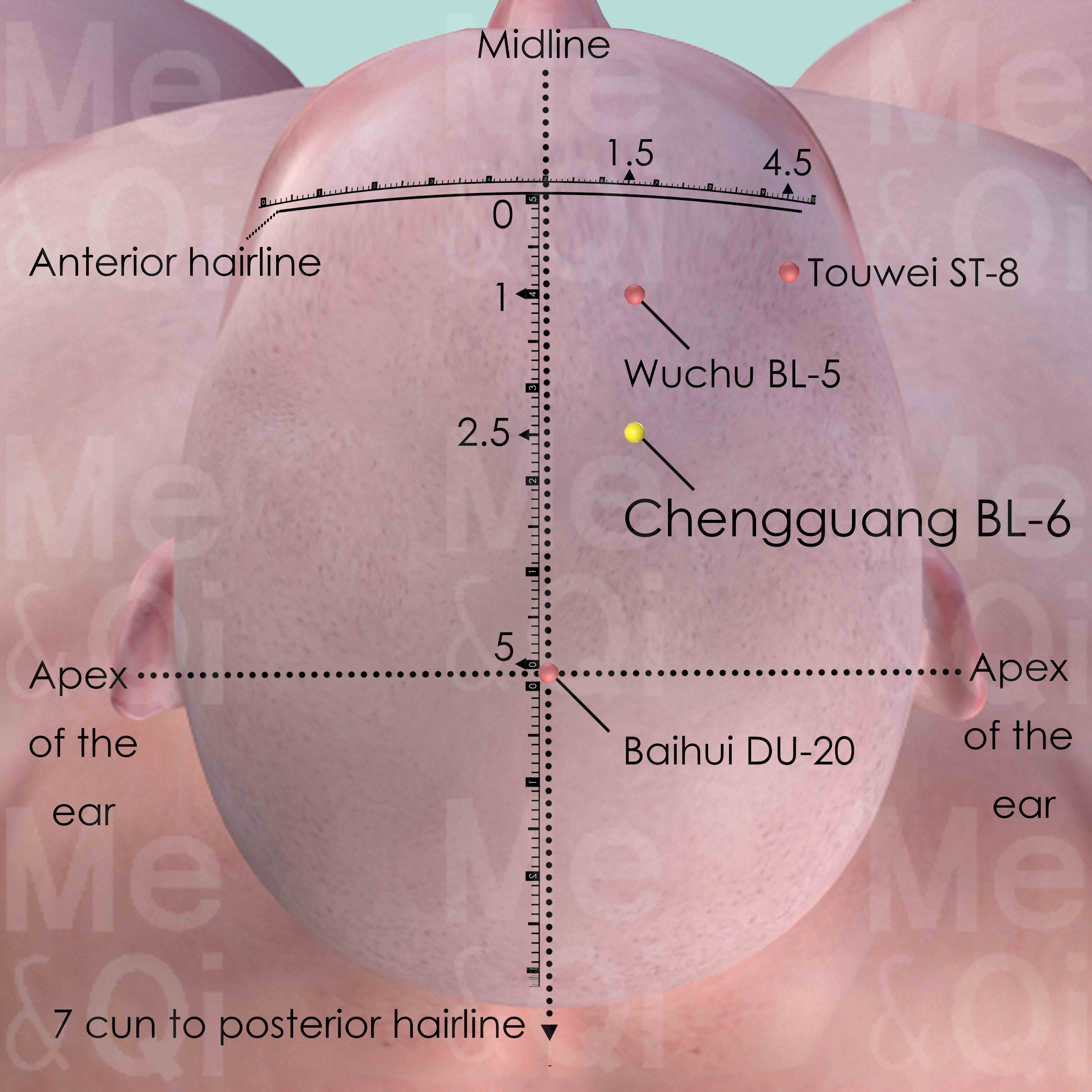
Chengguang BL-6
1.5 cun lateral to the anterior midline and 2.5 cun within the anterior hairline. On the other hand, this point is at the medial third and lateral two-thirds of the distance from anterior midline to the line vertically from Touwei ST-8. Chengguang BL-6 is also 1.5 cun posterior to Wuchu BL-5.
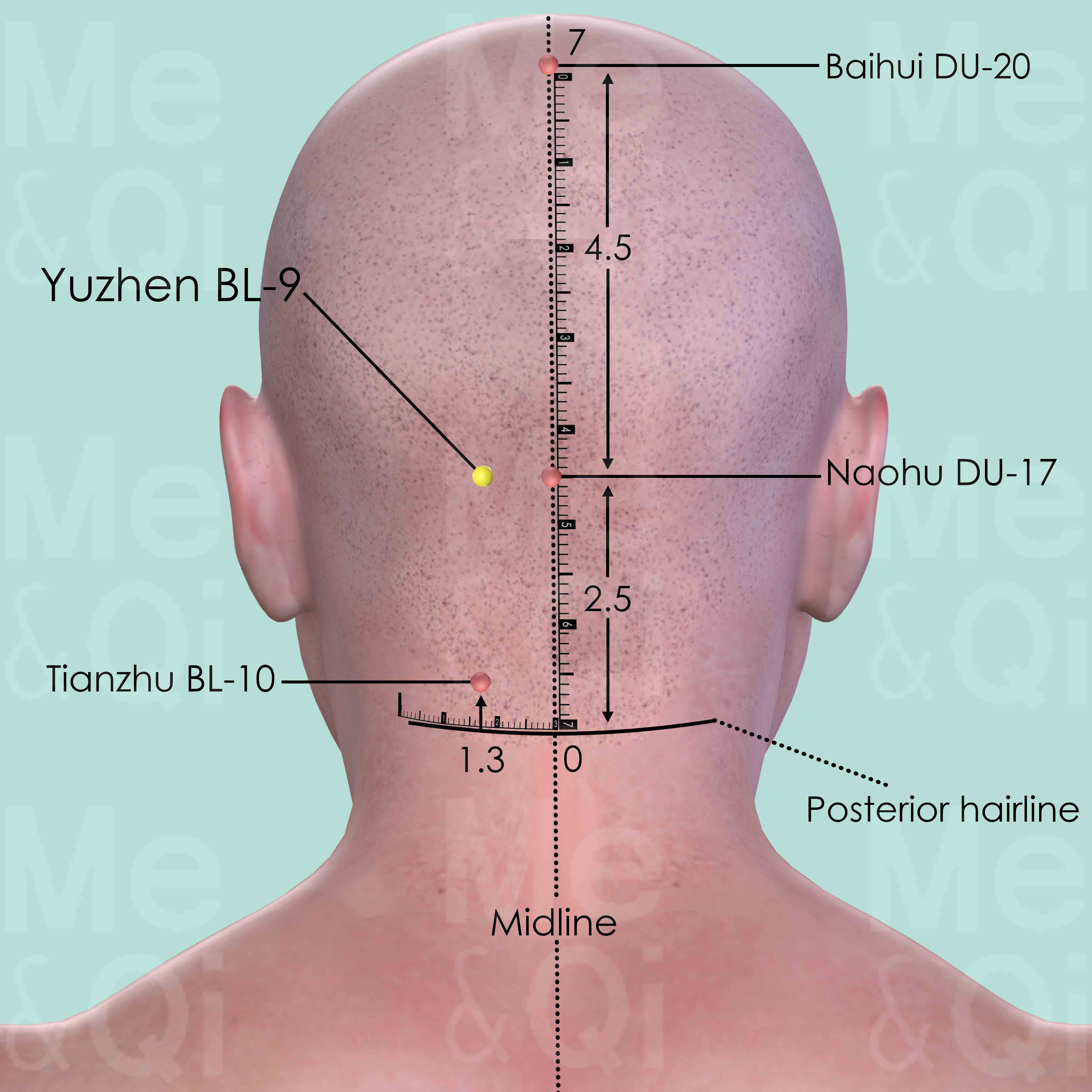
Yuzhen BL-9
First identify Naohu DU-17 which is on the superior border of the external occipital protuberance. Yuzhen BL-9 is 1.3 cun lateral to Naohu DU-17.
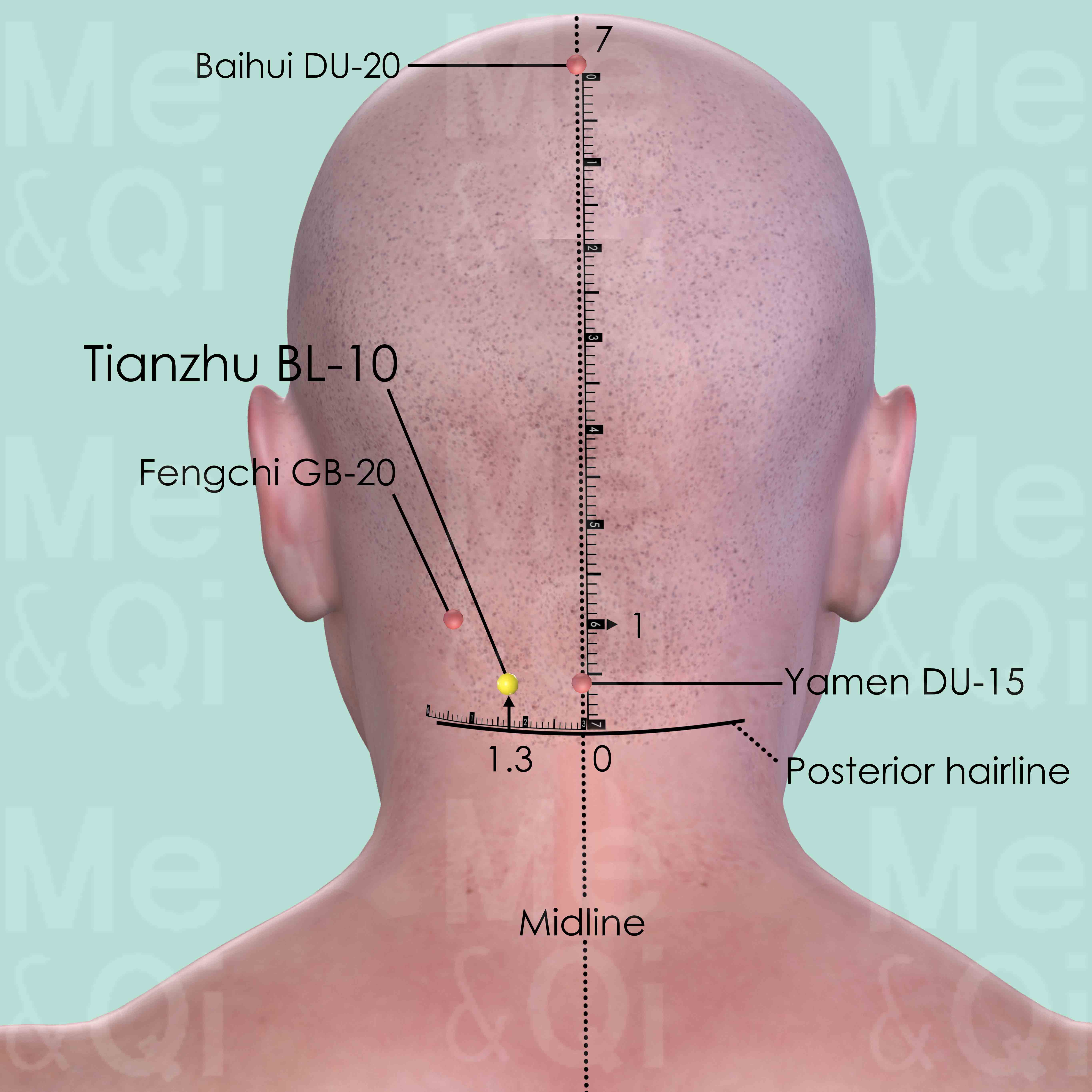
Tianzhu BL-10
1.3 cun lateral to Yamen DU-15 on the posterior midline, 0.5 cun above the posterior hairline, on the lateral side of trapezius muscle.
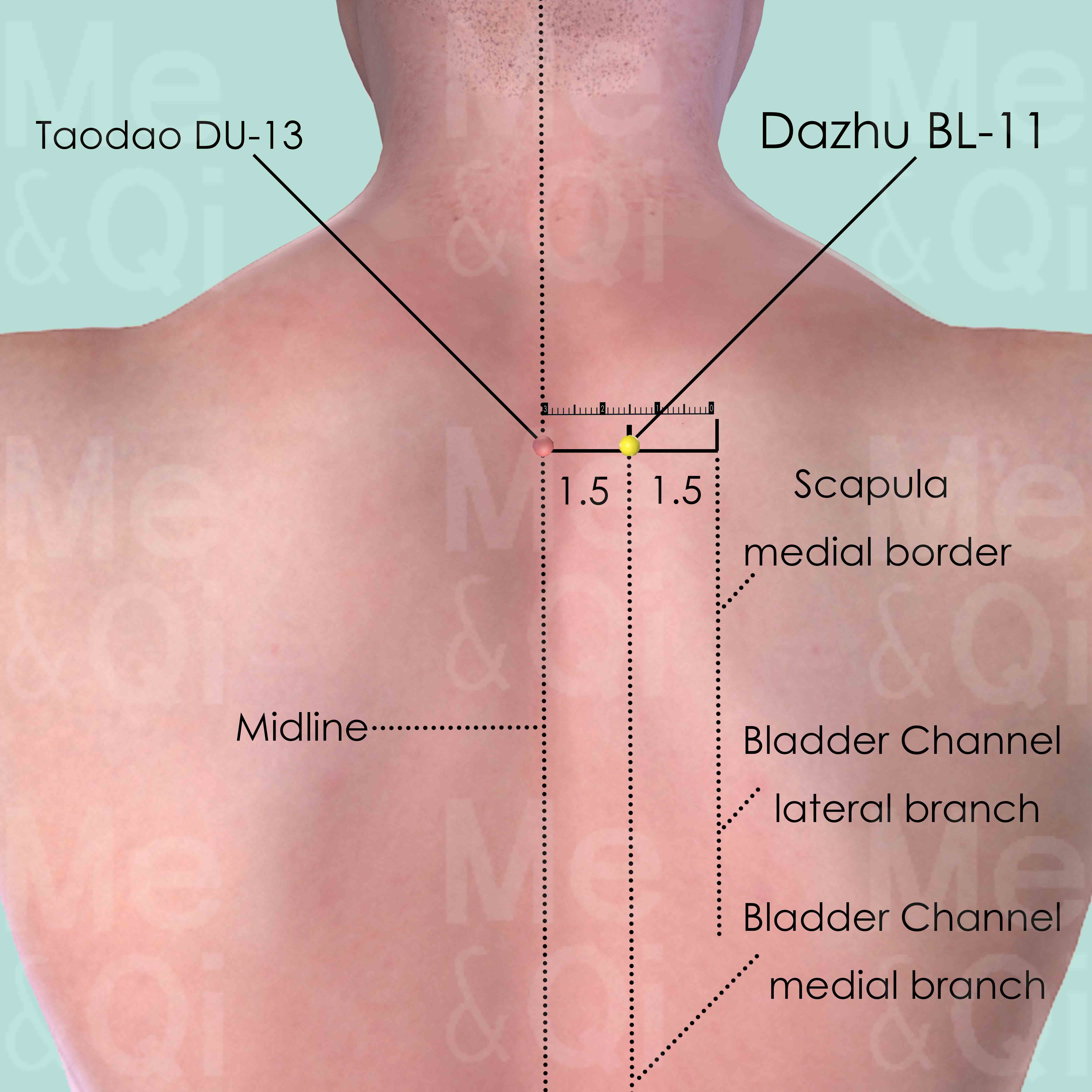
Dazhu BL-11
On the level of the lower border of the spinous process of the 1st thoracic vertebra (T1), 1.5 cun (about 2 finger-breadths) lateral to the posterior midline.
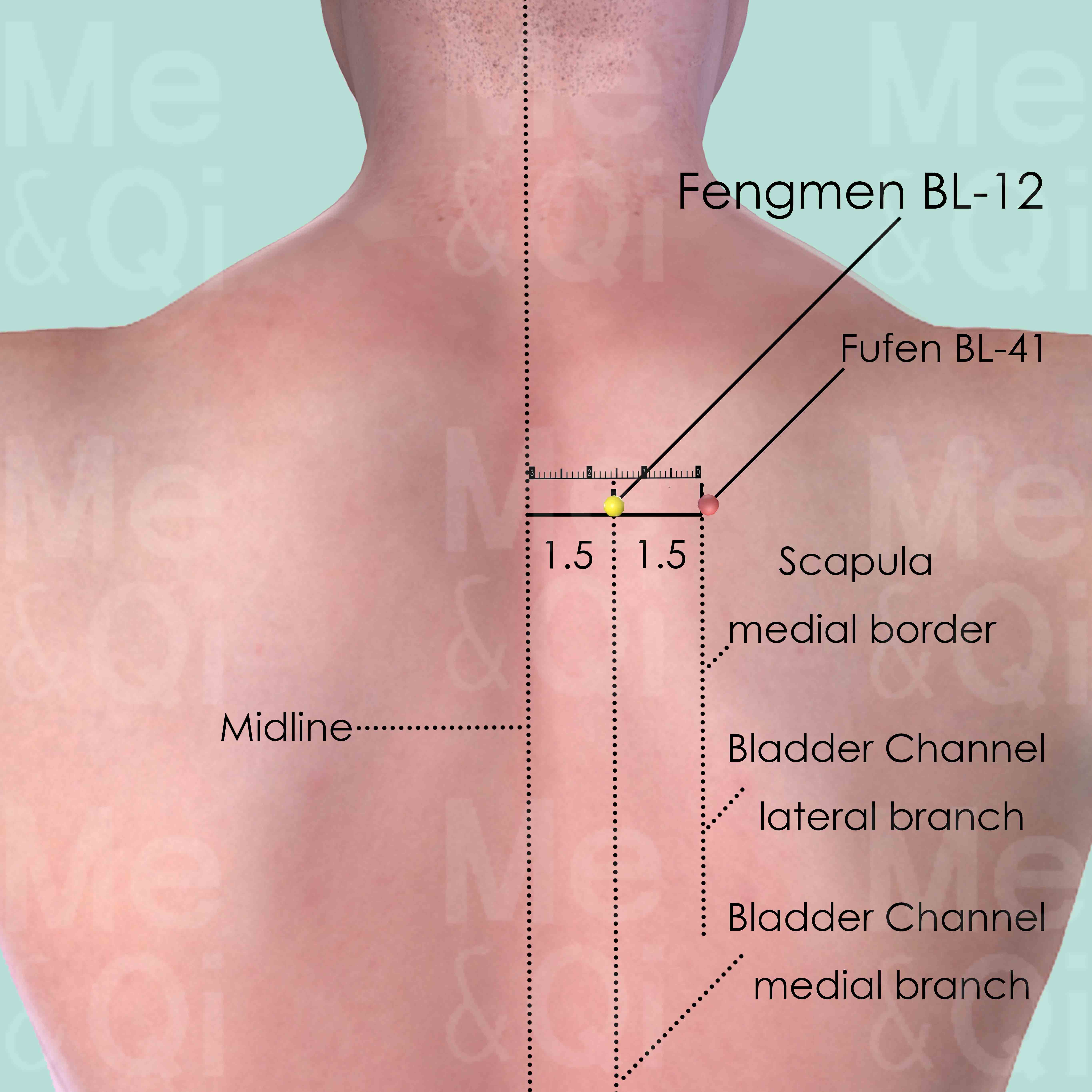
Fengmen BL-12
1.5 cun lateral to the lower border of the spinous process of the 2nd thoracic vertebra (T2).
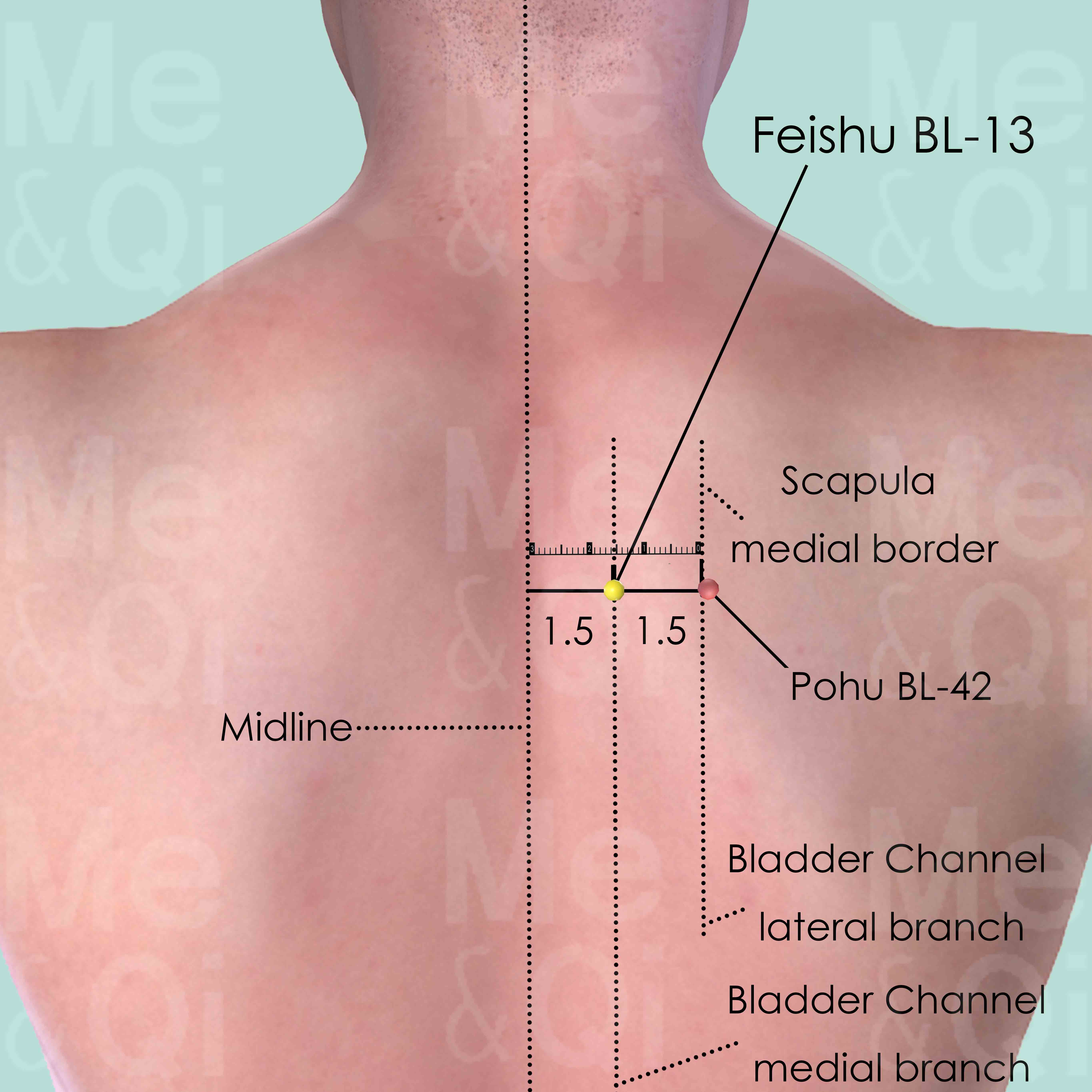
Feishu BL-13
1.5 cun lateral to the lower border of the spinous process of the 3rd thoracic vertebra (T3).
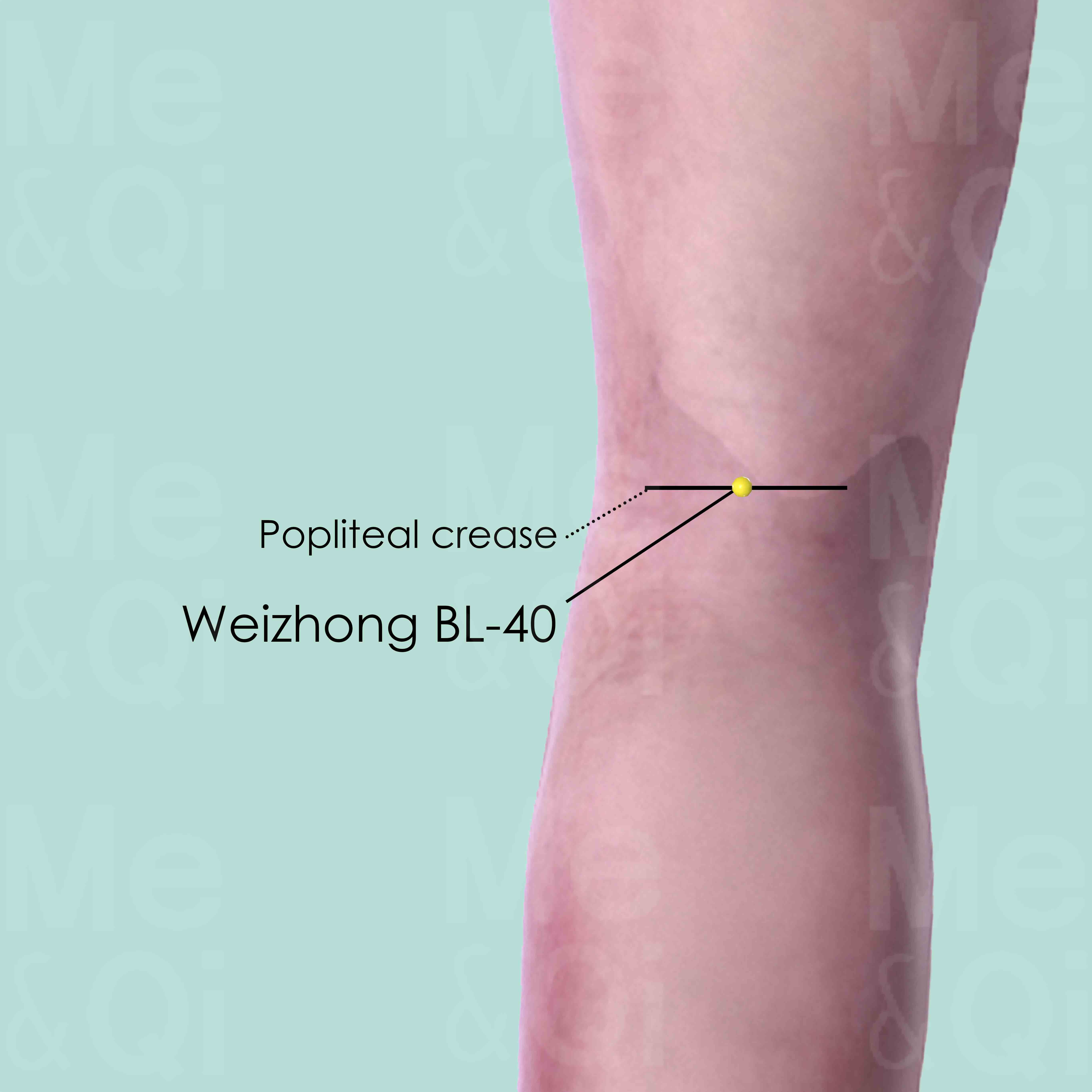
Weizhong BL-40
At the midpoint of the popliteal crease, between the tendons of biceps femoris and semitendinosus muscle.
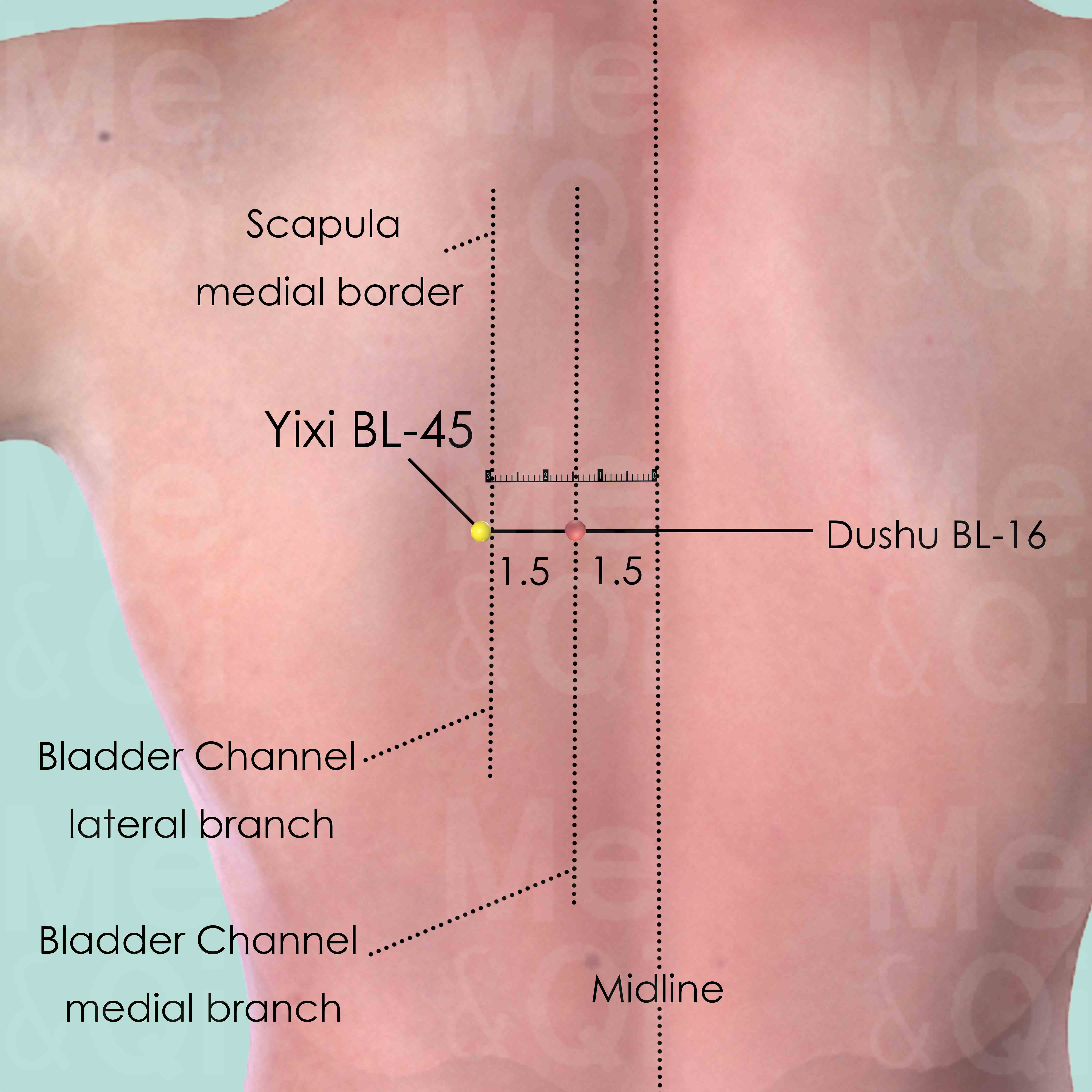
Yixi BL-45
3 cun (about 4 finger-breadths) lateral to the lower border of the spinous process of the 6th thoracic vertebra (T6).
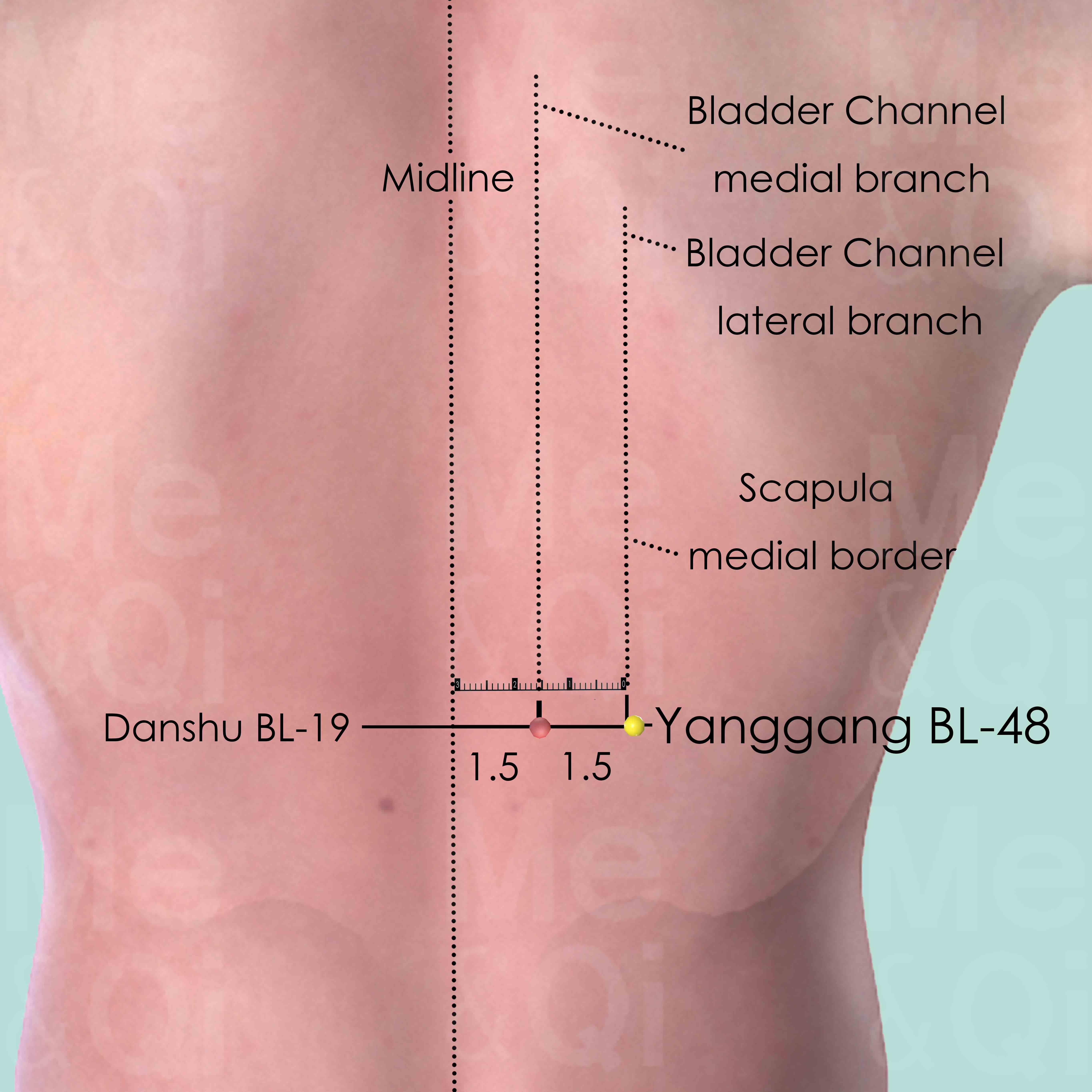
Yanggang BL-48
3 cun lateral to the lower border of the spinous process of the 10th thoracic vertebra (T10).
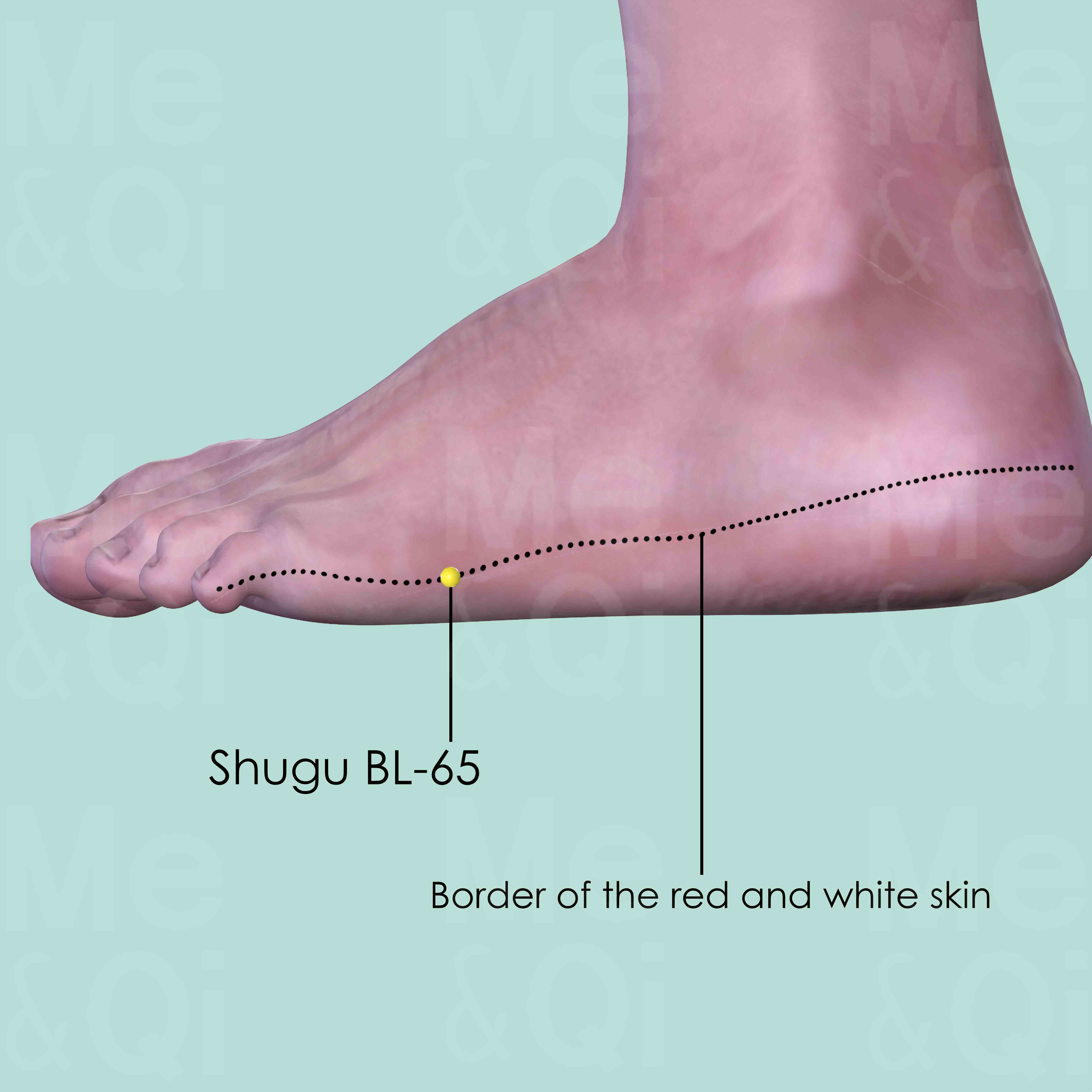
Shugu BL-65
On the lateral side of the foot dorsum, proximal to the head of the 5th metatarsal bone, at the border of the red and white skin.
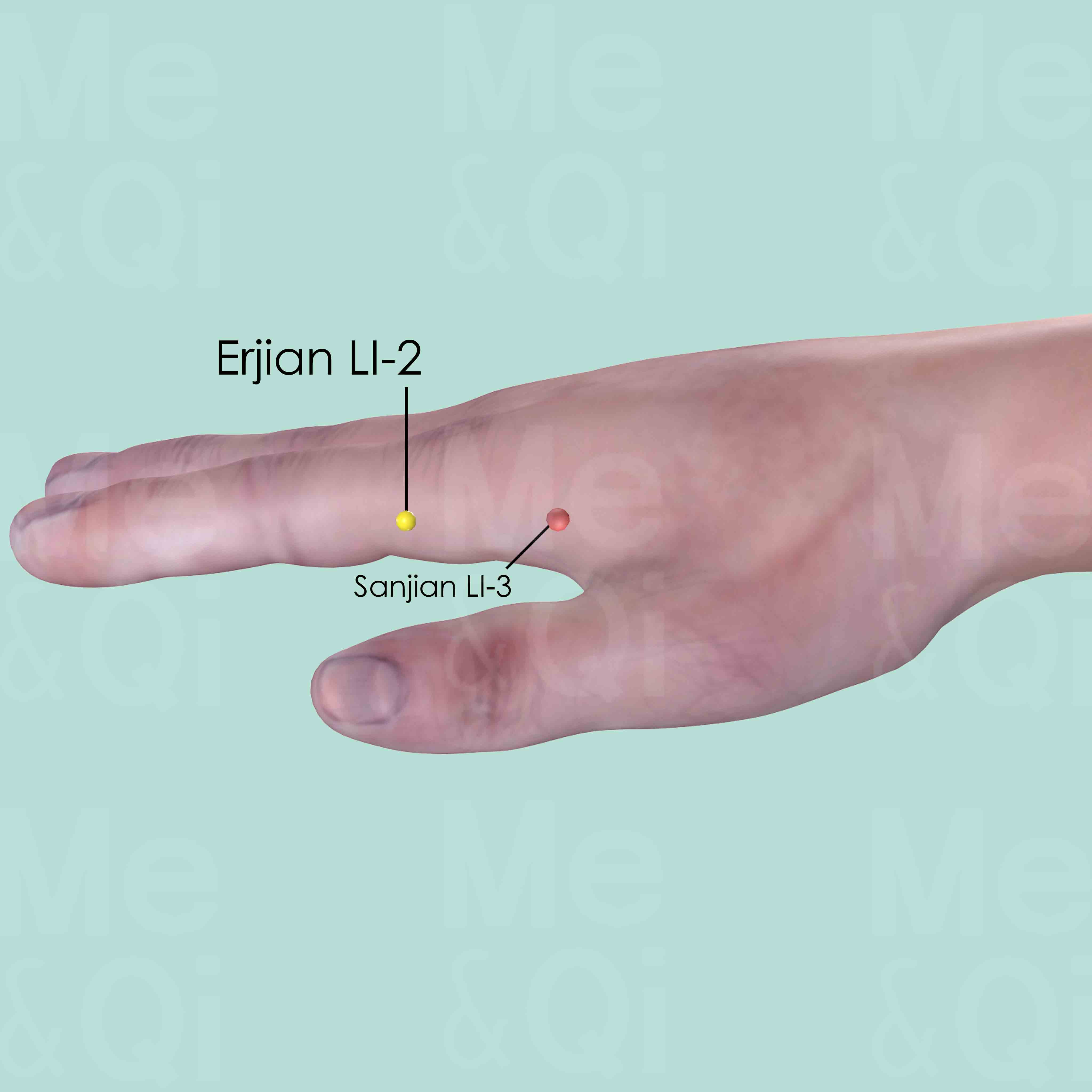
Erjian LI-2
On the radial side of the index finger, distal to the metacarpophalangeal joint, at the junction of the white and red skin.
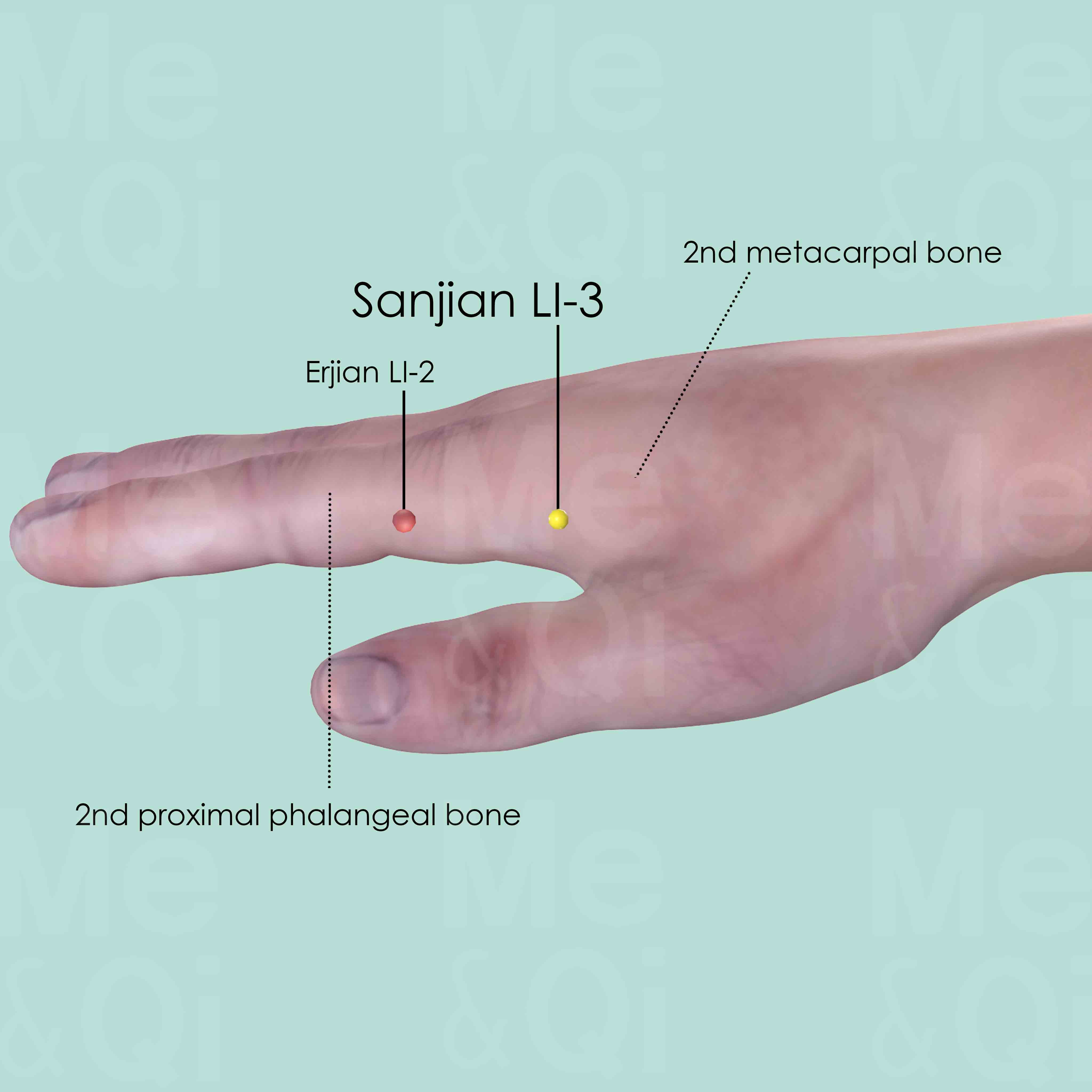
Sanjian LI-3
Located on the radial side of the index finger, in the depression proximal to the head of the 2nd metacarpal bone.
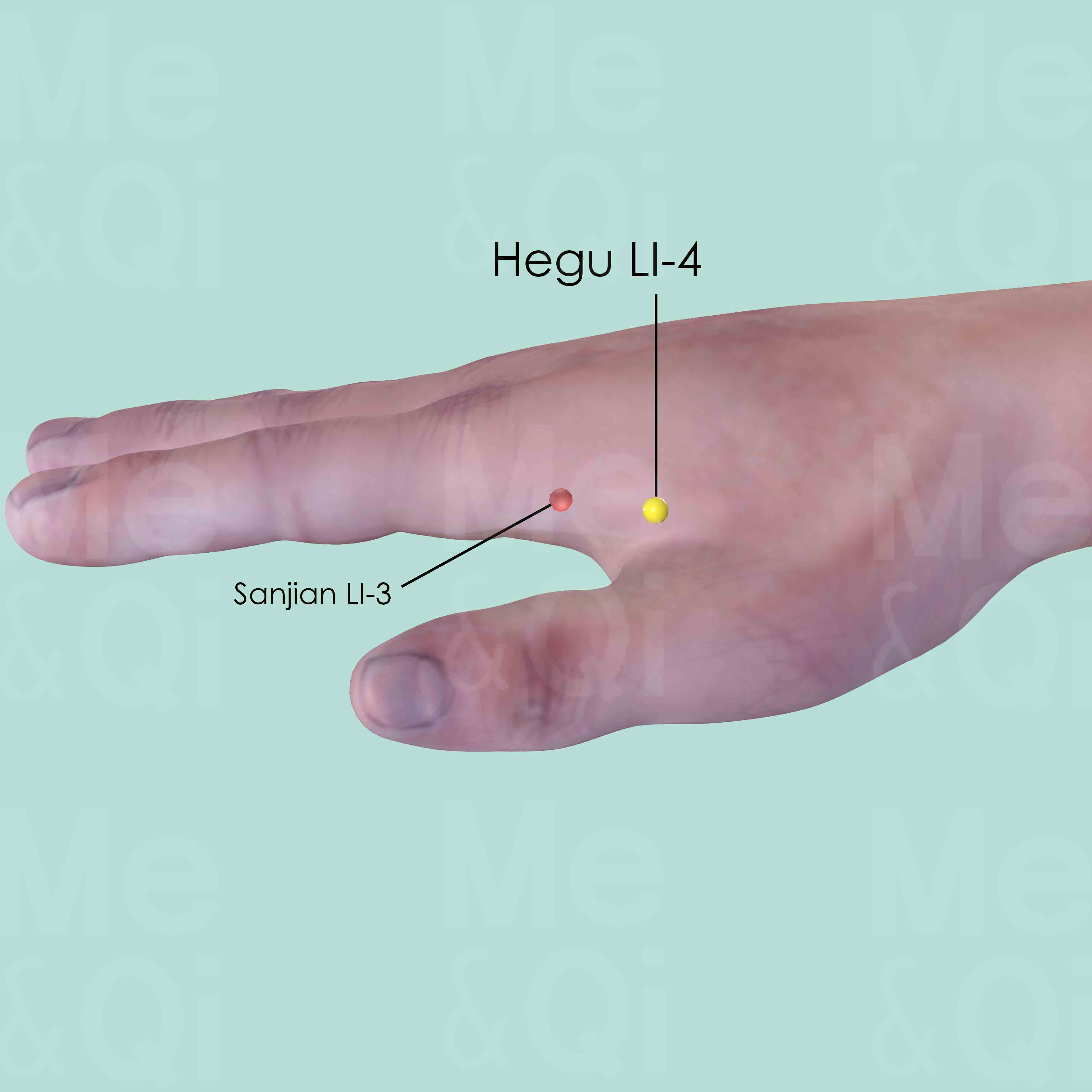
Hegu LI-4
Between the 1st and 2nd metacarpal bones, approximately in the middle of the 2nd metacarpal bone on the radial side.
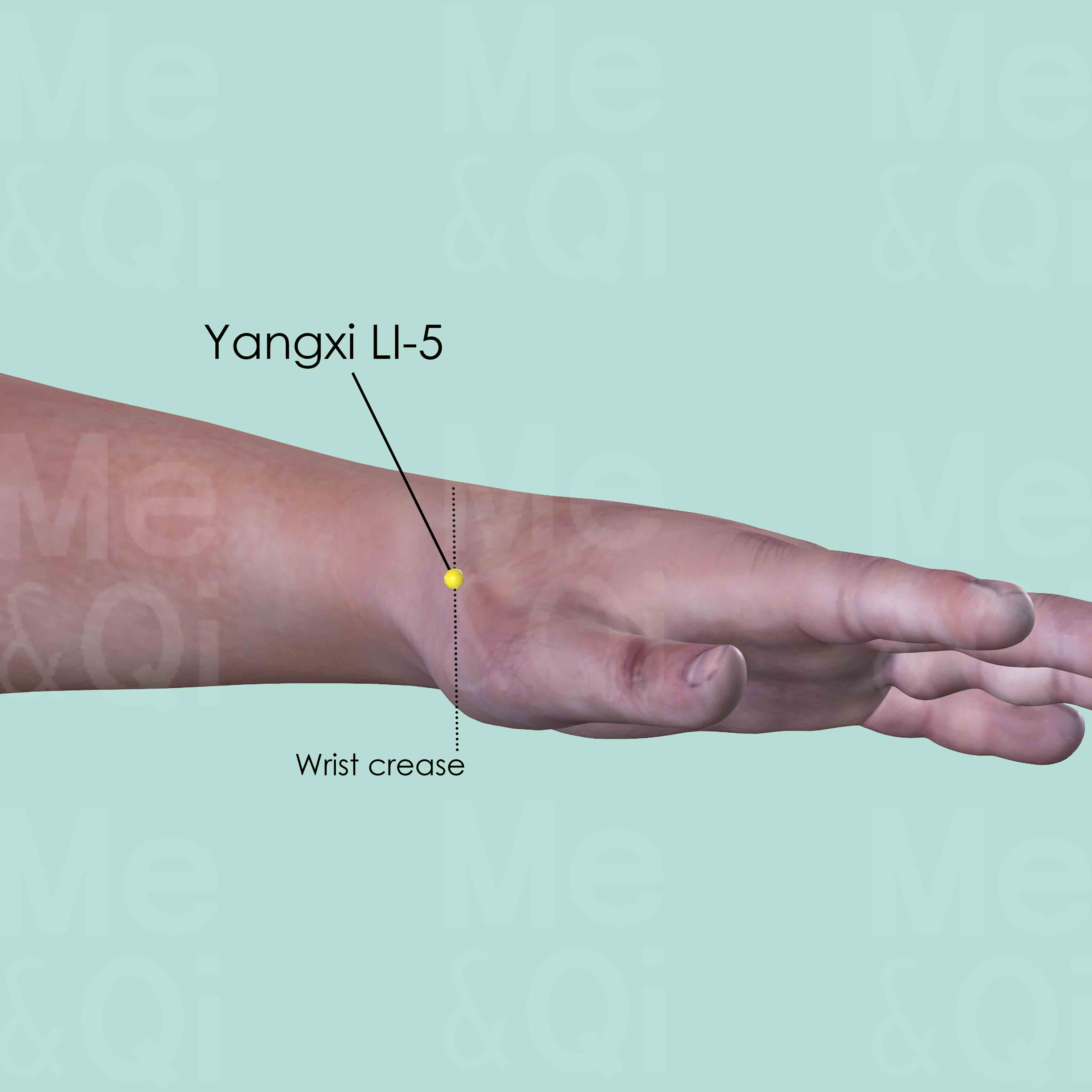
Yangxi LI-5
On the radial side of the wrist. When the thumb is tilted upward, it is in the depression on the wrist joint space (wrist crease) between the tendons of extensor pollicis longus and brevis muscles.
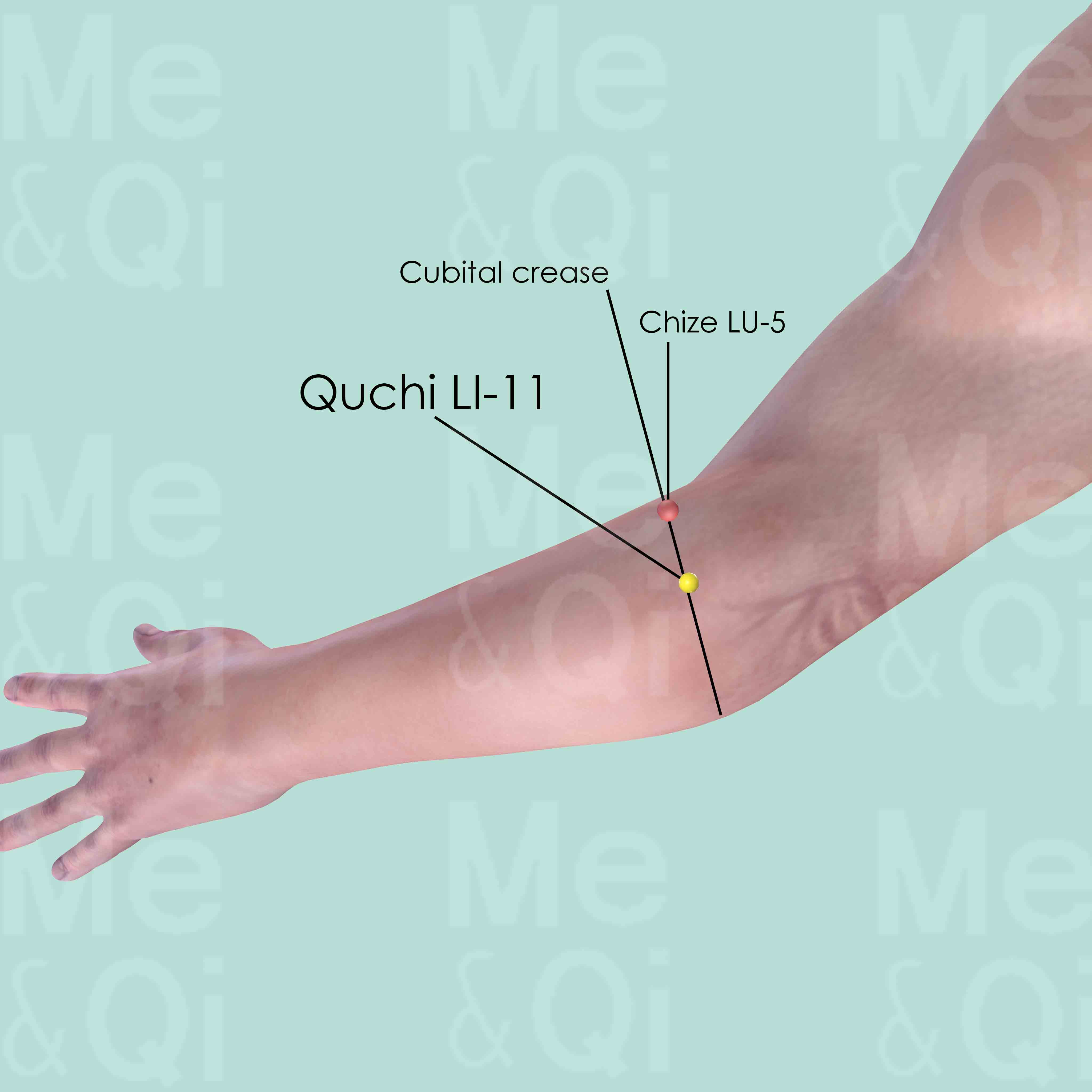
Quchi LI-11
When the elbow is flexed, Quchi LI-11 is in the depression at the lateral end of the cubital crease, midway between Chize LU-5 and the lateral epicondyle of the humerus.
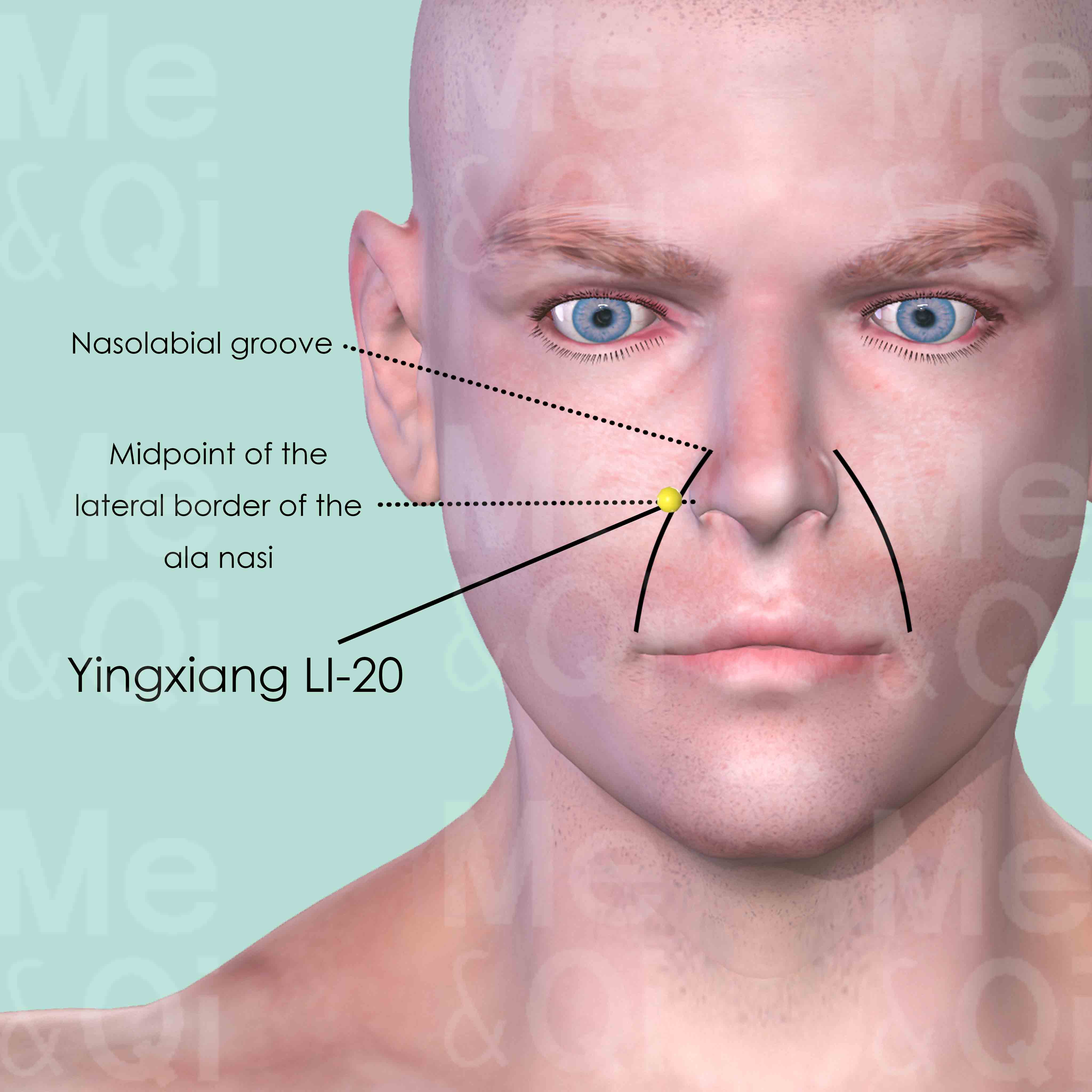
Yingxiang LI-20
In the nasolabrial groove, at the level of the midpoint of the lateral border of ala nasi.
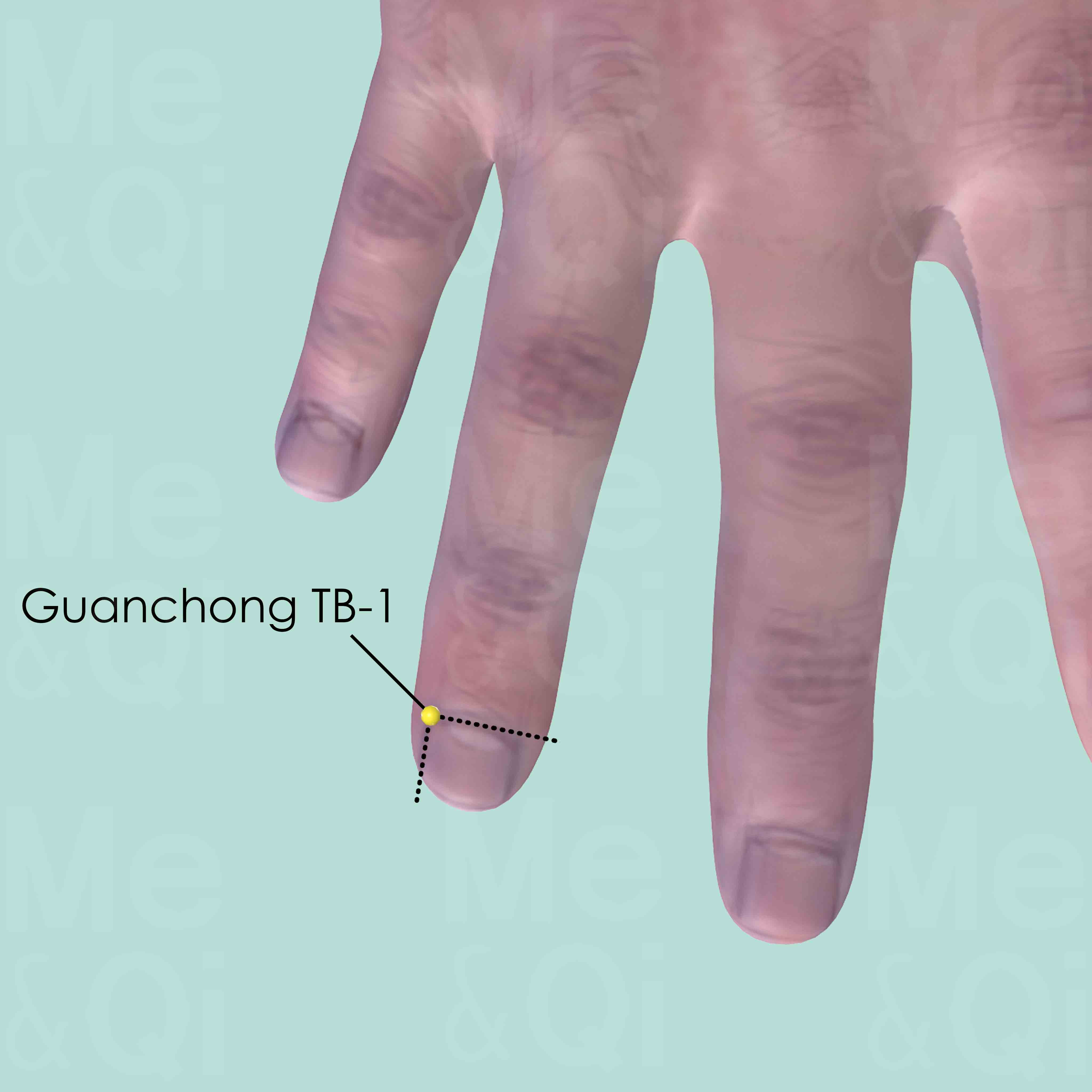
Guanchong TB-1
On the lateral side of the ring finger, about 0.1 cun posterior to the corner of the nail.
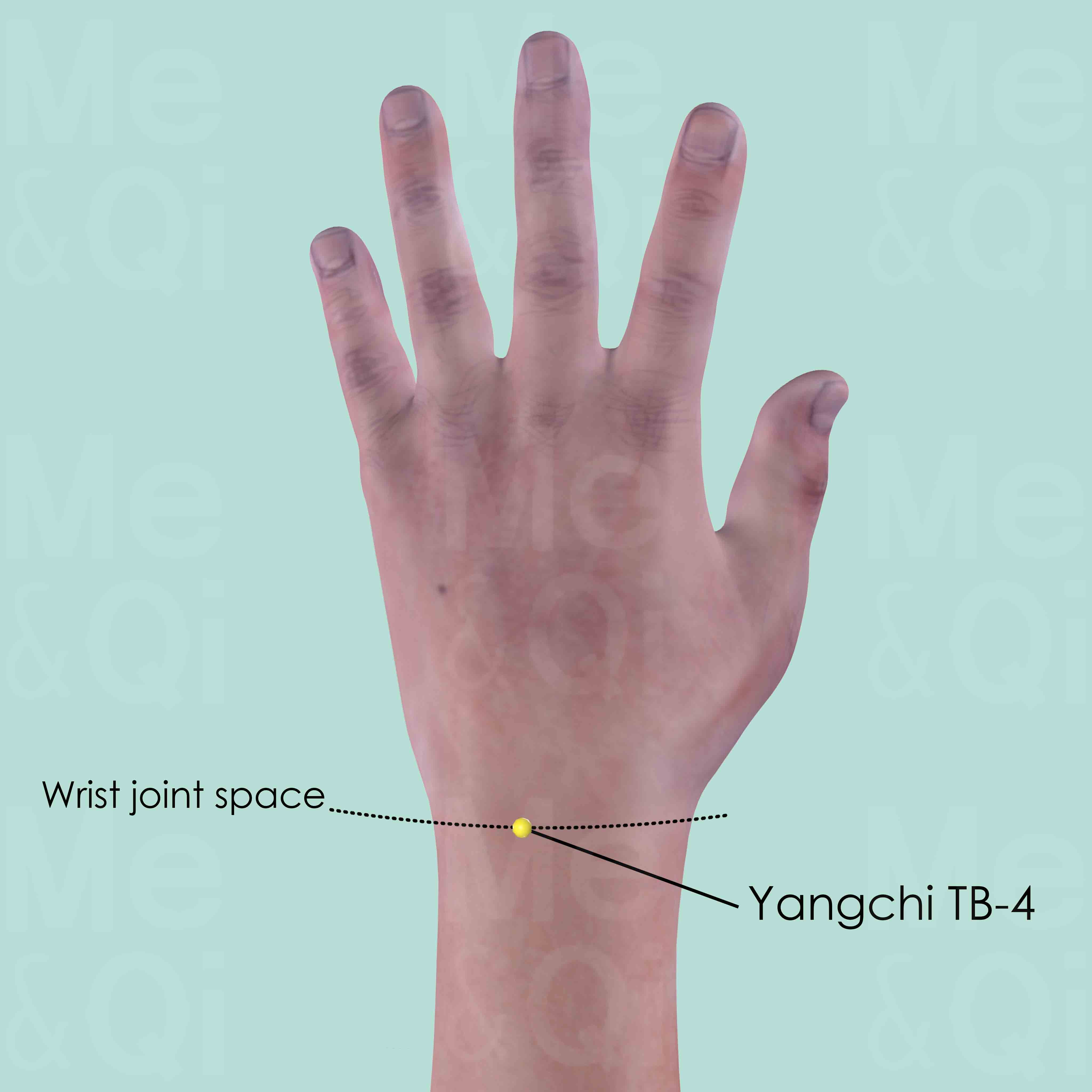
Yangchi TB-4
At the junction of the ulna carpal bones of the wrist dorsum, in the depression lateral to the tendon of extensor digitorum and extensor digiti minimi muscle.
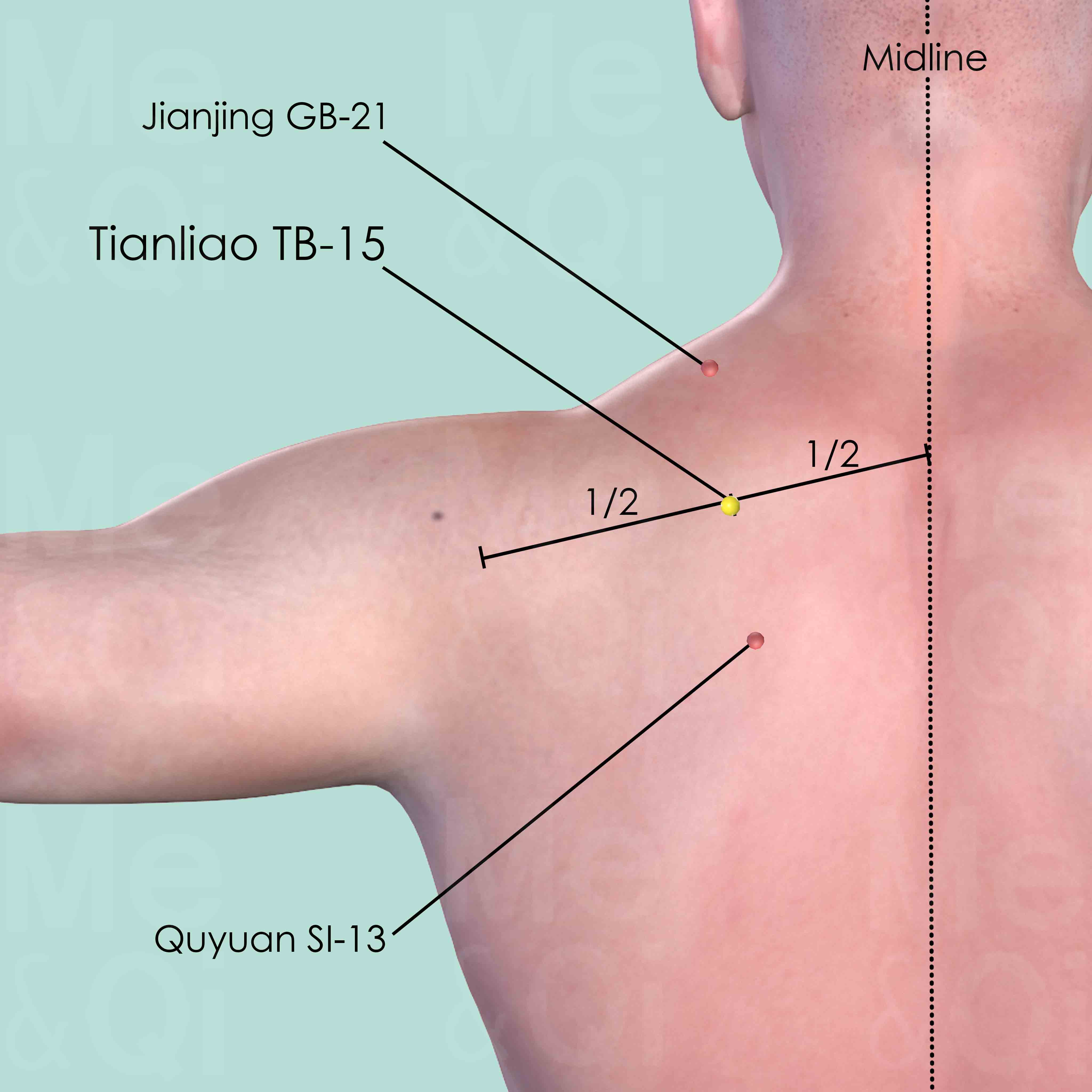
Tianliao TB-15
Midway between Jianjing GB-21 and Quyuan SI-13, on top of the superior angle of the scapula.

Shaoze SI-1
On the ulnar side of the little finger, about 0.1 cun posterior to the corner of the nail.
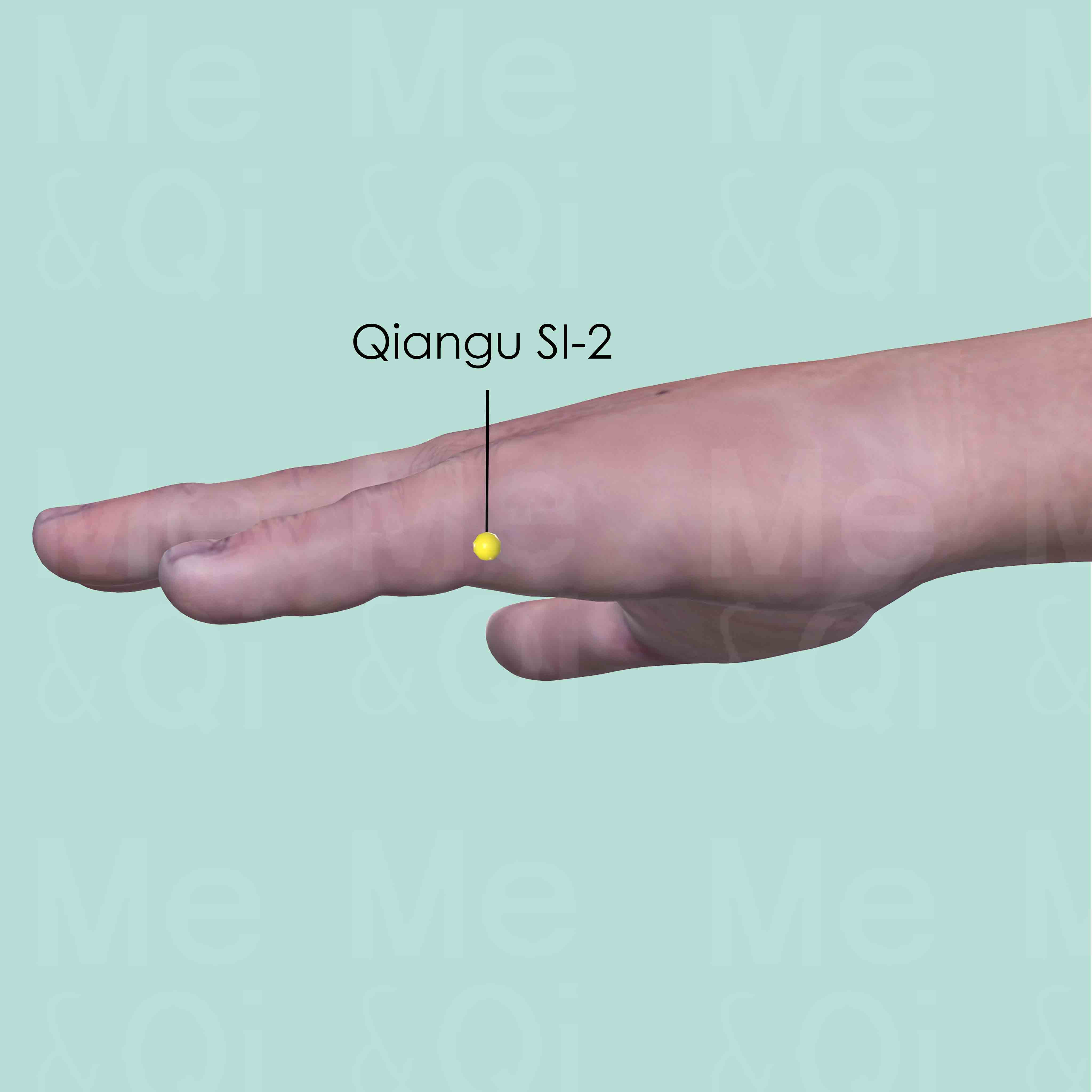
Qiangu SI-2
On the ulnar aspect of the little finger, distal to the metacarpophalangeal joint, at the junction of the shaft and the base of the proximal phalanx.
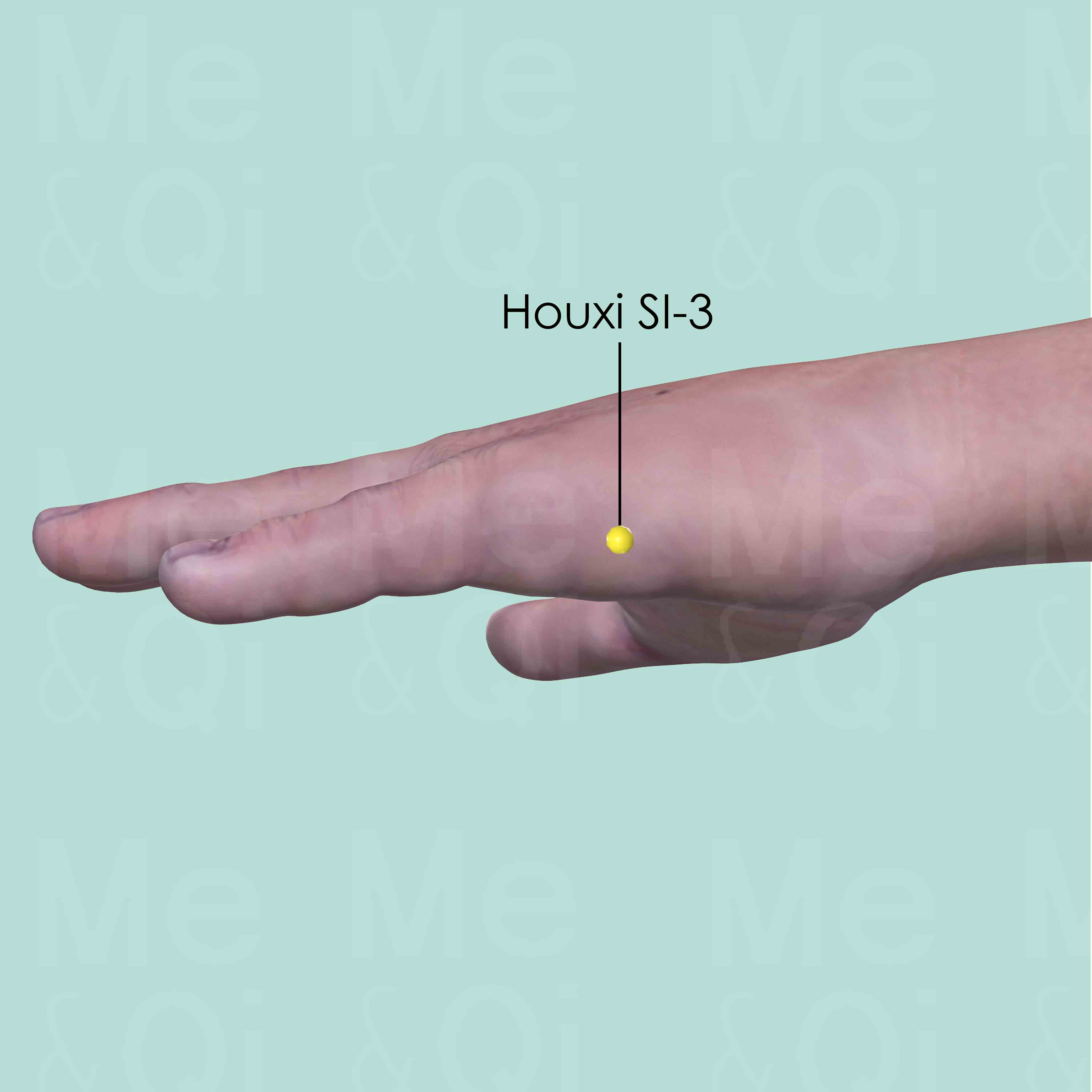
Houxi SI-3
Proximal to the head of the 5th metacarpal bone on the ulnar side, in the depression at the junction of the red and white skin.
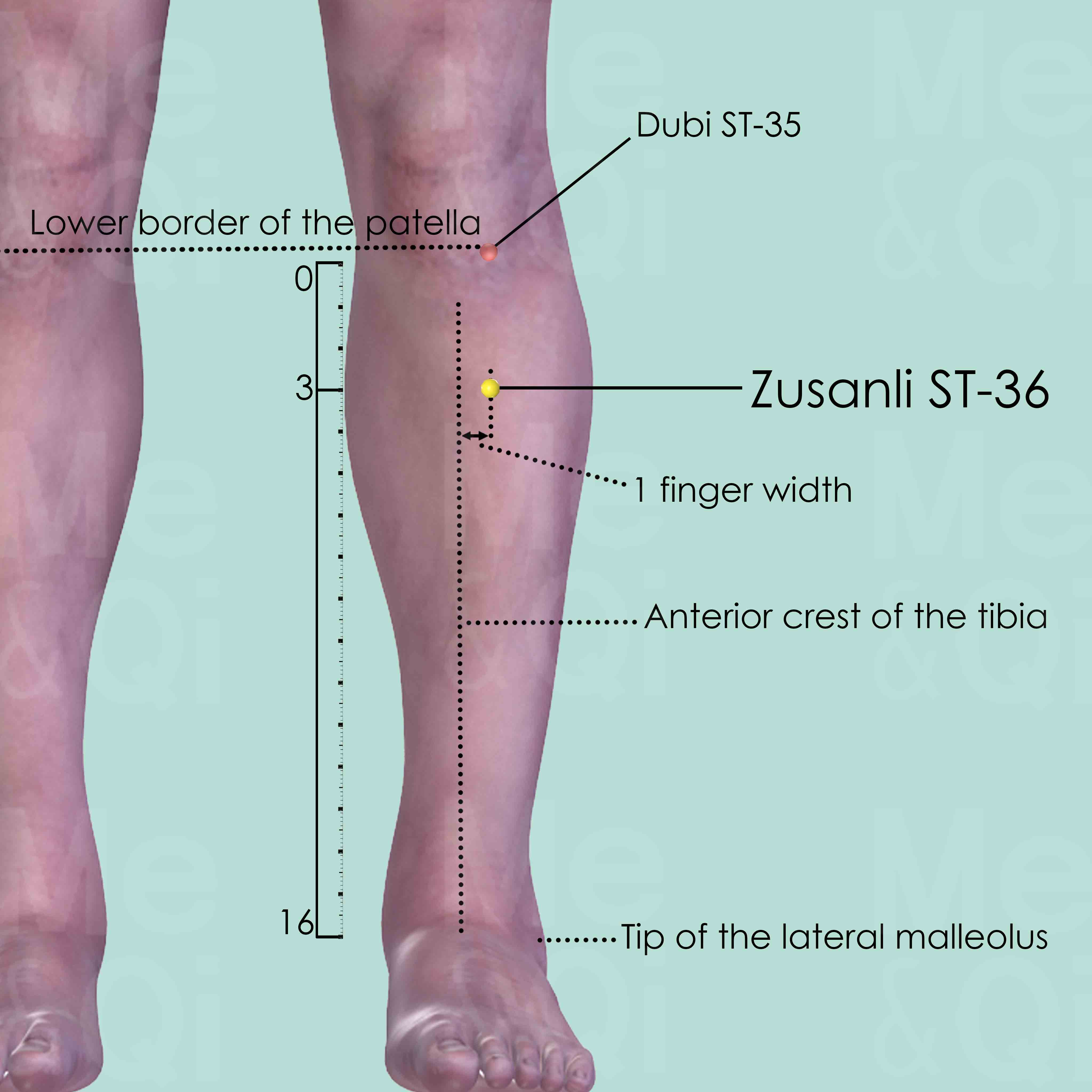
Zusanli ST-36
3 cun below Dubi ST-35, one finger breadth lateral to the anterior crest of the tibia, on the tibialis anterior muscle.
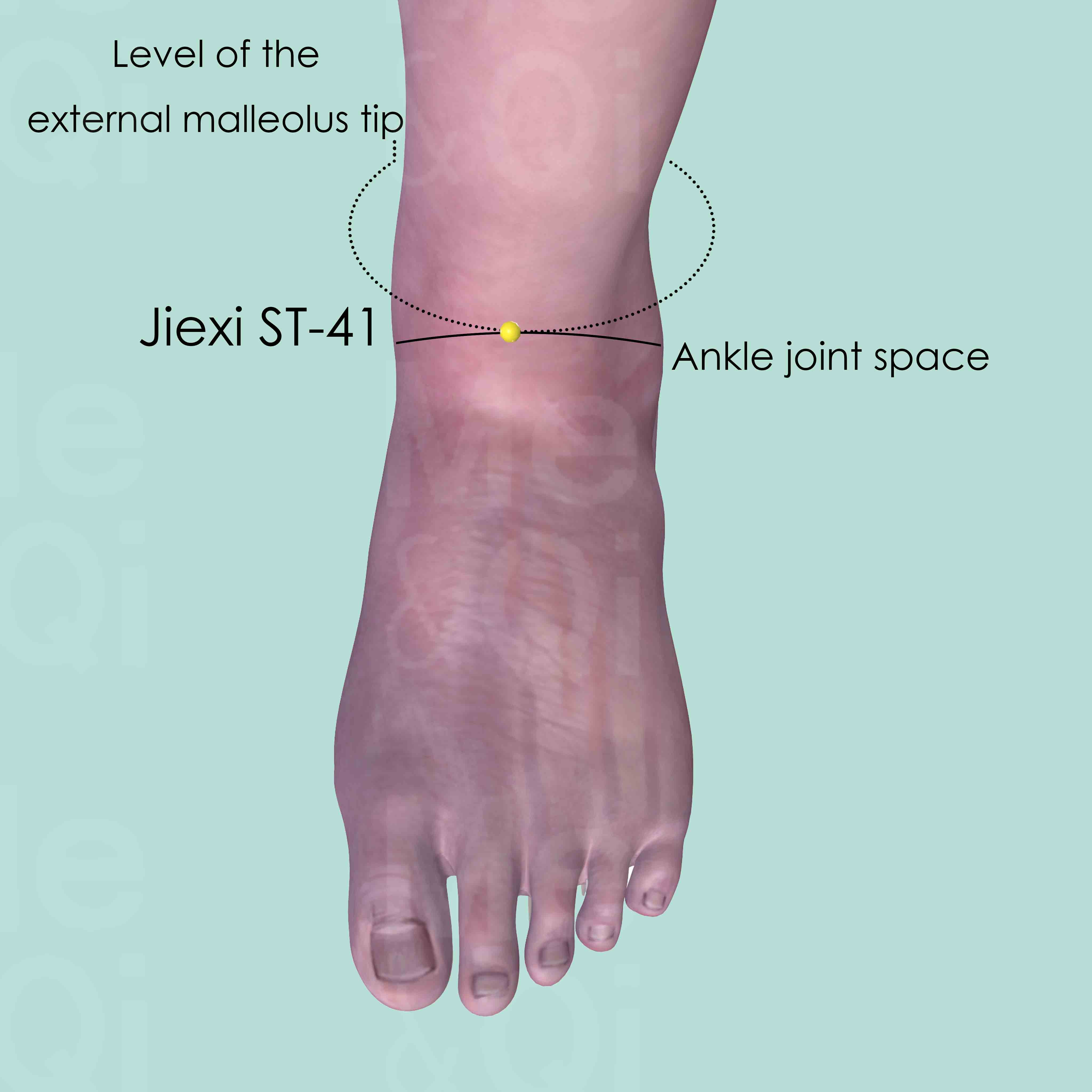
Jiexi ST-41
At the junction of the dorsum of the foot and leg, between the tendons of extensor digitorum and the extensor hallucis longus muscle. Approximately at the level of the tip of the external malleolus.
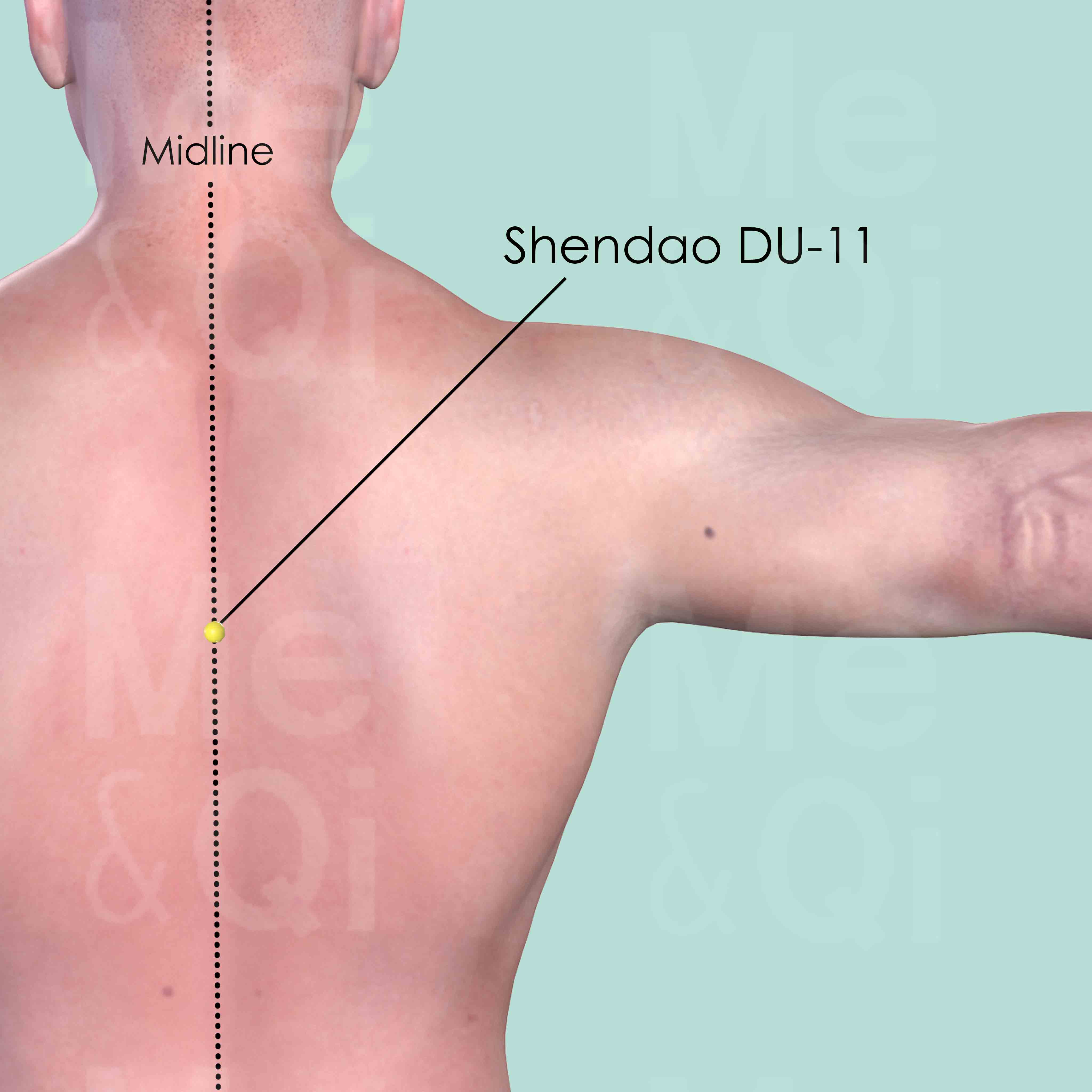
Shendao DU-11
On the back midline, in the depression below the spinous process of the 5th thoracic vertebra (T5).
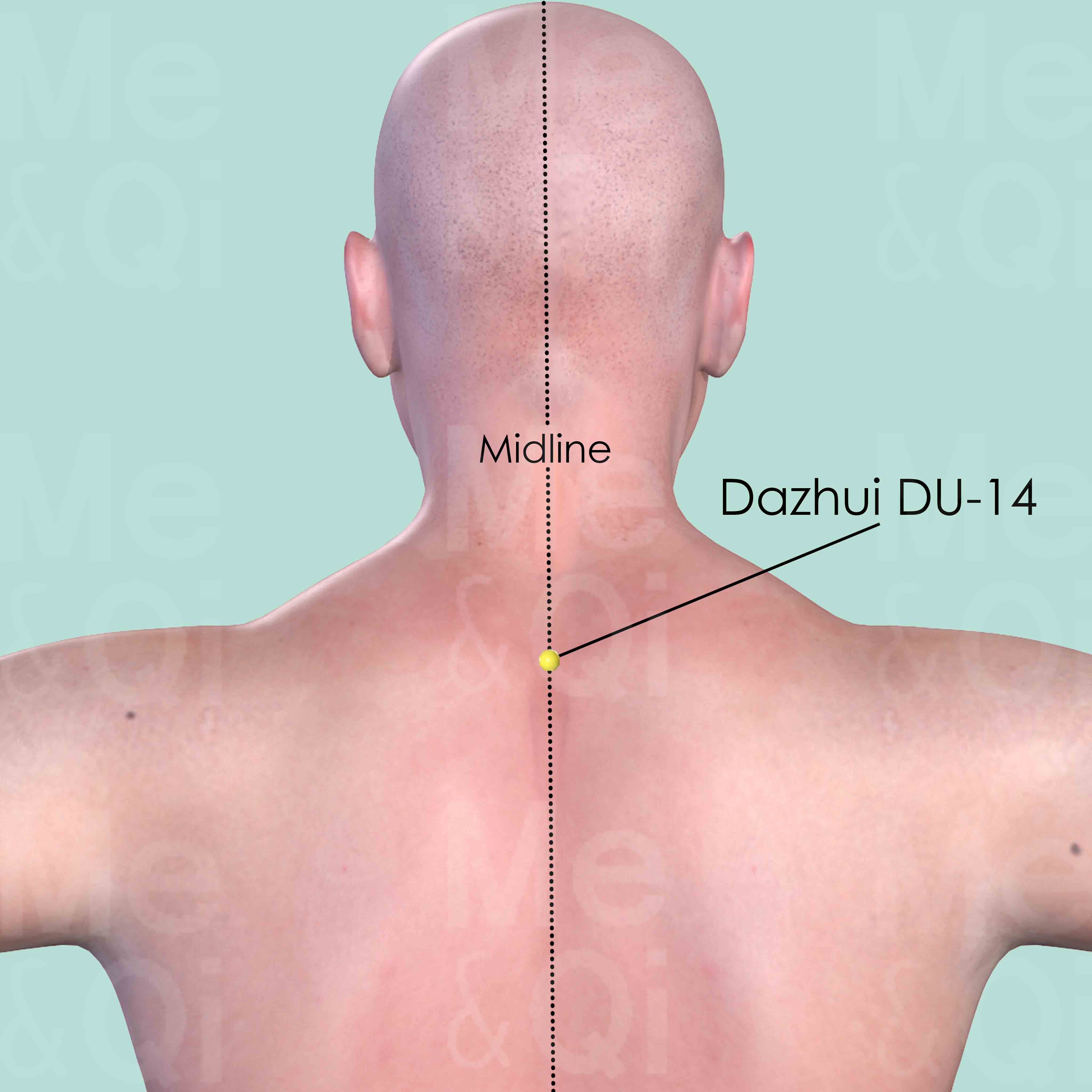
Dazhui DU-14
On the midline at the base of the neck, in the depression below the spinous process of the seventh cervical vertebra (C7).
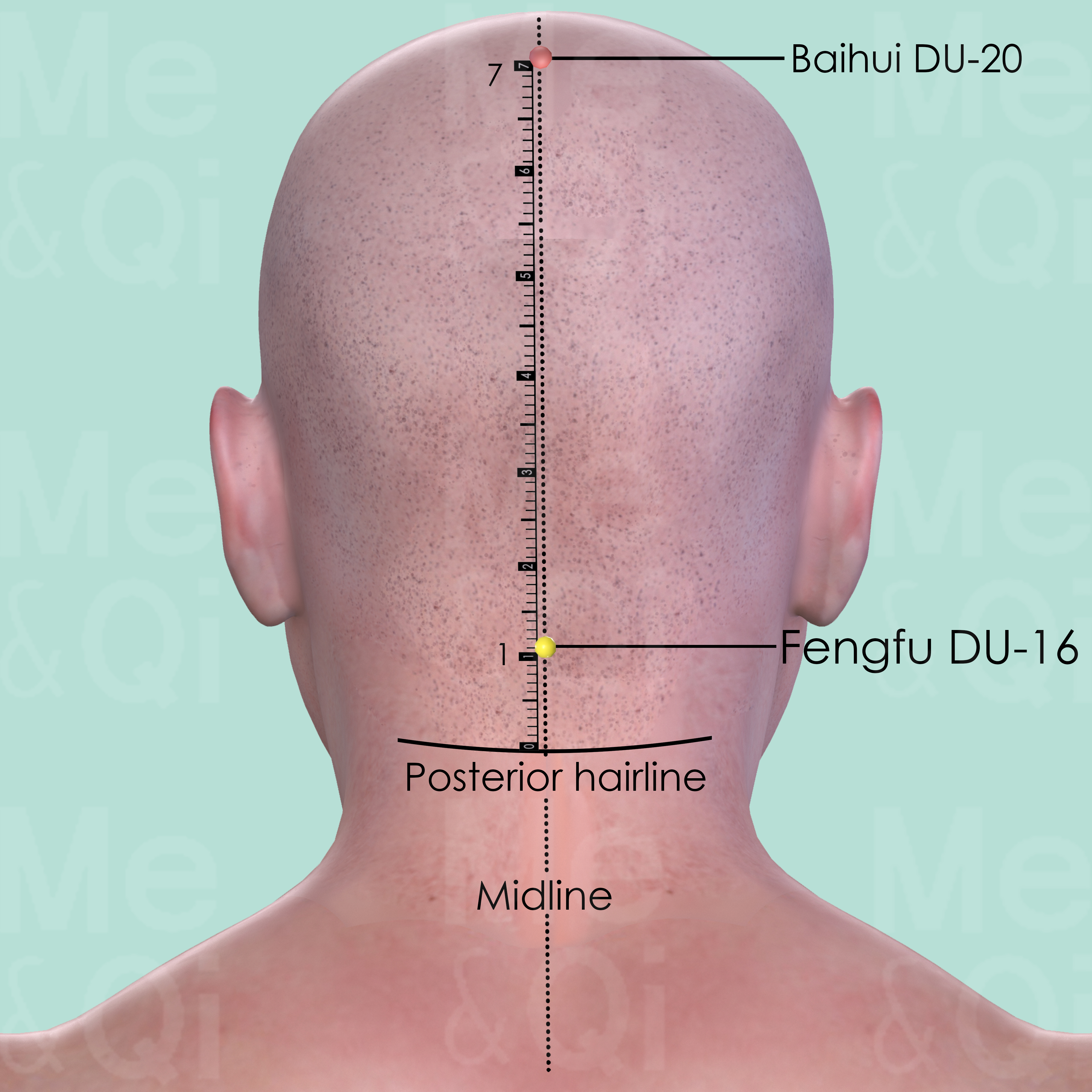
Fengfu DU-16
Directly below the external occipital protuberance, in the depression between the origins of the trapezius muscle.
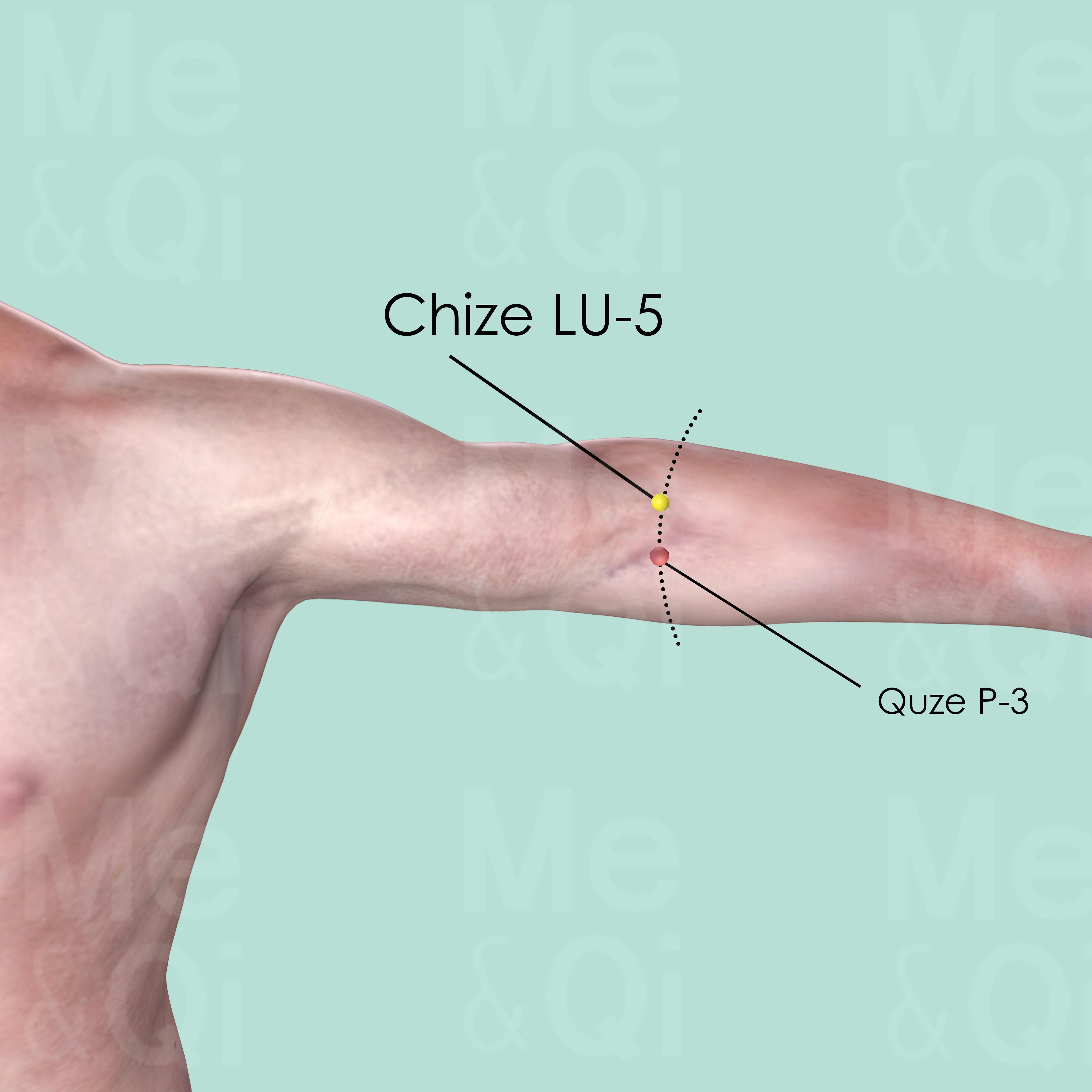
Chize LU-5
On the cubital crease, on the redial aspect of the biceps tendon. It can be easily identified when the elbow is slightly flexed.
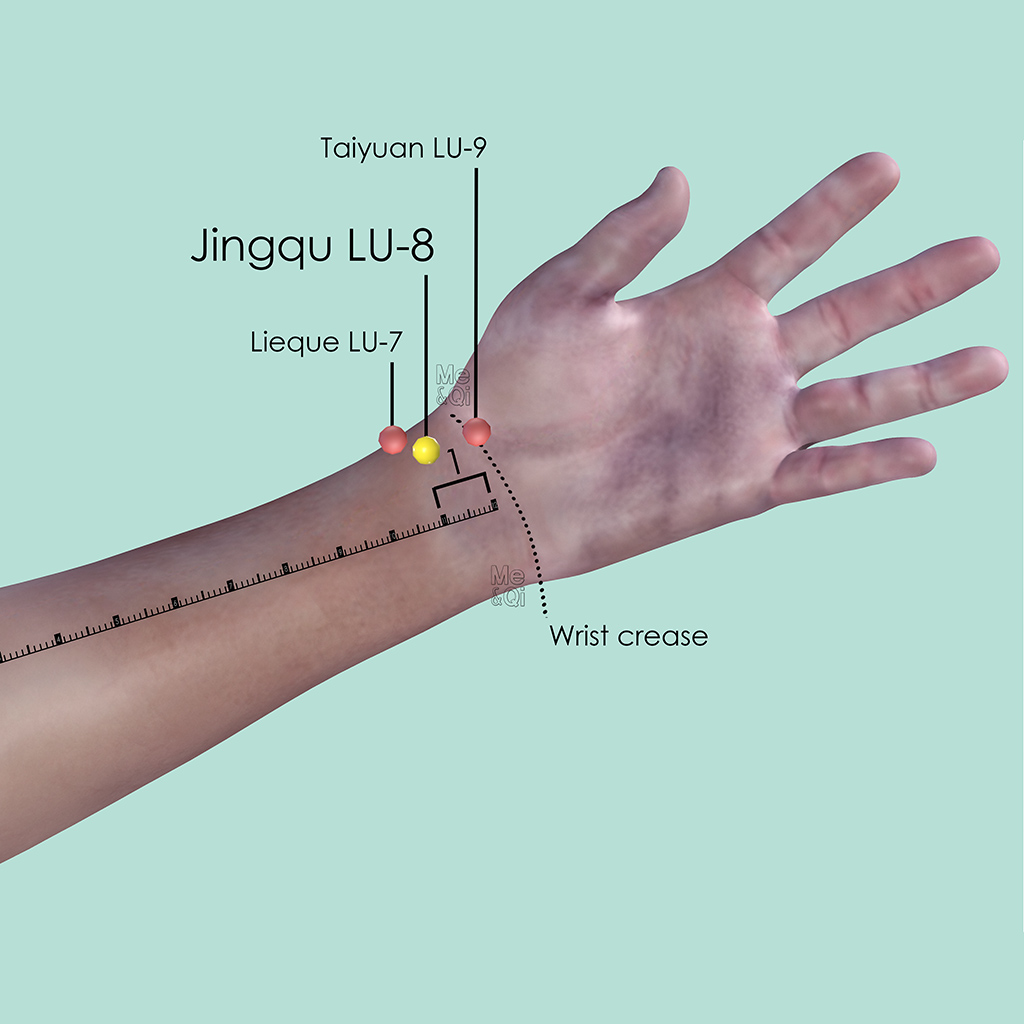
Jingqu LU-8
1 cun proximal to the wrist crease (wrist joint space), in the depression on the radial side of the radial artery.
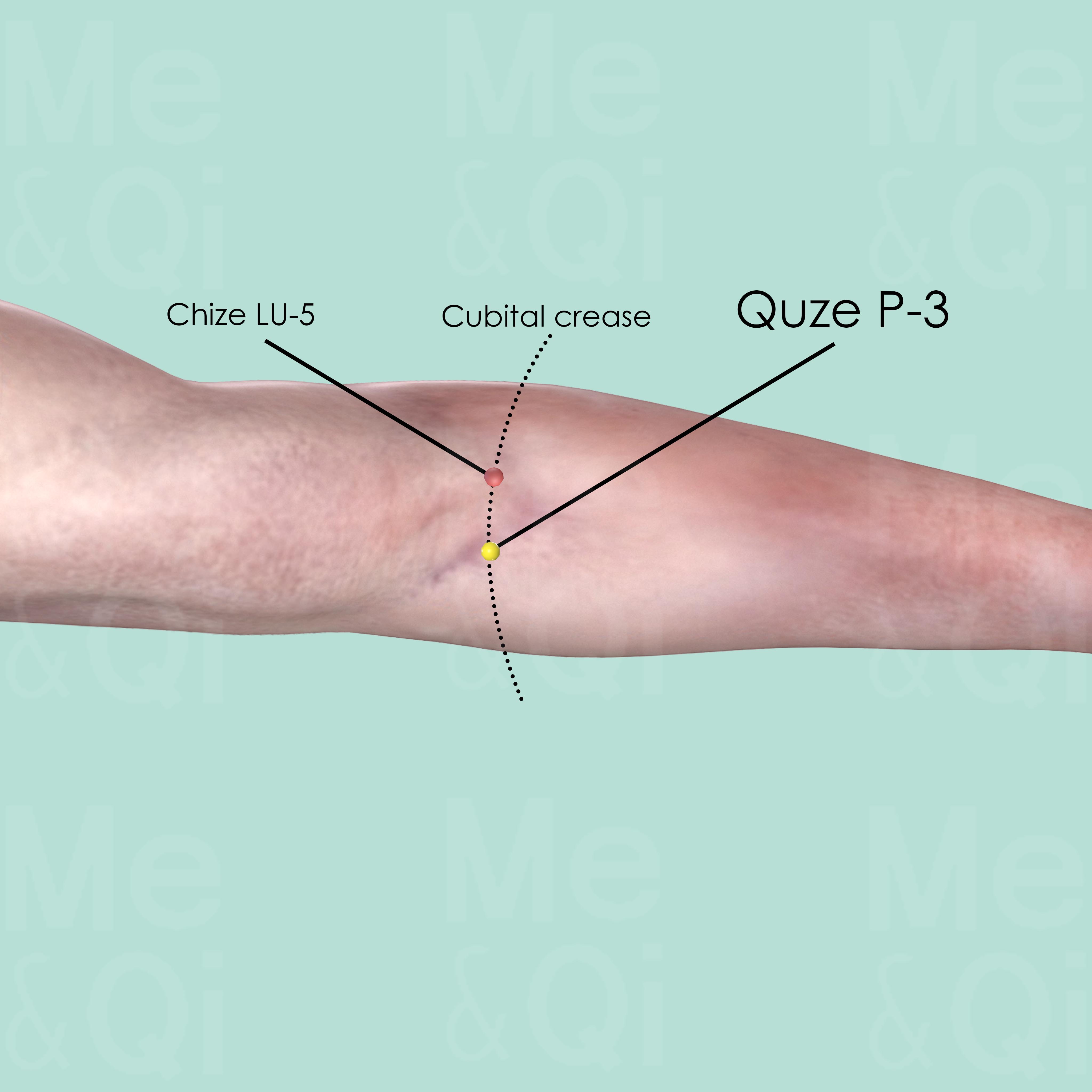
Quze P-3
On the transverse cubital crease, at the ulnar side of the tendon of biceps brachii muscle.
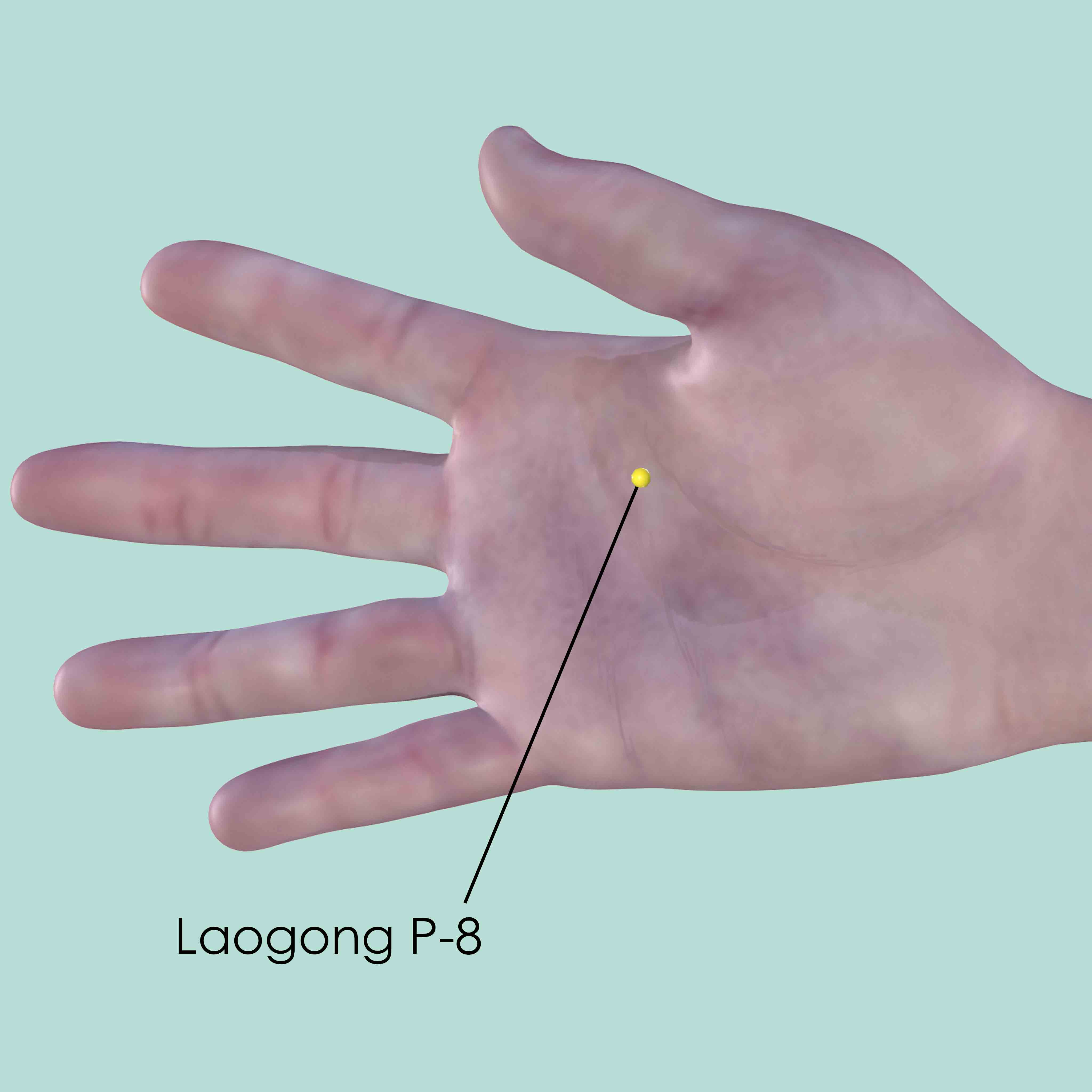
Laogong P-8
In the center of the palm, between the 2nd and the 3rd metacarpal bones, proximal to the metacarpophalangeal joint.
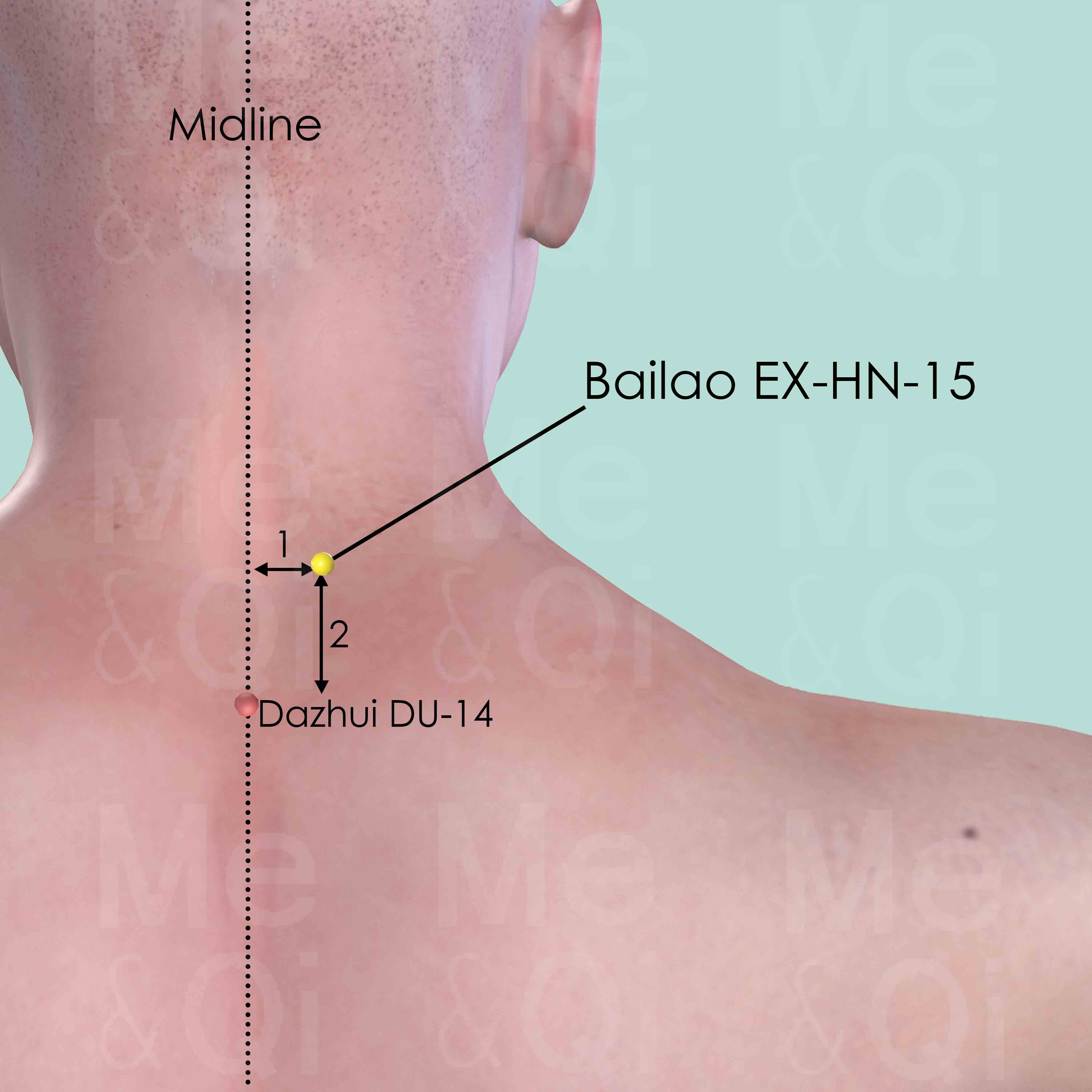
Bailao EX-HN-15
2 cun above the lower border of the spinous process of the 7th cervical vertebra (C7) and 1 cun lateral to the midline.
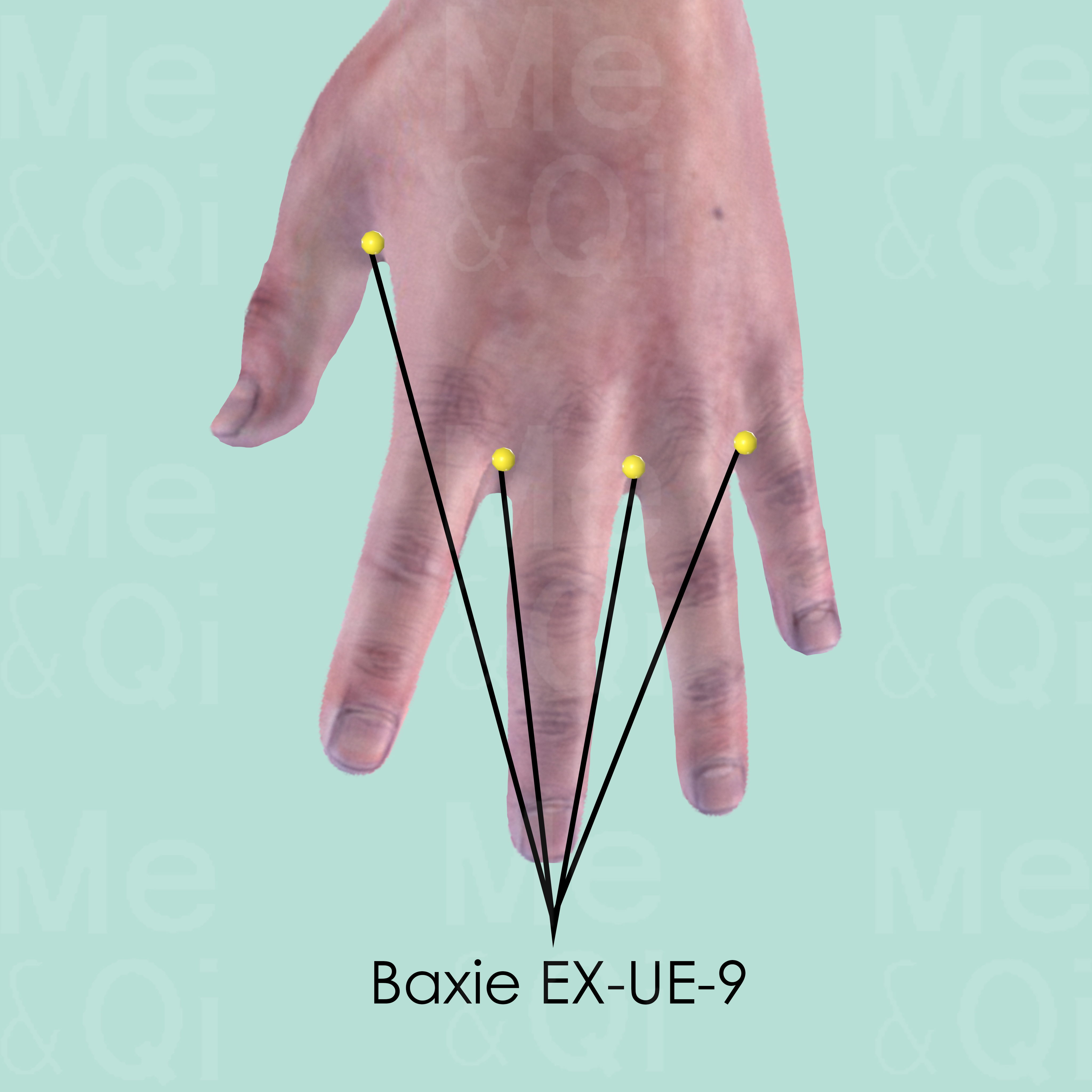
Baxie EX-UE-9
This is a group of 8 points in both hand, 4 points per each hand. Slightly proximal to the margins of the webs between the fingers, on the border of the red and white skin.
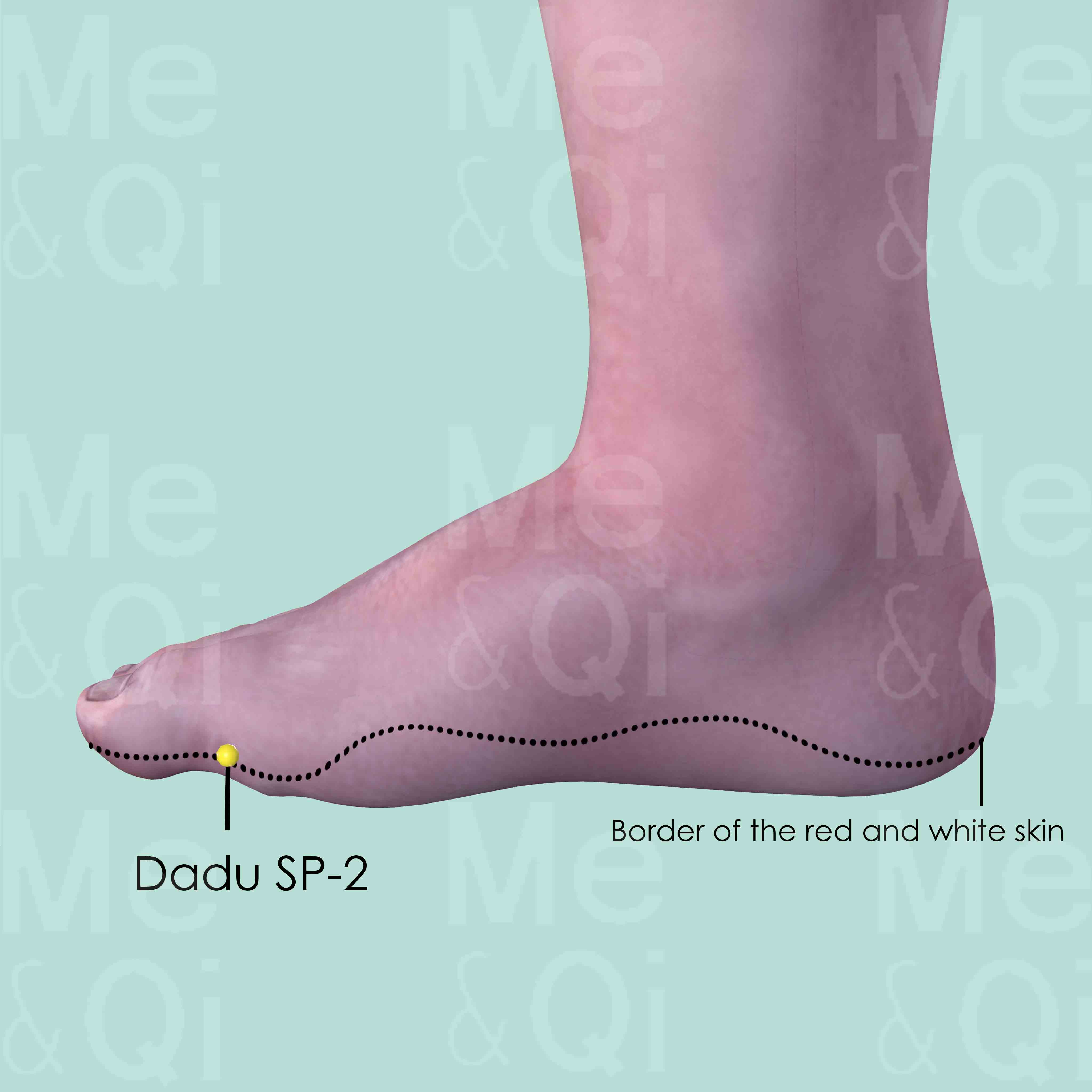
Dadu SP-2
On the medial aspect of the big toe, at the junction of the shaft and the base of the proximal phalanx, distal to the 1st metatarsophalangeal joint.
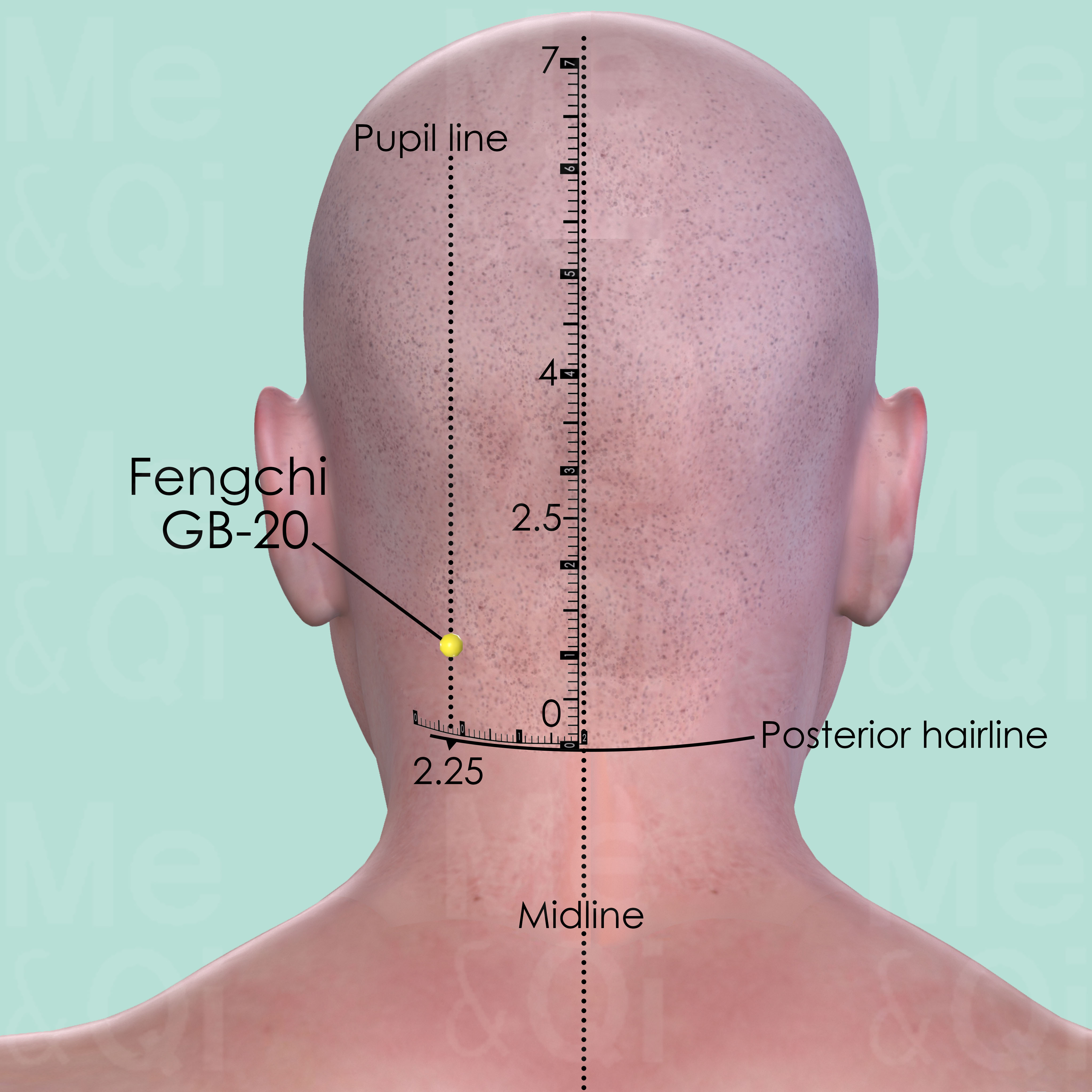
Fengchi GB-20
In the posterior aspect of the neck, below the occipital bone, in the depression between the upper portion of sternocleidomastoid and trapezius muscle.

